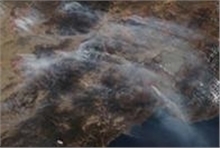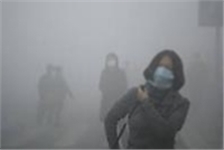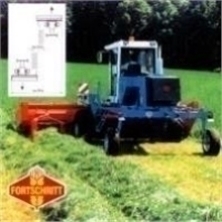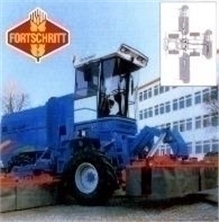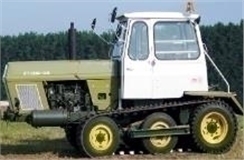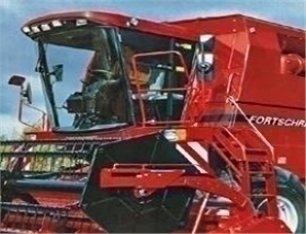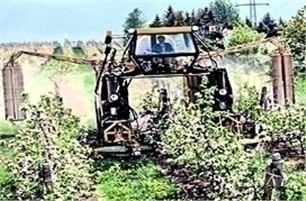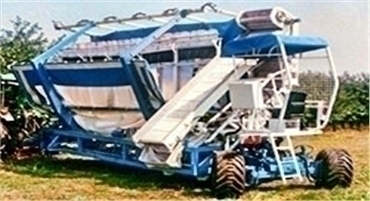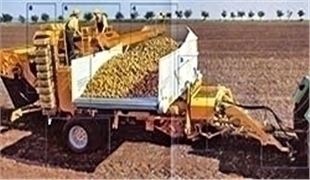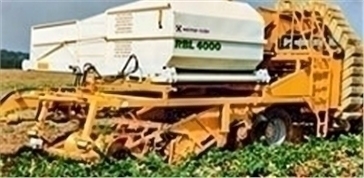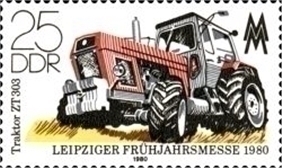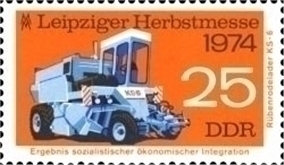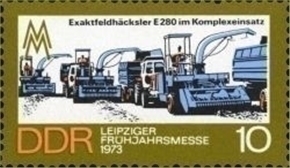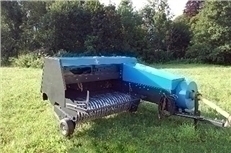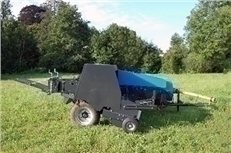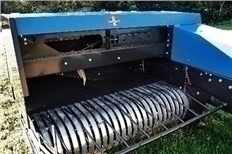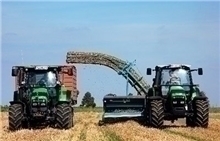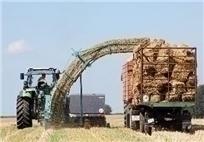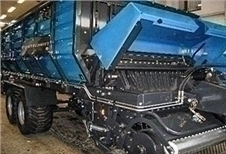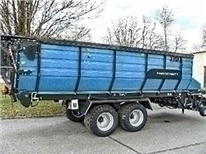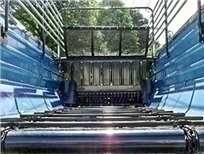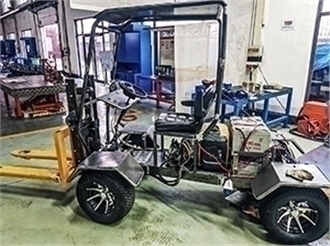UNITED STATES
SECURITIES AND EXCHANGE COMMISSION
WASHINGTON, D.C. 20549
FORM F-1
(Amendment No. 2)
REGISTRATION STATEMENT UNDER THE SECURITIES ACT OF 1933

INDUSTRIAL TECHNICAL HOLDINGS CORPORATION |
(Exact name of registrant as specified in its charter) |
BRITISH VIRGIN ISLANDS | | 3523 | | N/A |
(State or other jurisdiction of incorporation or organization) | | (Primary Standard Industrial Classification Code Number) | | (IRS Employer Identification Number) |
Huanxiu Street Office
Shuanglong Industrial Park,
266201 Jimo, Qingdao
China
Telephone: +86(0)532-89657397-0
(Address of principal executive offices, including zip code, and telephone number, including area code)
Belmont Trust Limited
P.O. Box 3443
Road Town
Tortola, VG1110
British Virgin Islands
Telephone: (284) 494-5800
(Name, address, including zip code, and telephone number, including area code, of agent of service)
COPY TO:
Andrew J. Befumo, Esq.
andrew@befumolaw.com
Befumo & Schaeffer, PLLC
1629 K St., NW Suite 300
Washington, DC 20006
Telephone: (202) 669-0619
Approximate date of commencement of the proposed sale to the public: As soon as practicable after this Registration Statement becomes effective.
If any of the securities being registered on this Form are to be offered on a delayed or continuous basis pursuant to Rule 415 under the Securities Act of 1933, check the following box. ¨
If this Form is filed to register additional securities for an offering pursuant to Rule 462(b) under the Securities Act of 1933, check the following box and list the Securities Act registration statement number of the earlier effective registration statement for the same offering. ¨
If this Form is a post-effective amendment filed pursuant to Rule 462(c) under the Securities Act of 1933, check the following box and list the Securities Act registration statement number of the earlier effective registration statement for the same offering. ¨
Indicate by check mark whether the registrant is a large accelerated filer, an accelerated filer, a non-accelerated filer, or a smaller reporting company. See definitions of “large accelerated filer,” “accelerated filer,” “smaller reporting company” and “emerging growth company” as set forth in Rule 12b-2 of the Exchange Act (Check one):
Large accelerated filer | ¨ | Accelerated filer | ¨ |
Non-accelerated filer | ¨ | Smaller reporting company | x |
| | Emerging growth company | x |
If an emerging growth company that prepared its consolidated financial statements in accordance with U.S. GAAP, indicate by check mark if the registrant has elected not to use the extended transition period for complying with any new or revised financial accounting standards provided pursuant to Section 7(a)(2)(B) of the Securities Act. ¨
CALCULATION OF REGISTRATION FEE
Title of each class of securities to be registered | | Amount to be registered | | | Proposed maximum offering price per share | | | Proposed maximum aggregate offering price | | | Amount of registration fee | |
Ordinary Shares, no par value, being offered for resale by certain selling securityholders | | | 1,075,160 | | | $ | 5.00 | | | $ | 5,375,800 | | | $ | 697.78 | |
Totals | | | 1,075,160 | | | | | | | $ | 5,375,800 | * | | $ | 697.78 | |
* This Offering pertains to the resale of shares by selling securityholders only. The Registrant will receive no proceeds from this offering.
The Registrant hereby amends this Registration Statement on such date or dates as may be necessary to delay its effective date until the registrant shall file a further amendment which specifically states that this Registration Statement shall thereafter become effective in accordance with Section 8(a) of the Securities Act of 1933 or until this Registration Statement shall become effective on such date as the Securities and Exchange Commission, acting pursuant to said Section 8(a), may determine.
The information in this prospectus is not complete and may be changed. We may not sell these securities until the registration statement filed with the Securities and Exchange Commission is effective. This prospectus is not an offer to sell these securities and it is not soliciting an offer to buy these securities in any jurisdiction where the offer or sale is not permitted.
PROSPECTUS (SUBJECT TO COMPLETION) Dated ____, 2020
INDUSTRIAL TECHNICAL HOLDINGS CORPORATION
1,075,160 ORDINARY SHARES
This prospectus relates to the resale of up to 1,075,160 ordinary shares of our stock, from time to time, by the selling securityholders identified in this prospectus. The selling security holders will offer and sell the ordinary shares of outstanding stock at an initial price of $5.00 per share until our ordinary shares are quoted on a national securities exchange, and thereafter at prevailing market prices, at varying prices determined at the time of sale, or at negotiated prices. No cash will be received by us from the sale of ordinary shares of stock by the selling securityholders. We will incur all costs associated with this prospectus.
We have no class of securities registered under the Securities Exchange Act of 1934, as amended, and none of our securities are traded on any stock exchange or stock quotation system in the United States. While we intend to seek a market maker to file an application with the Financial Industry Regulatory Authority to receive a stock symbol in order for such market maker to post a bid and ask on a national securities exchange, we do not currently have a market maker willing to post quotations for our ordinary shares, and there can be no assurance that an active trading market for our shares will develop, or if developed, that it will be sustained; therefore listing approval in major stock exchange is remote.
We are an “emerging growth company” as defined in section 3(a) of the Securities Exchange Act of 1934, as amended (the “Exchange Act”), and are therefore eligible for certain exemptions from various reporting requirements applicable to reporting companies under the Exchange Act. (See “Exemptions Under the Jumpstart Our Business Startups Act” on page 29.)
In reviewing this prospectus, you should carefully consider the matters described under the caption “Risk Factors” beginning on page 8.
This investment involves a high degree of risk. You should purchase shares only if you can afford a complete loss.
Neither the Securities and Exchange Commission nor any state securities commission has approved or disapproved of these securities or determined if this prospectus is truthful or complete. Any representation to the contrary is a criminal offense.
This prospectus shall not constitute an offer to sell or the solicitation of any offer to buy, nor shall the selling security holders sell any of these securities in any state where such an offer to sell or solicitation would be unlawful before registration or qualification under such state’s securities laws.
Until ______, all dealers that effect transactions in these securities, whether or not participating in this offering, may be required to deliver a prospectus. This is in addition to the dealers' obligation to deliver a prospectus when acting as underwriters and with respect to their unsold allotments or subscriptions.
TABLE OF CONTENTS
PROSPECTUS SUMMARY
The following summary highlights, and should be read in conjunction with, the more detailed information contained elsewhere in this prospectus. You should read carefully the entire document, including our combined consolidated financial statements and related notes, to understand our business, our ordinary shares and the other considerations that are important to your decision to invest in our ordinary shares. You should pay special attention to the “Risk Factors” section beginning on page 74.
INDUSTRIAL TECHNICAL HOLDINGS CORPORATION (“ITHC” also the “Registrant” the “Company” “us” “we” and “our”) was incorporated on February 22, 2018, under the laws of the British Virgin Islands. ITHC owns 100% of Industrial Technical Corporation, Ltd. (HK) (“ITC-HK”). ITC-HK is a holding company based in Hong Kong which conducts operations through subsidiaries as follows :
(i) ITC-HK owns 100% of Qingdao CSSC Co. Ltd. (“CSSC”); a manufacturer of machinery components based in mainland China. CSSC specializes in the design and engineering of the precision parts of agricultural equipment and machinery; and
(ii) ITC-HK owns 100% of Fortschritt China Agritech Co. Ltd. (“Fortschritt HK”) ; a holding company based in Hong Kong; and
(iii) Fortschritt HK owns 100% of Qingdao Fortschritt China Agritech Co. Ltd (“Fortschritt” also “Fortschritt China”); a manufacturer of modern agricultural machinery . While Forschritt has no sales to date, it currently produces two models of high-density baler machines, with approximately two hundred in various stages of production. The company also has completed prototypes for several other agricultural machines; and
(iv) CSSC owns 50% of PlanET LTD Qingdao (“PlanET” also “PlanET China”); a joint venture with a leading German company in the area of engineering and building green energy biogas plants. PlanET has no sales to date.
The Company’s corporate structure is shown in the below diagram:
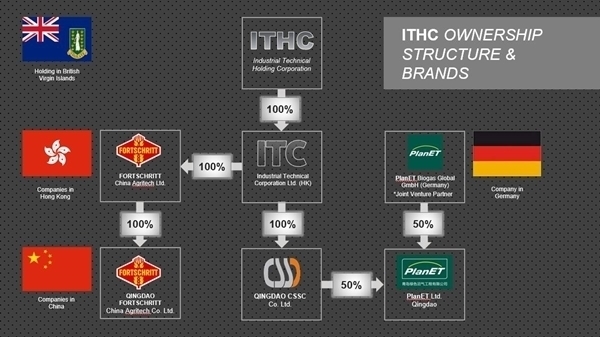
Our operations began in 2004 with the founding of CSSC. CSSC produces agricultural machinery parts for the German market as well as for Fortschritt and PlanET. To date we have not sold any products through our Fortschritt or PlanET subsidiaries.
Due to China’s largely unmechanized agricultural industry, agricultural waste products (primarily straw) have typically been burned rather than baled for other uses. In 2015, as pollution levels from burning post-agricultural straw peaked in China, CSSC developed a potential solution to significantly reduce burning straw and instead convert the straw into green energy.
CSSC’s proposed solution to the pollution problem resulted in the Company’s expansion into the Fortschritt brand, to produce highly efficient state-of-the-art machinery for the mechanization of Chinese agriculture, and PlanET to process agricultural waste products into usable energy products.
The Company’s plan, as discussed in greater detail in this prospectus under the heading Our Company, is to leverage the synergies of its three brands, Fortschritt, CSSC and PlanET to become a leader in green agriculture both within China and worldwide.
Our principal executive offices are located at Huanxiu Street Office, Shuanglong Industrial Park, 266201 Jimo, Qingdao, China. Our telephone number is +86(0)532-89657397-0. Our website address is http://www.itc-group.biz. Information on our subsidiaries you can find here:
SUBSIDIARY | FIELD OF ACTIVITY | WEBSITE |
CSSC | MACHINERY COMPONENTS | http://www.cssctp.com |
Fortschritt | AGRICULTURAL MACHINERY | http://www.fortschritt.cn |
PlanET | GREEN ENERGY – BIOGAS PLANTS FOR AGRICULTURE | http://www.planet-biogas.com |
We are not a reporting issuer under any securities legislation and our securities are not listed or posted for trading on any securities exchange or stock quotation system.
OFFERING SUMMARY
The Issuer: | Industrial Technical Holdings Corporation |
| |
The Selling Security Holders: | The selling security holders (each a “Selling Security Holder”) are comprised of the holders of the ordinary shares (the “Shares”) which were issued pursuant to private placements on various dates from February 2018 through June 2019. |
| |
Shares Offered by the Selling Security Holders: | The Selling Security Holders are offering up to an aggregate of 1,075,160 ordinary shares of our stock. |
| |
Offering Price: | The selling security holders will offer and sell the ordinary shares of outstanding stock at an initial price of $5.00 per share until our ordinary shares are quoted on a national securities exchange, and thereafter at prevailing market prices, at varying prices determined at the time of sale, or at negotiated prices. No cash will be received by us from the sale of ordinary shares of stock by the selling securityholders. If the shares are sold through underwriters or broker-dealers, the Selling Security Holders will be responsible for underwriting discounts or commissions or agent’s commissions. |
| |
Use of Proceeds: | We will not receive any of the proceeds from the sale of 1,075,160 ordinary previously-issued-shares of stock by the Selling Security Holders. We will, however, incur all costs associated with this registration statement and prospectus. |
| |
The market for our Ordinary Shares: | Our ordinary shares are not listed or posted for trading on any securities exchange or stock quotation system. |
| |
Outstanding Ordinary Shares of Stock: | There are 3,373,760 ordinary shares of stock outstanding as of January 10, 2020. |
| |
Risk Factors: | See “Risk Factors” and the other information in this prospectus for a discussion of the factors you should consider before deciding to invest in our securities. |
SUMMARY FINANCIAL DATA
The summary financial information set forth below has been derived from the consolidated financial statements of Industrial Technical Holdings Corporation for the period from January 1, 2017, to December 31, 2018, and for the six-month period ended June 30, 2019. You should read the following summary financial data together with our audited consolidated financial statements and the notes thereto included elsewhere in this prospectus.
STATEMENT OF OPERATIONS |
|
| | Six Months Ended, June 30 | | | Year Ended December 31 | |
| | 2019 | | | 2018 | | | 2018 | | | 2017 | |
Revenues | | | 2,280,798 | | | | 2,757,474 | | | | 6,182,801 | | | | 5,851,546 | |
Gross Margin | | | 478,344 | | | | 731,253 | | | | 1,439,347 | | | | 1,417,066 | |
Net Loss | | | 377,986 | | | | 217,328 | | | | 635,275 | | | | 579,629 | |
BALANCE SHEET |
|
| | June 30, 2019 | | | December 31, 2018 | | | December 31, 2017 | |
Cash | | | 261,285 | | | | 608,001 | | | | 124,152 | |
Current Assets | | | 3,102,893 | | | | 3,535,232 | | | | 2,981,252 | |
Total Assets | | | 3,751,450 | | | | 4,252,721 | | | | 3,936,676 | |
Current Liabilities | | | 2,825,891 | | | | 3,131,078 | | | | 3,570,959 | |
Total Liabilities | | | 2,825,891 | | | | 3,131,078 | | | | 3,570,959 | |
Shareholders’ Equity (Deficiency) | | | 925,559 | | | | 1,121,643 | | | | 365,717 | |
RISK FACTORS
An investment in our shares of common stock carries a significant degree of risk. You should carefully consider the following risks, as well as the other information contained in this prospectus, including our consolidated financial statements and related notes, included elsewhere in this prospectus before you decide to purchase our shares. Any one of these risks and uncertainties has the potential to cause material adverse effects on our business, prospects, financial condition and operating results which could cause actual results to differ materially from any forward-looking statements expressed by us and a significant decrease in the value of our common stock. Refer to “Forward-Looking Statements”.
There is no assurance that we will be successful in preventing the material adverse effects that any of the following risks and uncertainties may cause, or that these potential risks and uncertainties are a complete list of the risks and uncertainties facing us. Furthermore, there may be additional risks and uncertainties that we are presently unaware of, or presently consider immaterial, that may become material in the future and have a material adverse effect on us. You could lose all or a significant portion of your investment due to any of these risks and uncertainties.
RISKS RELATING TO OUR BUSINESS
We will need a significant amount of capital to carry out our proposed business plan, and a failure to raise sufficient funds will have a material adverse effect on our operations.
In order to carry out our proposed business plan, we will require a significant amount of capital. We estimate that we will need approximately $10 million to finance our planned operations for the next 12 months.
We intend to raise our cash requirements for the next 12 months through the sale of our equity securities in private placements, through shareholder loans or possibly through a registered public offering (either self-underwritten or through a broker-dealer). If we are unsuccessful in raising enough money through such capital-raising efforts, we may review other financing possibilities such as bank loans. At this time we do not commit any broker-dealer to provide us with financing. There is no assurance that any financing will be available to us or if available, on terms that will be acceptable to us. We also may negotiate with our management and consultants to pay parts of their salaries and fees with stock and stock options instead of cash.
Our ability to obtain the necessary financing to carry out our business plan is subject to several factors, including general market conditions and investor acceptance of our business plan. These factors may make the timing, amount, terms and conditions of such financing unattractive or unavailable to us. If we are unable to raise sufficient funds, we will have to significantly reduce our spending, delay or cancel our planned activities or substantially change our current corporate structure. There is no guarantee that we will be able to obtain any funding or that we will have sufficient resources to conduct our business as projected, any of which may have an adverse material effect on our operations.
Our revenue and net income may be materially and adversely affected by any economic slowdown in China. The PRC government has in recent years implemented several measures to control the rate of economic growth, including by raising interest rates and adjusting deposit reserve ratios for commercial banks as well as by implementing other measures designed to tighten credit and liquidity. These measures have contributed to a slowdown of the PRC economy. According to the National Bureau of Statistics of China, China’s GDP growth rate was 6.7% in 2016. Any continuing or worsening slowdown could significantly reduce domestic commerce in China, including through the Internet generally and within our ecosystem. An economic downturn, whether actual or perceived, a further decrease in economic growth rates or an otherwise uncertain economic outlook in China or any other market in which we may operate could have a material adverse effect on our business, financial condition and results of operations.
Damage claims against our products could reduce our sales and revenues. If any of our products are found to cause injury or damage, the Company could suffer financial damages. We have not had significant claims for damages or losses from our products to date. The Company does not carry product liability insurance. Any claims for damages related to the products we sell could damage our reputation and reduce our revenues.
Disruption to our supply chain of parts needed for constructing our products could negatively affect our sales. The Company has not yet experienced significant problems in obtaining parts from suppliers required for constructing its products. However, there is no guarantee that some of the current suppliers may not be able to continue to provide parts needed for constructing our products from our current suppliers. We have no written agreements with any of our suppliers and order these parts from different manufacturers on a purchase order basis. If the manufactured parts do not meet the quality standard, the parts are not accepted by us. This could cause a shortage of those parts in inventory resulting in backorders and even cancellations of orders. Sales of existing products in inventory may not be sufficient to use all stock on hand before we can obtain replacement parts from other suppliers. This could reduce or eliminate our revenues.
Growth of our business will partially depend on the recognition of our Fortschritt brand, and any failure to maintain, protect and enhance our brand would limit our ability to expand or retain our customer base, which would materially and adversely affect our business, financial condition and results of operations. We believe that the recognition of our brand among customers has helped us manage our customer acquisition costs and contributed to the growth and success of our business. Accordingly, maintaining, protecting and enhancing the recognition of our brand is critical to our business and market position. Many factors, some of which are beyond our control, are important to maintaining, protecting and enhancing our brand. These factors include but not limited to our ability to:
| · | maintain the quality and attractiveness of the products we offer; |
| | |
| · | develop and launch new products that satisfy our customers’ needs; |
| | |
| · | provide a superior customer experience; |
| | |
| · | increase brand awareness through marketing and brand promotion activities; |
| | |
| · | maintain a good relationship and retain favorable terms with our suppliers, service providers, and other business partners; |
| | |
| · | stay compliant with relevant laws and regulations; |
| | |
| · | compete effectively against existing and future competitors; and |
| | |
| · | preserve our reputation and goodwill generally and in the event of any negative publicity on our products, services, or other issues affecting us, China’s agricultural industry or China’s manufacturing sector in general. |
A public perception that we do not provide satisfactory products or services to customers, even if factually incorrect or based on isolated incidents, could damage our reputation, diminish the value of our brand, undermine the trust and credibility we have established and had a negative impact on our ability to attract and retain customers, and our business, financial condition and results of operations may be materially and adversely affected.
Overall tightening of the labor market, increases in labor costs or any possible labor unrest may adversely affect our business and results of operations. Our business requires a substantial number of workers, and any failure to retain stable and dedicated labor by us may lead to disruption to our business operations. Although we have not experienced any labor shortage to date, we have observed an overall tightening and increasingly competitive labor market. We have experienced, and expect to continue to experience, increases in labor costs due to increases in salary, social benefits, and employee headcount. We compete with other companies in our industry and other labor-intensive industries for labor, and we may not be able to offer competitive remuneration and benefits compared to them. If we are unable to manage and control our labor costs, our business, financial condition and results of operations may be materially and adversely affected.
If we fail to adopt new technologies to evolving customer needs or emerging industry standards, our business may be materially and adversely affected. To remain competitive, we must continue to stay abreast of the constantly evolving industry trends and to enhance and improve our technology accordingly. Our success will depend, in part, on our ability to identify, develop, acquire or license leading technologies useful in our business. There can be no assurance that we will be able to use new technologies effectively or adapt to meet customer requirements. If we are unable to adapt in a cost-effective and timely manner in response to changing market conditions or customer preferences, whether for technical, legal, financial or other reasons, our business may be materially and adversely affected.
We, our directors, management and employees may be subject to litigation and regulatory investigations and proceedings, such as claims relating to product safety, commercial, labor, employment, antitrust or securities matters, and may not always be successful in defending ourselves against such claims or proceedings. We face potential liability, expenses for legal claims and harm due to our business nature. For example, customers could assert legal claims against us in connection with personal injuries related use of our agricultural equipment. The PRC government, media outlets, and public advocacy groups have been increasingly focused on customer protection in recent years.
While we strive to maximize quality control, the selling of defective products may expose us to liabilities associated with customer protection laws. A manufacturer may be responsible for compensation on customer’s injury or loss even if such loss is not caused by the manufacturer. Thus, we may also be held liable if our suppliers, dealers or other business partners fail to comply with applicable rules and regulations. Though we can ask the responsible parties for indemnity, our reputation could still be adversely affected. In addition, our directors, management and employees may from time to time be subject to litigation and regulatory investigations and proceedings or otherwise face potential liability and expense in relation to commercial, labor, employment, antitrust, securities or other matters, which could adversely affect our reputation and results of operations.
After we become a publicly listed company, we may face additional exposure to claims and lawsuits. These claims could divert management time and attention away from our business and result in significant costs to investigate and defend, regardless of the merits of the claims. In some instances, we may elect or be forced to pay substantial damages if we are unsuccessful in our efforts to defend against these claims, which could harm our business, financial condition and results of operations.
We may be subject to intellectual property infringement claims, which may be expensive to defend and may disrupt our business. We cannot be certain that our operations or any aspects of our business do not or will not infringe upon or otherwise violate intellectual property rights held by third parties. We have not, but may in the future become, subject to legal proceedings and claims relating to the intellectual property rights of others. There could also be existing intellectual property of which we are not aware that our products may inadvertently infringe. We cannot assure you that holders of intellectual property purportedly relating to some aspect of our technology, products or business, if any such holders exist, would not seek to enforce such intellectual property against us in China, Europe, the United States or any other jurisdictions. If we are found to have violated the intellectual property rights of others, we may be subject to liability for our infringement activities or may be prohibited from using such intellectual property, and we may incur licensing fees or be forced to develop alternatives of our own. In addition, we may incur significant expenses, and may be forced to divert management’s time and other resources from our business and operations to defend against any such infringement claims, regardless of their merits. Successful infringement or licensing claims made against us may result in significant monetary liabilities and may materially disrupt our business and operations by restricting or prohibiting our use of the intellectual property in question, and our business, financial position and results of operations could be materially and adversely affected.
RISKS RELATING TO DOING BUSINESS IN CHINA
Changes in China’s economic, political or social conditions or government policies could have a material adverse effect on our business and operations.
Substantially all of our assets and operations are located in China. Accordingly, our business, financial condition, results of operations and prospects may be influenced to a significant degree by political, economic and social conditions in China generally. The Chinese economy differs from the economies of most developed countries in many respects, including the level of government involvement, level of development, growth rate, control of foreign exchange and allocation of resources. Although the Chinese government has implemented measures emphasizing the utilization of market forces for economic reform, the reduction of state ownership of productive assets, and the establishment of improved corporate governance in business enterprises, a substantial portion of productive assets in China is still owned by the government. In addition, the Chinese government continues to play a significant role in regulating industry development by imposing industrial policies. The Chinese government also exercises significant control over China’s economic growth through allocating resources, controlling the payment of foreign currency-denominated obligations, setting monetary policy and providing preferential treatment to particular industries or companies.
While the Chinese economy has experienced significant growth over the past decades, growth has been uneven, both geographically and among various sectors of the economy. Any adverse changes in economic conditions in China, in the policies of the Chinese government or in the laws and regulations in China could have a material adverse effect on the overall economic growth of China. Such developments could adversely affect our business and operating results, lead to a reduction in demand for our products and adversely affect our competitive position. The Chinese government has implemented various measures to encourage economic growth and guide the allocation of resources. While some of these measures may benefit the overall Chinese economy, they may have a negative effect on us. For example, our financial condition and results of operations may be adversely affected by government control over capital investments or changes in tax regulations. In addition, in the past the Chinese government has implemented certain measures, including interest rate adjustment, to control the pace of economic growth. These measures may cause decreased economic activity in China, which may adversely affect our business and operating results.
Uncertainties with respect to the PRC legal system could adversely affect us. The PRC legal system is a civil law system based on written statutes. Unlike the common law system, prior court decisions under the civil law system may be cited for reference but have limited precedential value.
In 1979, the PRC government began to promulgate a comprehensive system of laws and regulations governing economic matters in general. The overall effect of legislation since then has significantly enhanced the protections afforded to various forms of foreign investments in China. However, China has not developed a fully integrated legal system, and recently enacted laws and regulations may not sufficiently cover all aspects of economic activities in China. In particular, the interpretation and enforcement of these laws and regulations involve uncertainties. Since PRC administrative and court authorities have significant discretion in interpreting and implementing statutory provisions and contractual terms, it may be difficult to evaluate the outcome of administrative and court proceedings and the level of legal protection we enjoy. These uncertainties may affect our judgment on the relevance of legal requirements and our ability to enforce our contractual rights or tort claims. In addition, the regulatory uncertainties may be exploited through unmerited or frivolous legal actions or threats in attempts to extract payments or benefits from us.
Furthermore, the PRC legal system is based in part on government policies and internal rules, some of which are not published on a timely basis or at all and may have a retroactive effect. As a result, we may not be aware of our violation of any of these policies and rules until sometime after the violation. In addition, any administrative and court proceedings in China may be protracted, resulting in substantial costs and diversion of resources and management attention.
You may experience difficulties in effecting service of the legal process, enforcing foreign judgments or bringing actions in China against us or our management named in the prospectus based on foreign laws. We are a company incorporated under the laws of the British Virgin Islands, we conduct substantially all of our operations in China, and substantially all of our assets are located in China. As a result, it may be difficult for our shareholders to effect service of process upon us or those persons inside China. In addition, China does not have treaties providing for the reciprocal recognition and enforcement of judgments of courts with the British Virgin Islands and many other countries and regions. Therefore, recognition and enforcement in China of judgments of a court in any of these non-PRC jurisdictions in relation to any matter not subject to a binding arbitration provision may be difficult or impossible.
Our employment practices may be adversely impacted by the labor contract law of the PRC. The PRC National People’s Congress promulgated the Labor Contract Law which became effective on January 1, 2008, and was amended on December 28, 2012, and the State Council promulgated implementing rules for the labor contract law on September 18, 2008. The labor contract law and the implementing rules impose requirements concerning, among others, the execution of written contracts between employers and employees, the time limits for probationary periods, and the length of employment contracts. The interpretation and implementation of these regulations are still evolving, our employment practices may violate the labor contract law and related regulations and we could be subject to penalties, fines or legal fees as a result. If we are subject to severe penalties or incur significant legal fees in connection with labor law disputes or investigations, our business, financial condition and results of operations may be adversely affected.
Fluctuations in exchange rates could have a material and adverse effect on our results of operations and the value of your investment. The value of the Renminbi against the U.S. dollar and other currencies may fluctuate and is affected by, among other things, changes in political and economic conditions and the foreign exchange policy adopted by the PRC government. It is difficult to predict how long such depreciation of RMB against the U.S. dollar may last and when and how the relationship between the RMB and the U.S. dollar may change again. Much of our revenues and costs are denominated in Renminbi. a significant revaluation of Renminbi may materially and adversely affect our results of operations and financial position reported in Renminbi when translated into U.S. dollars, and the value of and any dividends payable on our Shares in U.S. dollars. To the extent that we need to convert U.S. dollars into Renminbi for our operations, appreciation of the Renminbi against the U.S. dollar would have an adverse effect on the Renminbi amount we would receive. Conversely, if we decide to convert our Renminbi into U.S. dollars to make payments for dividends on our Shares or other business purposes, appreciation of the U.S. dollar against the Renminbi would have a negative effect on the U.S. dollar amount.
Regulation and censorship of information disseminated over the internet in China may adversely affect our business and reputation and subject us to liability for information displayed on our website. The PRC government has adopted regulations governing internet access and the distribution of news and other information over the internet. Under these regulations, internet content providers and internet publishers are prohibited from posting or displaying over the internet content that, among other things, violates PRC laws and regulations, impairs the national dignity of China, or is reactionary, obscene, superstitious, fraudulent or defamatory. Failure to comply with these requirements may result in the revocation of licenses to provide internet content and other licenses, and the closure of the concerned websites. The website operator may also be held liable for such censored information displayed on or linked to the websites. If our website is found to be in violation of any such requirements, we may be penalized by relevant authorities, and our operations or reputation could be adversely affected.
The audit report included in this prospectus is prepared by an auditor who is not inspected by the Public Company Accounting Oversight Board and, as such, our investors are deprived of the benefits of such inspection. Our independent registered public accounting firm that issues the audit report included in our prospectus filed with the SEC, as auditors of companies that are traded publicly in the U.S. and a firm registered with the U.S. Public Company Accounting Oversight Board, or the PCAOB, is required by the laws of the U.S. to undergo regular inspections by the PCAOB to assess its compliance with the laws of the U.S. and professional standards. Because our auditors are located in the People’s Republic of China, a jurisdiction where the PCAOB is currently unable to conduct inspections without the approval of the Chinese authorities, our auditors, as well as all other firms located in the PRC, are not currently inspected by the PCAOB.
Inspections of other firms that the PCAOB has conducted outside China have identified deficiencies in those firms’ audit procedures and quality control procedures, which may be addressed as part of the inspection process to improve future audit quality. This lack of PCAOB inspections in China prevents the PCAOB from regularly evaluating our auditor’s audits and its quality control procedures. As a result, investors may be deprived of the benefits of PCAOB inspections.
The inability of the PCAOB to conduct inspections of auditors in China makes it more difficult to evaluate the effectiveness of our auditor’s audit procedures or quality control procedures as compared to auditors outside of China that are subject to PCAOB inspections. Investors may lose confidence in our reported financial information and procedures and the quality of our consolidated financial statements.
We may be classified as a “resident enterprise” for PRC enterprise income tax purposes, which could result in unfavorable tax consequences to us and our non-PRC shareholders. The EIT Law provides that enterprises established outside of the PRC whose “de facto management bodies” are located in the PRC are considered “resident enterprises” and are generally subject to the uniform 25% enterprise income tax rate on their worldwide income. In addition, a circular issued by the State Administration of Taxation on April 22, 2009 regarding the standards used to classify certain Chinese-invested enterprises controlled by Chinese enterprises or Chinese group enterprises and established outside of the PRC as “resident enterprises” clarified that dividends and other income paid by such “resident enterprises” will be considered to be PRC source income, subject to PRC withholding tax, currently at a rate of 10%, when recognized by non-PRC enterprise shareholders. This circular also subjects such “resident enterprises” to various reporting requirements with the PRC tax authorities. Under the implementation regulations to the enterprise income tax, a “de facto management body” is defined as a body that has material and overall management and control over the manufacturing and business operations, personnel and human resources, finances and properties of an enterprise. In addition, the circular mentioned above sets out criteria for determining whether “de facto management bodies” are located in the PRC for overseas incorporated, domestically controlled enterprises. However, as this circular only applies to enterprises established outside of the PRC that are controlled by PRC enterprises or groups of PRC enterprises, it remains unclear how the tax authorities will determine the location of “de facto management bodies” for overseas incorporated enterprises that are controlled by individual PRC residents like us and some of our subsidiaries. Therefore, although substantially all of our management is currently located in the PRC, it remains unclear whether the PRC tax authorities would require or permit our overseas registered entities to be treated as PRC resident enterprises. We do not currently consider our company to be a PRC resident enterprise. However, if the PRC tax authorities disagree with our assessment and determine that we are a “resident enterprise” we may be subject to enterprise income tax at a rate of 25% on our worldwide income and dividends paid by us to our non-PRC shareholders as well as capital gains recognized by them with respect to the sale of the ADSs may be subject to a PRC withholding tax.
This will have an impact on our effective tax rate, a material adverse effect on our net income and results of operations, and may require us to withhold tax on our non-PRC shareholders.
We are subject to PRC laws governing the industry in which we operate. If we are found to have failed to comp ly with applicable laws, we may incur additional expenditures or be subject to significant fines and penalties, which would have a material adverse effect on our business and operations. Our operations are subject to PRC laws and regulations applicable to us. However, the scope of many PRC laws and regulations are uncertain, and their implementation could differ significantly in different localities. In certain instances, local rules and their implementation are not necessarily consistent with the regulations at the higher or national level. Although we strive to comply with all applicable PRC laws and regulations, the relevant PRC government authorities may decide that we have not been in compliance with certain laws or regulations.
If the Chinese government determines that the corporate structure through which we control our PRC subsidiaries does not comply with applicable regulations, our business would be adversely affected.
There are uncertainties regarding the interpretation and application of PRC laws, rules and regulations, including but not limited to the laws, rules and regulations governing the validity of our corporate structure and control of our operating PRC subsidiaries. Although we have been advised by our PRC counsel, Shangdong Huasai Law Firm that based on their understanding of the current PRC laws, rules and regulations, our corporate structure complies with all applicable PRC laws, rules and regulations, we cannot assure you that the PRC regulatory authorities will not determine that our corporate structure or operations violate PRC laws, rules or regulations. The Chinese government has broad discretion in dealing with violations of laws and regulations, including levying fines, revoking business and other licenses and requiring actions necessary for compliance. In particular, licenses and permits issued or granted to us by relevant governmental bodies may be revoked at a later time by higher regulatory bodies.
In addition, new PRC laws, rules and regulations may be introduced from time to time to impose additional requirements that may be applicable to us, our business and operations.
We cannot predict the effect of the interpretation of existing or new Chinese laws or regulations on our businesses. We cannot assure you that our current ownership and operating structure would not be found in violation of any current or future Chinese laws or regulations. As a result, we may be subject to sanctions, including fines, and could be required to restructure our operations or cease certain of our operations. Any of these or similar actions could significantly disrupt our business operations or restrict us from conducting a substantial portion of our business operations, which could materially and adversely affect our business, financial condition and results of operations.
If we are determined to be in violation of any existing or future PRC laws, rules or regulations or fail to obtain or maintain any of the required governmental permits or approvals, the relevant PRC regulatory authorities would have broad discretion in dealing with such violations, including:
| · | revoking the business and operating licenses of CSSC, Fortschritt, and PlanET; |
| | |
| · | discontinuing or restricting the operations of CSSC, Fortschritt, and PlanET ; |
| | |
| · | imposing conditions or requirements with which we may not be able to comply; |
| | |
| · | requiring us to restructure the relevant ownership structure or operations; |
| | |
| · | restricting or prohibiting our use of the proceeds from our offerings to finance our businesses and operations in China; or |
| | |
| · | imposing fines or other forms of economic penalties. |
The imposition of any of these penalties would have a material adverse effect on our financial condition, results of operations and prospects.
RISKS RELATING TO OUR ORDINARY SHARES OF STOCK
There is no public market for our ordinary shares and you may not be able to resell our ordinary shares at or above the price you paid, or at all. There is currently no public market for our ordinary shares. We cannot assure you that our ordinary shares will ever be qualified for public resale, or if qualified, that an active public market for our ordinary shares will develop. If there is no public market for our ordinary shares, you may lose some or all of your investment.
The continued sale of our equity securities will dilute the ownership percentage of our existing stockholders. The Board of Directors has the authority to issue additional shares of our capital stock to provide additional financing in the future and the issuance of any such shares may result in a reduction of the book value or market price, if one exists at the time, of the outstanding ordinary shares. If we do issue any such additional ordinary shares, such issuance also will cause a reduction in the proportionate ownership and voting power of all other stockholders. As a result of such dilution, if you acquire ordinary shares, your proportionate ownership interest and voting power could be decreased.
FINRA sales practice requirements may limit your ability to buy and sell our ordinary shares, which could depress the price of our shares. FINRA rules require broker-dealers to have reasonable grounds for believing that an investment is suitable for a customer before recommending that investment to the customer. Prior to recommending speculative low-priced securities to their non-institutional customers, broker-dealers must make reasonable efforts to obtain information about the customer’s financial status, tax status, and investment objectives, among other things. Under interpretations of these rules, FINRA believes that there is a high probability such speculative low-priced securities will not be suitable for at least some customers. Thus, FINRA requirements may make it more difficult for broker-dealers to recommend that their customers buy our ordinary shares, which may limit your ability to buy and sell our shares, have an adverse effect on the market for our shares and, thereby, depress our share price.
We are a “foreign private issuer,” and our disclosure obligations differ from those of U.S. domestic reporting companies. As a result, we may not provide you the same information as U.S. domestic reporting companies or we may provide information at different times, which may make it more difficult for you to evaluate our performance and prospects. We are a foreign private issuer and, as a result, we are not subject to the same requirements as U.S. domestic issuers. Under the Exchange Act, we will be subject to reporting obligations that, to some extent, are more lenient and less frequent than those of U.S. domestic reporting companies. For example, we will not be required to issue quarterly reports or proxy statements. We will not be required to disclose detailed individual executive compensation information. Furthermore, our directors and executive officers will not be required to report equity holdings under Section 16 of the Exchange Act and will not be subject to the insider short-swing profit disclosure and recovery regime. As a foreign private issuer, we will also be exempt from the requirements of Regulation FD (Fair Disclosure) which, generally, are meant to ensure that select groups of investors are not privy to specific information about an issuer before other investors. However, we will still be subject to the anti-fraud and anti-manipulation rules of the SEC, such as Rule 10b-5 under the Exchange Act. Since many of the disclosure obligations imposed on us as a foreign private issuer differs from those imposed on U.S. domestic reporting companies, you should not expect to receive the same information about us and at the same time as the information provided by U.S. domestic reporting companies.
We will incur increased costs and become subject to additional regulations and requirements as a result of becoming a newly public company, and our management will be required to devote substantial time to new compliance matters, which could lower our profits or make it more difficult to run our business. If we become a public company as planned, we will incur significant legal, accounting and other expenses that we have not incurred as a private company, including costs associated with public company reporting requirements and costs of recruiting and retaining non-executive directors. We also have incurred and will incur costs associated with rules implemented by the Securities and Exchange Commission, or the SEC, as well as any exchange or listing platformon which our securities may be quoted. The expenses incurred by public companies generally for reporting and corporate governance purposes have been increasing. We expect these rules and regulations to increase our legal and financial compliance costs and to make some activities more time-consuming and costly, although we are currently unable to estimate these costs with any degree of certainty. Our management will need to devote a substantial amount of time to ensure that we comply with all of these requirements. These laws and regulations also could make it more difficult or costly for us to obtain certain types of insurance, including director and officer liability insurance, and we may be forced to accept reduced policy limits and coverage or incur substantially higher costs to obtain the same or similar coverage. These laws and regulations could also make it more difficult for us to attract and retain qualified persons to serve on our Board of Directors, our board committees or as our executive officers. Furthermore, if we are unable to satisfy our obligations as a public company, we could be subject to delisting of our ordinary shares, fines, sanctions, and other regulatory action and potentially civil litigation.
Our Articles of Association provide that any Shareholder receiving a certificate shall indemnify and hold the Company and its directors and officers harmless from any loss or liability which it or they may incur by reason of any wrongful or fraudulent use or representation made by any person by virtue of the possession thereof. In the event a shareholder’s certificate is the subject of a fraudulent transfer or transaction, the shareholder may lose some or all of his investment.
The market price of common shares may be volatile, which could cause the value of your investment to decline. Even if a trading market develops, the market price of our ordinary shares may be highly volatile and could be subject to wide fluctuations. Securities markets worldwide experience significant price and volume fluctuations. This market volatility, as well as general economic, market or political conditions, could reduce the market price of our ordinary shares in spite of our operating performance. In addition, our results of operations could be below the expectations of public market analysts and investors due to a number of potential factors, including variations in our quarterly results of operations, additions or departures of key management personnel, failure to meet analysts’ earnings estimates, publication of research reports about our industry, litigation and government investigations, changes or proposed changes in laws or regulations or differing interpretations or enforcement thereof affecting our business, adverse market reaction to any indebtedness we may incur or securities we may issue in the future, changes in market valuations of similar companies or speculation in the press or investment community, announcements by our competitors of significant contracts, acquisitions, dispositions, strategic partnerships, joint ventures or capital commitments, adverse publicity about our industry in or individual scandals, and in response the market price of our ordinary shares could decrease significantly. You may be unable to resell your ordinary shares of at or above the initial public offering price. In the past few years, stock markets have experienced extreme price and volume fluctuations. In the past, following periods of volatility in the overall market and the market price of a company’s securities, securities class action litigation has often been instituted against these companies. This litigation, if instituted against us, could result in substantial costs and a diversion of our management’s attention and resources, or at all.
RISKS RELATING TO TAXATION
There are significant uncertainties under the PRC Enterprise Income Tax Law relating to the withholdin g tax liabilities of our PRC subsidiaries, and dividends payable by our PRC subsidiaries to our offshore subsidiaries may not qualified to enjoy certain treaty benefits. Under the PRC Enterprise Income Tax Law and its implementation rules, the profits of a foreign-invested enterprise generated through operations, which are distributed to its immediate holding company outside China, will be subject to a withholding tax rate of 10%. Pursuant to a special arrangement between Hong Kong and China, such rate may be reduced to 5% if a Hong Kong resident enterprise owns more than 25% of the equity interest in the PRC company. Our current PRC subsidiaries are wholly owned by our Hong Kong subsidiary. Accordingly, Industrial Technical Corporation, Ltd. (HK) may qualify for a 5% tax rate in respect of distributions from our PRC subsidiaries. Under the Notice of the State Administration of Taxation (“SAT”) on Issues regarding the Administration of the Dividend Provision in Tax Treaties promulgated in 2009, the taxpayer needs to satisfy certain conditions to enjoy the benefits under a tax treaty. These conditions include: (i) the taxpayer must be the beneficial owner of the relevant dividends, and (ii) the corporate shareholder to receive dividends from the PRC subsidiaries must have met the direct ownership thresholds during the 12 consecutive months preceding the receipt of the dividends. Further, the SAT promulgated the Notice on How to Understand and Recognize the “Beneficial Owner” in Tax Treaties in 2009, which limits the “beneficial owner” to individuals, enterprises or other organizations normally engaged in substantive operations, and sets forth certain detailed factors in determining “beneficial owner” status.
Entitlement to a lower tax rate on dividends according to tax treaties or arrangements between the PRC central government and governments of other countries or regions is subject to the Administrative Measures for Non-Resident Taxpayers to Enjoy Treatments under Tax Treaties, which provides that non-resident enterprises are not required to obtain pre-approval from the relevant tax authority in order to enjoy the reduced withholding tax. Instead, non-resident enterprises and their withholding agents may, by self-assessment and on confirmation that the prescribed criteria to enjoy the tax treaty benefits are met, directly apply the reduced withholding tax rate, and file necessary forms and supporting documents when performing tax filings, which will be subject to post-tax filing examinations by the relevant tax authorities. As a result, we cannot assure you that we will be entitled to any preferential withholding tax rate under treaties for dividends received from our PRC subsidiaries.
If we are classified as a PRC residen t enterprise for PRC enterprise income tax purposes, such classification could result in unfavorable tax consequences to us and our non-PRC shareholders. Under the PRC Enterprise Income Tax Law and its implementation rules, an enterprise established outside of the PRC with its “de facto management body” within the PRC is considered a “resident enterprise” and will be subject to the enterprise income tax on its global income at the rate of 25%. The implementation rules define the term “de facto management body” as the body that exercises full and substantial control and overall management over the business, productions, personnel, accounts and properties of an enterprise. In 2009, the SAT issued a circular, known as SAT Circular 82, partially abolished on December 29, 2017, which provides certain specific criteria for determining whether the “de facto management body” of a PRC-controlled enterprise that is incorporated offshore is located in China. Although this circular applies only to offshore enterprises controlled by PRC enterprises or PRC enterprise groups, not those controlled by PRC individuals or foreigners, the criteria set forth in the circular may reflect the SAT’s general position on how the “de facto management body” text should be applied in determining the tax resident status of all offshore enterprises. According to SAT Circular 82, an offshore incorporated enterprise controlled by a PRC enterprise or a PRC enterprise group will be regarded as a PRC tax resident by virtue of having its “de facto management body” in China, and will be subject to PRC enterprise income tax on its global income only if all of the following conditions are met: (i) the primary location of the day-to-day operational management is in the PRC; (ii) decisions relating to the enterprise’s financial and human resource matters are made or are subject to approval by organizations or personnel in the PRC; (iii) the enterprise’s primary assets, accounting books and records, company seals, and board and shareholder resolutions are located or maintained in the PRC; and (iv) at least 50% of voting board members or senior executives habitually reside in the PRC.
We believe that, as a BVI company, our company is not a PRC resident enterprise for PRC tax purposes. However, the tax resident status of an enterprise is subject to determination by the PRC tax authorities and uncertainties remain with respect to the interpretation of the term “de facto management body.” If the PRC tax authorities determine that our company is a PRC resident enterprise for enterprise income tax purposes, we would be subject to PRC enterprise income on our worldwide income at the rate of 25%. Furthermore, we would be required to withhold a 10% tax from dividends we pay to our shareholders that are non-resident enterprises, including the holders of our ordinary shares. In addition, non-resident enterprise shareholders may be subject to PRC tax on gains realized on the sale or other disposition of the ordinary shares, if such income is treated as sourced from within the PRC. Furthermore, if we are deemed a PRC resident enterprise, dividends paid to our non-PRC individual shareholders and any gain realized on the transfer of the ordinary shares by such shareholders may be subject to PRC tax at a rate of 20% (which, in the case of dividends, may be withheld at source by us). These rates may be reduced by an applicable tax treaty, but it is unclear whether non-PRC shareholders of our company would be able to claim the benefits of any tax treaties between their country of tax residence and the PRC in the event that we are treated as a PRC resident enterprise. Any such tax may reduce the returns on your investment in our ordinary shares.
We face uncertainty with respect to indirect transfers of equity interests in PRC resident enterprises by their non-PRC holding companies.
On February 3, 2015, the SAT issued the Public Notice Regarding Certain Corporate Income Tax Matters on Indirect Transfer of Properties by Non-Tax Resident Enterprises, or SAT Bulletin 7. SAT Bulletin 7 extends its tax jurisdiction to transactions involving the transfer of taxable assets through offshore transfer of a foreign intermediate holding company. In addition, SAT Bulletin 7 has introduced safe harbors for internal group restructurings and the purchase and sale of equity through a public securities market. SAT Bulletin 7 also brings challenges to both foreign transferor and transferee (or other person who is obligated to pay for the transfer) of taxable assets, as such persons need to determine whether their transactions are subject to these rules and whether any withholding obligation applies.
On October 17, 2017, the SAT issued the Announcement of the State Administration of Taxation on Issues Concerning the Withholding of Non-resident Enterprise Income Tax at Source, or SAT Bulletin 37, which came into effect on December 1, 2017. The SAT Bulletin 37 further clarifies the practice and procedure of the withholding of non-resident enterprise income tax.
Where a non-resident enterprise transfers taxable assets indirectly by disposing of the equity interests of an overseas holding company, which is an Indirect Transfer, the non-resident enterprise as either transferor or transferee, or the PRC entity that directly owns the taxable assets, may report such Indirect Transfer to the relevant tax authority. Using a “substance over form” principle, the PRC tax authority may disregard the existence of the overseas holding company if it lacks a reasonable commercial purpose and was established for the purpose of reducing, avoiding or deferring PRC tax. As a result, gains derived from such Indirect Transfer may be subject to PRC enterprise income tax, and the transferee or other person who pays for the transfer is obligated to withhold the applicable taxes currently at a rate of 10% for the transfer of equity interests in a PRC resident enterprise. Both the transferor and the transferee may be subject to penalties under PRC tax laws if the transferee fails to withhold the taxes and the transferor fails to pay the taxes.
We face uncertainties as to the reporting and other implications of certain past and future transactions where PRC taxable assets are involved, such as offshore restructuring, or a sale of shares in our offshore subsidiaries and investments. Our company may be subject to filing obligations or may be taxed if our company is transferor in such transactions and may be subject to withholding obligations if our company is transferee in such transactions, under SAT Bulletin 7 and/or SAT Bulletin 37. For transfers of shares of our company by investors who are non-PRC resident enterprises, our PRC subsidiaries may be requested to assist in the filing under SAT Bulletin 7 and/or SAT Bulletin 37. As a result, we may be required to expend valuable resources to comply with SAT Bulletin 7 and/or SAT Bulletin 37 or to request the relevant transferors from whom we purchase taxable assets to comply with these circulars, or to establish that our company should not be taxed under these circulars, which may have a material adverse effect on our financial condition and results of operations.
NOTE REGARDING FORWARD-LOOKING STATEMENTS
Some of the statements made under “Prospectus Summary,” “Risk Factors,” “Use of Proceeds,” “Management’s Discussion and Analysis of Financial Condition and Results of Operations,” and elsewhere in this prospectus constitute forward-looking statements. In some cases, you can identify forward-looking statements by terminology such as “may,” “will,” “should,” “expects,” “plans,” “anticipates,” “beliefs,” “estimates,” “predicts,” “potential,” “intends,” or “continue,” or the negative of these terms or other comparable terminology.
These forward-looking statements may include, but are not limited to, statements relating to our objectives, plans and strategies, statements that contain projections of results of operations or of financial condition, expected capital needs and expenses, statements relating to the research, development, completion and use of our products, and all statements (other than statements of historical facts) that address activities, events or developments that we intend, expect, project, believe or anticipate will or may occur in the future.
Forward-looking statements are no guarantees of future performance and are subject to risks and uncertainties. We have based these forward-looking statements on assumptions and assessments made by our management in light of their experience and their perception of historical trends, current conditions, expected future developments, and other factors they believe to be appropriate.
Important factors that could cause actual results, developments and business decision to differ materially from those anticipated in these forward-looking statements include, among other things:
| · | Our planned level of revenues and capital expenditures; |
| | |
| · | Our ability to market and sell our products; |
| | |
| · | Our plans to continue to invest in research and development to develop technology for both existing and new products; |
| | |
| · | Our ability to maintain our relationships with channel partners; |
| | |
| · | Our ability to maintain or protect the validity of our European, U.S. and other patents and other intellectual property; |
| | |
| · | Our ability to launch and penetrate markets in new locations, including taking steps to expand our activities in Europe and Southeast Asia and to enter into engagements with new business partners in those markets; |
| | |
| · | Our intention to open new branches in key global locations and to increase marketing and sales activities; |
| | |
| · | Our intention to establish partnerships with industry leaders; |
| | |
| · | Our ability to implement on-line distribution channels and to generate sales from such channels; |
| | |
| · | Our ability to retain key executive members; |
| | |
| · | Our ability to internally develop new inventions and intellectual property; |
| | |
| · | Our expectations regarding future changes in our cost of revenues and our operating expenses; |
| | |
| · | Our expectations regarding our tax classifications; |
| | |
| · | Interpretations of current laws and the passages of future laws; |
| | |
| · | Acceptance of our business model by investors; and |
| | |
| · | Those factors referred to in the section of this prospectus titled “Risk Factors.” |
These statements are only current predictions and are subject to known and unknown risks, uncertainties, and other factors that may cause our or our industry’s actual results, level of activity, performance or achievements to be materially different from those anticipated by the forward-looking statements. We discuss many of these risks in this prospectus in greater detail under the heading “Risk Factors.” You should not rely upon forward-looking statements as predictions of future events.
Although we believe that the expectations reflected in the forward-looking statements are reasonable, we cannot guarantee future results, levels of activity performance, or achievements. Except as required by law, we are under no duty to update or revise any of the forward-looking statements, whether as a result of new information, future events or otherwise, after the date of this prospectus.
Information on the Company
History and Development
The Company comprises Fortschritt, CSSC and PlanET, all three of which are operated through the Company’s Chinese subsidiaries.
In 2004, CSSC was founded in Qingdao. The aim was to create a low-cost production platform supplier for German industry and to produce finished products for the Chinese market. Since its inception, CSSC’s Chinese workers have been trained to produce components acceptable to its primarily German clientele (over 90% of CSSC’s production is exported to Germany). The company’s workers receive intensive in-house training and instruction, and receive international licensing as needed through the German technical association (TÜV).
In 2015, pollution levels peaked in China. A major cause was attributed to the burning of straw after harvesting directly on the fields as agriculture was largely unmechanized at this time. In discussions with local government representatives, potential solutions were discussed to significantly reduce emissions.
The degree of pollution caused by the burning of the straw, which was carried out on a large scale in China, “was visible in the atmosphere”:
At that time, CSSC’s suggested a potential solution to the local government to significantly reduce or eliminate the burning of straw and begin collecting it by hay pressing (baler machines) and then ferment it in biogas plants to extract green energy.
For this reason, we founded two additional companies:
1. Fortschritt China Agritech Co. Ltd., produces modern agriculture machinery such as high pressure baler machines, transport units and harvesting machines, building upon the well known German brand, Fortschritt; and
2. PlanET, a joint venture with a leading German company in Biogas Plants engineering and building.
The CSSC, as a producer of machining parts and technical components, with highly-trained Chinese employees, was the base for the two new companies, as both require components according to German standards but produced in China.
The Company plans to use the synergies between its three brands to become a leader in green agriculture, both within China and worldwide, by providing machinery through Fortschritt and CSSC (i) for the mechanization of Chinese agriculture, (ii) for agricultural operations worldwide, and (iii) as part of a green agricultural system whereby organic agricultural waste products are converted into usable energy.
In order to carry out this plan, we estimate that we will need approximately $10 million for the next 12 months, as follows: approximately $4 million for purchasing raw material, employee wages and operating expenses until the company has sufficient income from sales to fund its operations; approximately $3.5 million for equipment, coating line and machinery; and approximately $2.5 million for research and development, including re-engineering of older model Fortschritt machines and development of new machines.
FORTSCHRITT COMPANY PROFILE | 
|
Fortschritt was incorporated in December 2016 in Hong Kong and China . On May 9, 2016, Fortschritt entered into a Brand Licensing and Technology Transfer Agreement with M aschinenfabrik Stolpen Gmbh (“MAFA”) for the exclusive use, manufacturing, and sales and marketing rights of German designed agricultural machines in China under the well-known German brand name Fortschritt. A copy of the Brand Licensing and Technology Transfer Agreement is included in this registration statement as Exhibit 10.1. Pursuant to the Brand Licensing and Technology Transfer Agreement , MAFA granted to Fortschritt exclusiv e brand use rights of the “Fortschritt ” brand and brand designs for all agricultural machinery, spare parts, marketing material, and media and promotional use.
BRAND HISTORY
1. | The “Fortschritt” brand looks back on a rich history, stretching over more than 150 years of inventing, developing, and producing agricultural machines and special purpose vehicles. The foundations of the brand were laid in 1854, when August Klinger began to manufacture crop cleaning equipment in Neustadt, Saxony. Ten years later, the first moveable mower was introduced. 1896 the first straw press in the world was presented to the public. |
| |
2. | In the years between the world wars Klinger, still a family enterprise, expanded heavily, building a major production base in Neustadt and subsequently acquiring competitors and technology suppliers such as Kuettner and Hering AG in Nuremberg. |
| |
3. | Situated in Saxony, the company came under the control of the East German government in the soviet occupied part of Germany after WWII. In 1949 the “Fortschritt” brand was launched and the company nationalized. The following decades, further enterprises were put under the umbrella of the “Fortschritt” brand, culminating in the formation of a “Kombinat”, the socialist version of an integrated industrial complex in 1978. “Fortschritt” became one of East Germany’s most successful brands, its machinery was widely used throughout the eastern bloc- from the tobacco and sugar cane fields of Cuba to the Russian wheat growing plains in Europe and to the rice fields of China in the far east. Above that, the Kombinat’s machines were also exported to several western countries and “Fortschritt” became an important hard currency revenue generator for East Germany. After the collapse of the GDR, the Kombinat was reorganised by the Treuhand, the German state-owned asset administrator. At this point Jens Kroehnerts father, a direct descendant of August Klinger, purchased Maschinenfabrik Stolpen (“MAFA”), a company that had been spun off in the break-up of the Kombinat, including all plans, drawings, patents and other IPR of Kombinat Fortschritt’s machinery portfolio |
| |
4. | The other parts of the Kombinat were sold to different purchasers. In the following decade the successor companies of the Kombinat saw several changes of ownership and re-branding. In 2004, the production was ceased and the main factory in Neustadt closed down. Nowadays, MAFA is the only entity still active from the break of Kombinat Fortschritt over 25 years ago. |
MILESTONES FROM 1854 TILL NOW:
1854 | 1896 | 1945 | 1974 | 2001 |
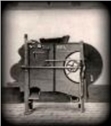
| 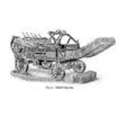
| 
| 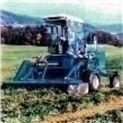
| 
|
Klinger’s first machine; a grain cleaning machine | Klinger received the first patent in the world for a baler machine | After WWWII started a new story as a part of the “Fortschritt” Kombinat Germany. | Small fields were put together to large farms, similar to the Chinese situation now in 2018. First export of these machines to China. | Modern agricultural machinery, sold all over the world, the Harvester E588 picture here. |
KOMBINAT FORTSCHRITT PRODUCTS 1990
(year of German Reunification, privatization and break-up of “Kombinat Fortschritt” begins)

EXAMPLES OF THE RANGE OF KOMBINAT FORTSCHRITT’S AGRICULTURAL MACHINERY:
RAKE, BALER, AND FORAGE HARVESTER
SPECIAL MACHINE SPRAYER, APPLE HARVESTER
POTATO HARVESTER, FULLY AUTOMATIC
All machines are state-of-the-art and demonstrably superior to existing Chinese equipment and harvesting techniques due to manufacturing efficiency, overall quality, and long useful life requiring minimal maintenance.
Since the 1970s almost all agricultural machines have seen only minor alteration of engineering and design features; this continues to be true for virtually all machinery manufactured and distributed today.
Kombinat Fortschritt, unlike most of its western counterparts, was organized as a fully integrated business. All engineering developments were completed by own internal design teams and all parts, to the last screw were manufactured in-house. This resulted in “Fortschritt” designs and engineering know-how being documented in detailed production drawings to the smallest part of a complex machine.
The Kombinat’s engineers had to fulfill the requirements of the socialist countries’ markets, demanding easy to maintain, durable machinery.
From the 1970s the Kombinat’s machines was also required to be suitable for export to western customers, in order to serve as hard currency spinner for the East Germany state.
At its height Kombinat Fortschritt employed more than 60,000 people in multiple locations throughout East Germany, being one of the nation’s biggest and internationally most successful enterprises.
With the end of East Germany, and the break-up of the Kombinat, the history of “Fortschritt” seemed to have come to an end, as western competitors picked up production sites and individual part producing outfits. Western competitors used their own designs and brands, and the knowledge and engineering designs of Fortschritt where ignored as they were deemed eastern, and thus unfashionable. Nevertheless, the brand continued to live on in many socialist countries, among them China, conserved through some of the original East German machines that can still be found operating in these countries.
MAFA, has since updated some of the designs acquired from Kombinat Fortschritt and used them for OEM products for companies such as Case, Fendt, Kvernerland and Kuhn.
BRAND STRENGTH AND PUBLIC AUDIENCE RECEPTION
Despite the fact that Kombinat Fortschritt was broken up more than 25 years ago, the brand is still well-known in many parts of the world and its products are widely featured and discussed on the internet, by historians, former users, agro-machine fans and collectors. On YouTube more than 252,000 videos feature Fortschritt machines. Google search Fortschritt + Landmaschinen counts 231,000 hits.
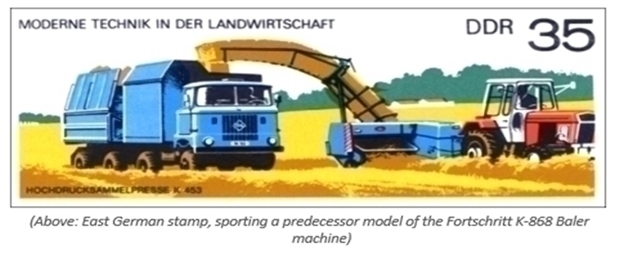
Other models by Fortschritt on the official stamps of the former GDR (East Germany): Tractor ZT 303, Beets-Toboggan-Core KS-6, Precision-Forage-Harvester E 280, Chopper-Harvester E 065
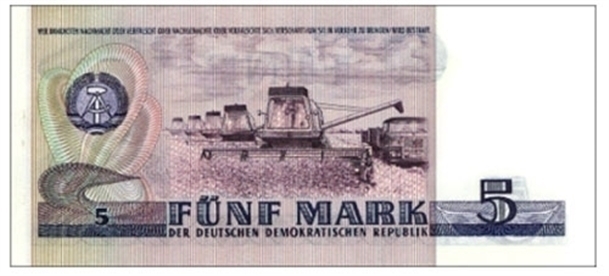
BANKNOTE: In the 70s and 80s, several “combine-harvesters” such as the Fortschritt E512
were shown on the reverse side of GDR (East Germany) banknote
WORLDWIDE HARVESTER AND TRACTOR (ONE TYPE) EXPORT FIGURES:
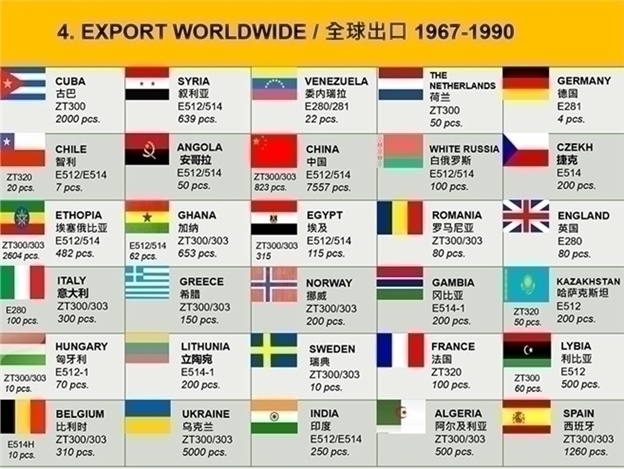
EXPORT FIGURES FOR THE K434 BALER MACHINES TO UKRAINE, RUSSIA, CUBA AND CHINA:
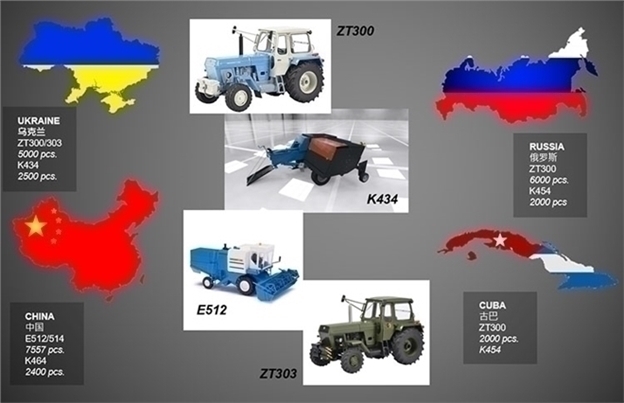
INITIAL PRODUCT FOR QINGDAO FORTSCHRITT CHINA AGRITECH CO. LTD
The Company builds on strong Fortschritt brand recognition in China stemming from the brand’s export history of over one hundred years. The Company designs and produces reliable, durable, and high-performing agricultural equipment and machinery. Fortschritt has 12 employees, including research & development and technology design teams based in China and overseen by leading experts from Germany. The Company operates a state-of-the-art 2,500 square meter assembly line, as well as offices and warehouses in Qingdao, China.
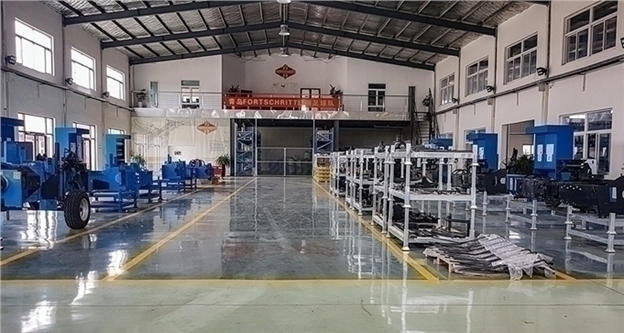
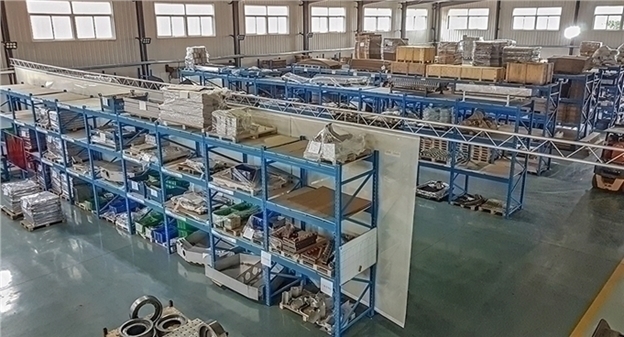
Pictures of the modern production line equivalent to European standards:

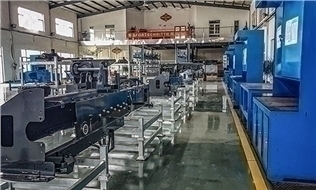
Modern research & development department and ready-made products:
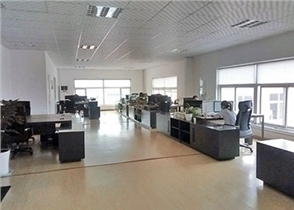
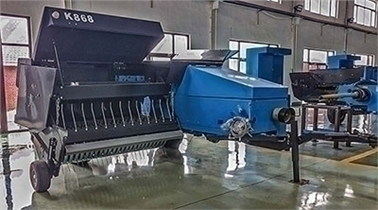
Semi-finished parts in the warehouse:
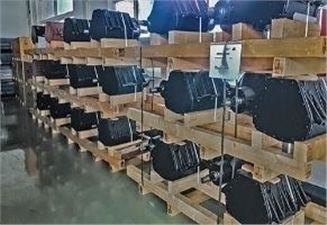
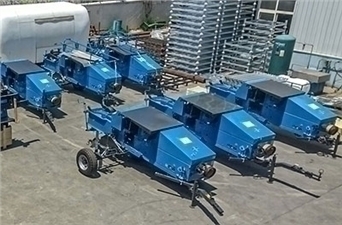
Fortschritt CHINA AGRITECH CO. LTD commenced with production of the following machines:
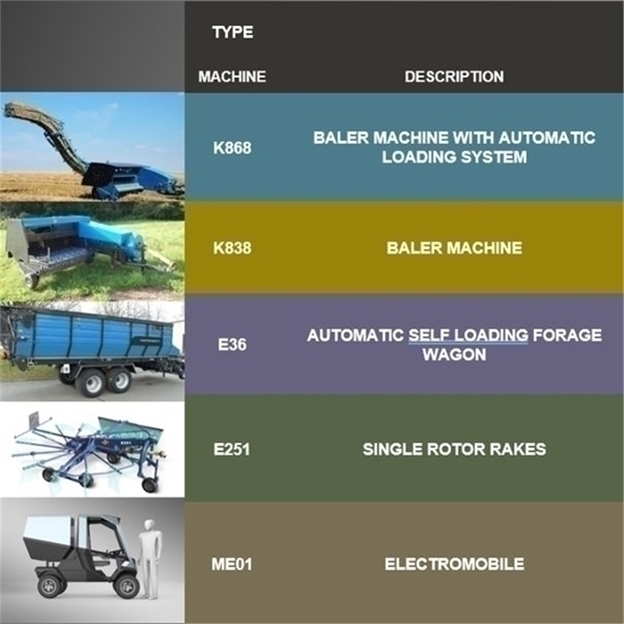
Status of the production of the above machines:
K 868 has begun production with two machines sold over the company CSSC . A total of approximately 100 K 868 machines are in different stages of production;
K 838 has begun production with two machines sold over the company CSSC. A total approximately 100 K 838 machines are in different stages of production;
E 36 Prototype has been completed;
E 251 Prototype has been completed;
ME01 Prototype has been completed.
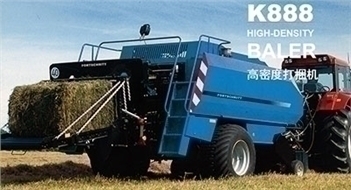
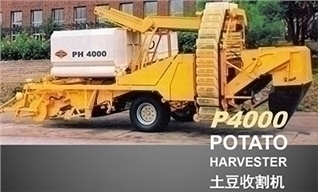
Serial production of a high-density baler machine (K888) and a potato harvester are planned for in 2021. In addition, a multi-function small tractor and crasher are slated for 2022. Plans to initiate a research & development team for these products and a specialized robotics team with a focus on the agricultural sector have also been developed.
HIGH DENSITY BALER MACHINE K838 AND K868
The Company currently markets two high-density baler machines, the K838, and the K868. The smaller model, the FORTSCHRITT K838, is a robust, maneuverable and powerful baler that has been on the market since 2016. The K838 is optimized for use on smaller and angled surfaces and is compatible with various bale-collecting machines.

FORTSCHRITT K838: SMALL HIGH-DENSITY BALER IN USE
The FORTSCHRITT K868 high-density baler machine can be used with tractors equipped with 70-110 horsepower engines. The baler can pick up straw, herbs and green grass for husbandry feedstock. Field testing showed that the K-868 is also able to process rice straw. With its unique automatic loading system, A K868 can clean 1 hectare (10,000 sqm) in approximately 30 minutes.
The advantage of both machines is Fortschritt’s automatic-loading system, which is the subject of Chinese patent No. ZL 2016 2 1144174.6, which is valid through 21 October 2026 . English translation of this patent is filed as Exhibit 10. 13 t o this Registration Statement on Form F-1.
Scope of the Chinese Patent. The utility model name is: An automatic loading device with rotating parallel guide for picking up and binding square balers . The utility model relates to a rotary parallel rail type automatic loading device for picking up and tying machine, which is a special matching device which is installed behind the picking and tying machine and is convenient for automatic loading of the compressed side bundle along the rotating guide rail. The utility model comprises a rotary conveying end assembly, a near horizontal conveying end assembly, a folding automatic tripping mechanism, an automatic return spring, a tripping pull wire and a tilting pull rod. The device is matched with the picking and tying machine, and has a simple structure, a clever design and a quick design. Efficient, the square baler of the front baler can be directly transported to the synchronous transporter, which effectively solves the problem that the knotted bundle is scattered to the ground, and the difficulty of picking up later and the large amount of labor is used, which greatly saves labor and compresses. The square bale combined with the harvesting process saves time and effort and fills the gap in China’s picking up and baling joint harvesting equipment.
While the Company does not currently receive any subsidies, and there is no guaranty that the Company will receive any future subsidies, the “Agricultural Audit Master Station” (part of the “Ministry of Agricultural & Rural Affairs”) officially certified our Fortschritt baler machines. This is a state registration, which makes future state subsidies possible.
Fortschritt passed the required tests to obtain state subsidies and market agricultural machines in China.
Going forward, automatization in the agricultural sector is key for China given the steady decrease in the percentage of the population working in agriculture (83% in 1969 versus 18% today) while salaries have increased (yearly ca. 10%).
See below:
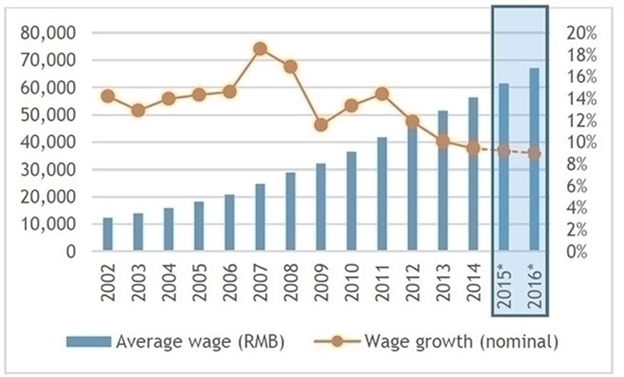
(Labor market and salary report 2015/2016 German chamber of commerce)
Today, only 50% is mechanized and workers primarily use small hand-held operated machines:
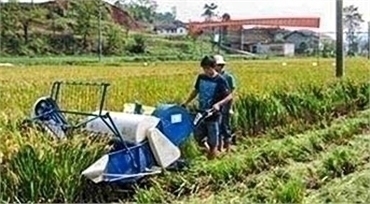



LOADING WAGON E36
Fortschritt machines require no manual handling. The Fortschritt E36 loading wagon fulfills the purpose of loading, pick-up, and reloading greens and droughts. A powerful PICK-UP with five rows of prongs, a working width of 1.85m, hydraulic lifting, air-dyed feeler wheels, adjustable bearing pressure, and further adjustment possibilities ensures the best calculation quality and high-recording performance. The PICK-UP switches off automatically during lifting. The universal dowel allows an optional lower or upper attachment.
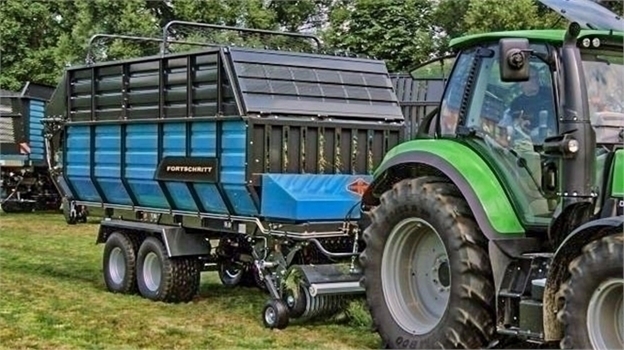
FORTSCHRITT E36 LOADING-WAGON
This wagon is a market innovation with its automatic loading system and capability to cut straw and grass while transporting it in a pick-up.
The 4-raking unit is the heart of the trailer. The steering lever control has a much better wear behavior compared to curve tracks, so there is no interruption of the work, no knife breakage, and an independent knife restoration. The bottom can be hydraulically lowered by the tractor. Depending on the crop, the installation of knives can be optionally made, from “without a knife” to “33 knives”. All knives can be swiveled in and out.
We will also produce a trailer for tractors for transport purposes. This is an emerging field in China as historically, China did not produce enough tractors to meet demand and transport is typically handled with heavy trucks. We believe this adoption of tractor trailers will meaningfully reduce harvesting costs as agricultural workers will use their own tractors for transport versus hiring a truck operator.
E251 SINGLE ROTOR RAKES

The Single Rotor Rakes operates in tandem with the baler machine. It is used to turn the hay and straw to enhance the drying process from sunlight. We plan to introduce this model to the Chinese market.
ME 01 MULTICAR ELECTROMOBILE

This small truck is a multi-function electromobile with hybrid drive. It can be used for agricultural and communal purposes.
The front and back can be assembled with a variety of attachment tools.

We developed a working protype to conduct a range of battery system tests to fine-tune performance and evaluate various component pieces and attachments.
There is no multi-function electromobile with hybrid drive vehicle in China according to our research. The truck can be produced for the Chinese market and for export.
MILESTONES

| 12-2016 | · Company founding | 
|

| 2017 | · Construction of two new factories with office space for Fortschritt China | 
|
 | | · Investment in machines and equipment (e.g. lasers) for production of precision parts and components | 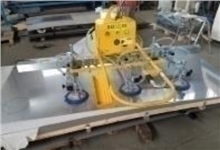
|

| 12-2017 | · Procurement of IT equipment, quality control software, robotics, and tooling equipment for production of the baler machines | 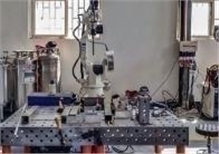
|

| 2018 | · Initiated a dedicated sales and marketing campaign, exhibition attendance and displays · Conducted successful tests in the Chinese market · 30 machines were produced for the German market and exported |  |

| | · Two baler machine production line is ready · First six machines sold on backorder. Strong demand with production backlog growing. | 
|
NOTE: A main sales involves mandated SUBSTITUTION by the GOVERNMENT. |

| 03-2019 | · Produced four K838 and four K868 machines and conducted field tests with oversight and inspection of the Chinese government | 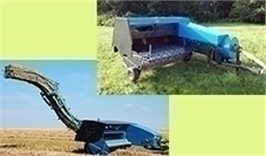
|
 | 06-2019 | · Material for approximately 100 small and 80 medium to large baler machines produced | 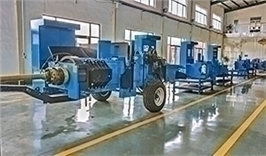
|

| 07-2019 | · Field tests a resounding success and the Chinese government commits to providing on-going support and targeted product substitution of nearly 30% | 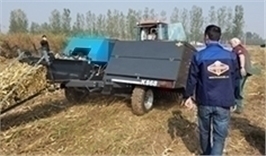
|
| NOTE: Imported agricultural machines require payment of import taxes, transport costs and VAT. ITC and Fortschritt produce domestically which enables a cost of production and product pricing advantage to competitors in the agricultural equipment and machinery market. |

| 12-2019 | · Conclude development of the multi-function electromobile hybrid drive carrier and compact transporter for the Chinese agricultural and rural areas | 
|
 | 2020 | · Officially enter the Chinese market with two baler models and one trailer for serial production | 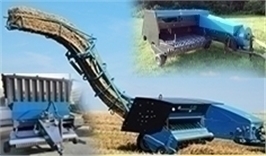
|

| 2021 | · Commence production of a harvester machine | 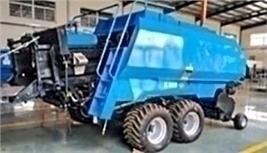
|
LOCATION OF ITC IN CHINA
Qingdao – Population and Infrastructure
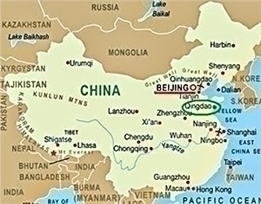
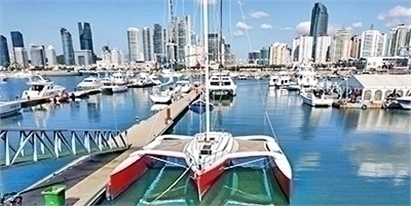
Qingdao has an international airport, highways to Shanghai (600km) and Beijing (550 km), an international deep seaport, which is the third biggest in China and the eight biggest in the world. With the international port, Qingdao supplies more than 450 ports around the globe with 97 shipping routes. In 2018, the high-speed train connection to Beijing and Shanghai was completed.
In 2007, Qingdao was named as one of China’s top ten cities by the Chinese Cities Brand Value Report, which was released at the 2007 Beijing Summit of China Cities Forum (“The Global Financial Centres Index 24, Sept. 2018”. In 2009, Qingdao was named China’s most livable city by the Chinese Institute of City Competitiveness (“China’s Top 10 Liveables Cities in China Issued, 0. July 2009”).
As of 2014, Qingdao has a population of nine million people, with six universities, among them the Qingdao Technical College and the Qingdao Agriculture University with 1,500 academic staffs.
This provides a fertile environment to attract junior level engineers.
Qingdao. Located in the Shandong province is one of the major areas for wheat production (wheat is the main ingredient for all products):
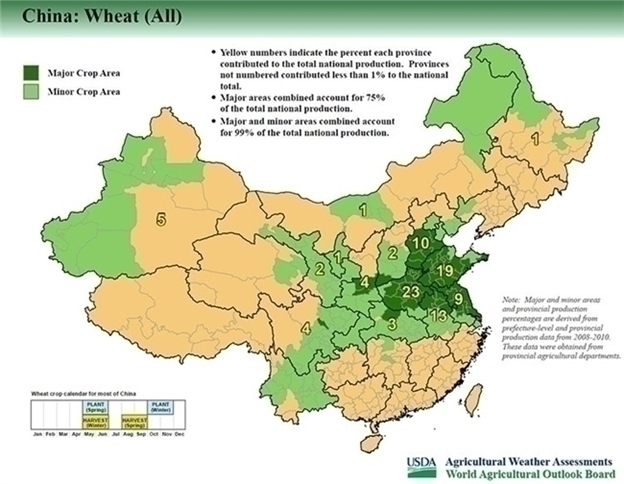
MARKET – COUNTRYSIDE
China’s agricultural sector is the biggest in the world. The country is the number one producer in terms of output for many crops and fruits. Compared to other industrialized countries, China still employs a comparatively high percentage of its total labor force in the agricultural sector.
Major changes in wheat production 2017/18 was (in Mio t)
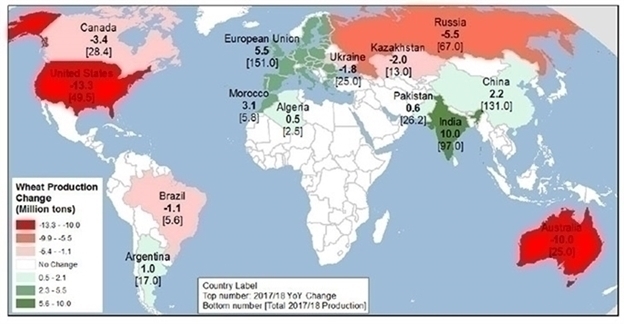
Source: USDA, Foreign Agricultural Service, Production, Supply, and Distribution database.
Major projected wheat output changes for 2017/18 (in Mio t)

Source: USDA, Foreign Agricultural Service, Production, Supply, and Distribution database.
CHINA WORLD MARKET SHARE AGRICULTURAL (PRODUCTION)
| PRODUCTION | EXPORT |
GRAIN | 20% | 0.3% |
WHEAT | 17% | 0.5% |
CORN | 22% | 0.0% |
RICE | 30% | 0.8 |
COTTON | 26% | 0.1% |
GDP CONTRIBUTION BY SECTOR | LABOUR FORCE BY SECTOR |
| |
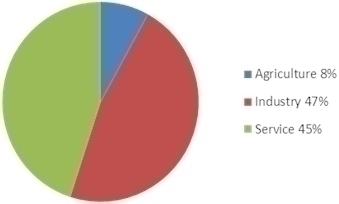
| 
|
| \s\ Source: IHS Global Insight 2013-2016 / National Bureau for Statistic / American Peanut Association | \s\ Source: CIA World Fact Book |
This high ratio of labor force allocated to agriculture is not reflected in the overall contribution of the sector to the total GDP of the country. This fact indicates that the mechanization and industrialization of China’s farm sector are comparatively low. The National Bureau of Statistics displays a 55% mechanization rate for the agricultural sector, but within reason, it can be assumed that this figure includes outdated and inefficient machines and equipment, that may not even be in use any longer.
China is in the midst of a historic shift from traditional, labor-intensive agricultural practices to mechanized, high-tech agriculture. The agricultural sector is owned by the Chinese government, which has made the mechanization of agriculture and the shifting of the rural population to urban areas a top political goal. Changing population structure, limited agricultural land and water resources, the increasingly different eating habits of the Chinese population make this issue the highest priority of the government. Food security is central to China’s strategic alignment and to all countries of the world.
Although China’s agricultural machinery industry is facing many challenges, the industry is still promising in the long run. The state has introduced the Thirteenth Five-Year Plan for National Agricultural Mechanization Development, an Action Program for Agricultural Machinery and Equipment Development (2016-2025) and other policies to promote the full agricultural mechanization. Data shows that China’s comprehensive agricultural mechanization level hits more than 65% in 2016, away from the goal of 70% in 2020.
On February 4, 2018, the Central Committee of the Communist Party of China (CCCPC) and the State Council unveiled its first policy document for 2018. This document, referred to as the No. 1 Document, traditionally focuses on agricultural and rural issues and is considered to be a significant policy document that outlines goals for the upcoming year. The overall message of the 2018 No. 1 Document is focused on developing intensive, domestic agriculture to further China’s strategic interests under the theme of Rural Revitalization.

| | 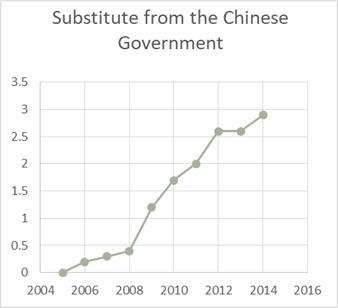
|
| | |
Source VDME Report |
China aims to complete agricultural and rural modernization by 2035 and develop a strong agricultural sector while raising farm incomes to “moderately prosperous levels” by 2050. (See GAIN report CH18007)
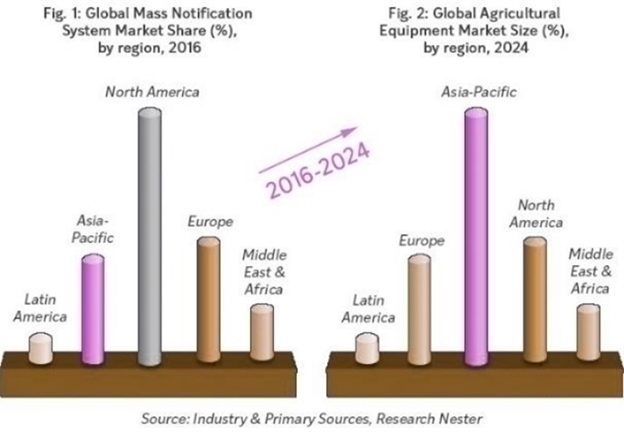
Despite this huge amount of people still living on and engaged in farming, China is facing the challenge to modernize and industrialize the countryside further.
This issue is driven by three key factors:
DEMOGRAPHICS
The trend for moving from countryside to the cities is worldwide and has many reasons. One reason is, that the living conditions in cities are mostly better than countryside, education of the younger generation is better also.
In 1991 almost 44% of the world population was working as a farmer, till 2019 this number is reducing to 28% .
Employment in agriculture (% of total employment) (modeled ILO estimate)
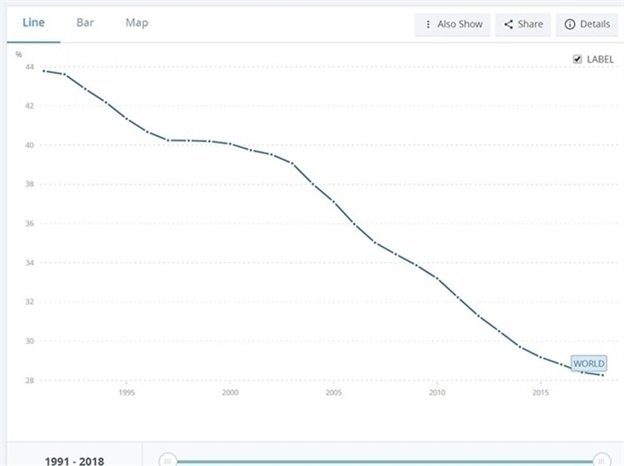
Source: International Labor Organization, ILOSTAT database (April 2019)
Since 2006 China’s rural areas have lost more than 115 million inhabitants (averagely 15 million p.a.), predominantly younger people in search of a better life moving to the cities with its factories and offices. Left behind is a rural society, feeling the impact of China’s rapidly shifting demographics towards an aging population even more than the cities. By 2020, nearly 20% of China’s total population will be 60 years and older (Source: United Nations/ National Bureau of Statistics).

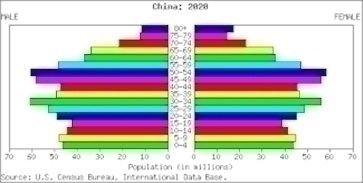
Source: World Bank Source: U.S. Census Bureau, International Data Base
With less labor available, farmers face increased pressure from wage inflation and labor shortages, while at the same time opportunities for farmers to plant bigger fields develop. The ones who left the countryside or have become too old to work the fields themselves, lease their plots to an emerging class of agro-industrialists and agro-entrepreneurs.
FOOD INFLATION
China’s population spends over 1/3 (CPI basket contribution ratio 31.8% in 2016; Source: National Bureau of Statistics) of their disposable income on foodstuff, resulting in the stability of food prices being a pivotal issue for social stability. This could be observed during the years 2008-2011, when food prices spurred by multiple factors, were key drivers of inflation in China. Only a modernized, efficient producing agricultural sector will be able to fulfill the central government’s ambitious target of supplying 99% of the countries food consumption domestically at stable prices. In parallel, the growing demand for meat from China’s urbanized consumer class, lead to further increases in grain prices. The food price hikes recently experienced in China can only be countered sustainably, by increasing efficiency and output, while at the same time reducing the exposure to labor shortages and wage inflation risks.
ENVIRONMENTAL ISSUES
The farming sector is a major contributor to air and water pollution in China. Especially in the northern provinces of Henan, Hebei, and Shandong, the burning of straw on the fields had a major negative impact on air quality, especially during the period from August to late November. Beijing Meteorological Observatory believes, getting straw burning in the provinces surrounding the capital under control will significantly reduce air pollution in the capital. Furthermore, the overuse of fertilizer and inadequate application of pesticides are causing problems for water and soil. According to China’s Ministry of Environmental Protection, nearly 20% of the nation’s arable land is seriously polluted. With agriculture also being a major contributor to water pollution, the Chinese Ministry of Agriculture indicated, that millions of hectares of farmland near rivers may have to be taken out of production to ensure drinking water supply safety. Such a step certainly would jeopardize the government’s aims concerning food supply safety and price stability, thus making further steps towards the efficiency improvement of the agricultural sector inevitable.
ARABLE LAND PER PERSON (HECTARES)
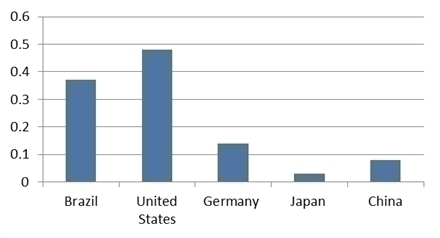
(Source: Food and Agriculture Organization of the United Nations (FAO), 2015)
COMPARED TO OTHER COUNTRIES, CHINA STILL HAS A HUGE POTENTIAL FOR GROWING, WHILE THE MECHANIZATION IS LOW.
Agricultural land area (sq. km)
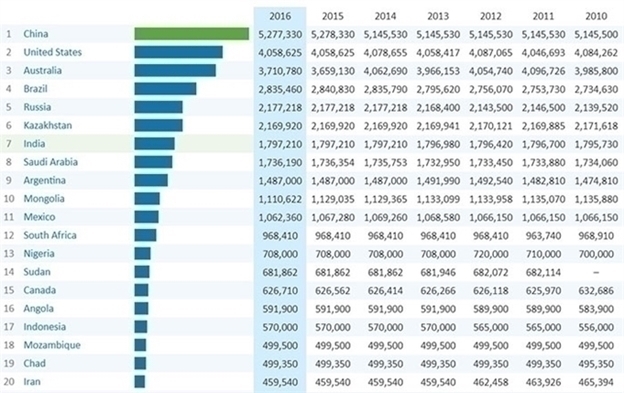
NUMBER OF AGRICULTURAL TRACTORS PER PER 100 SQ. KM OF ARABLE LAND
(UNITS PER 100 SQ. KM)
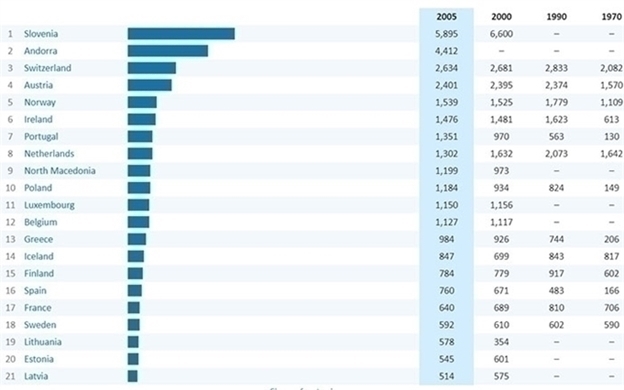
84 China (units per 100 sq. km) in 2000
China`s number of tractors was at level 84 units per 100 sq. km in 2000, up from 67 units per 100 sq. km previous year. This is a change of 25.06 %.
Agricultural machinery refers to the number of wheel and crawler tractors (excluding garden tractors) in use in agriculture at the end of the calendar year specified or during the first quarter of the following year. Arable land includes land defined by the FAO as land under temporary crops (double-cropped areas are counted once), temporary meadows for mowing or for pasture, land under market or kitchen gardens, and land temporarily fallow. Land abandoned as a result of shifting cultivation is excluded.
Compared to other Asian countries, China has an enormous potential for growth:
Country | Year | Rural farmland per capita (hm2/farmer) | Tractor number (Unit/100 hm2) | Labor productivity (industrial added value of agricultural labor / U.S.) |
China | 2004 | 0,11 | 65 | 373 |
Japan | 2004 | 00,3 | 4588 | 26557 |
Korea | 2004 | 00,3 | 1239 | 9996 |
Source: Biennial Conference of the Australian Society for Engineering in Agriculture (SEAg), published by SEAg, Editors: T.M. Banhazi and C. Saunders - 13-16 of September 2009, Brisbane, QLD
Compared to the United States, China’s agriculture market has a significant growth potential:
| CHINA | USA |
Number of farmer (in Mio) | 241.7 | 3.2 |
Number of farms (in Mio) | 200.2 | 2.1 |
Total farmland area (in Mio acres) | 406.8 | 914.5 |
Corn-production area (in Mio acres) | 89.7 | 87.4 |
Soya-bean production area (in Mio acres) | 16.9 | 76.3 |
Wheat production area (in Mio acres) | 59.6 | 45.3 |
Total size of greenhouses (in Mio sq. ft.) | 83.6 | 61.8 |
Average farm size (in acre) | 2 | 433.6 |
Source: Biennial Conference of the Australian Society for Engineering in Agriculture (SEAg), published by SEAg, Editors: T.M. Banhazi and C. Saunders - 13-16 of September 2009, Brisbane, QLD
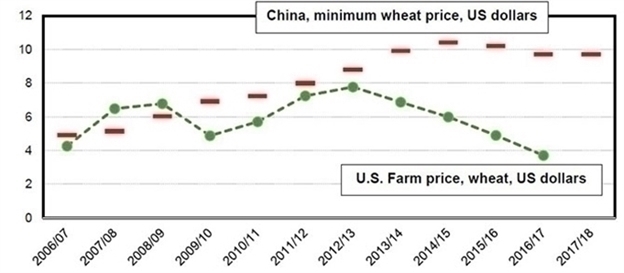
Source: ERS compilation of data from China National Development and Reform Commission and USDA National Agricultural Statistics Service.
China’s agriculture equipment market is valued at around US$28 Billion in 2018 and is expected to reach nearly US$50 Billion by 2025. China has always attached great importance to agriculture, rural areas, and farmers, as agriculture is the primary industry of the national economy.
In 2004, China entered a new era in its approach to agricultural policy, as it began to subsidize rather than tax agriculture. As a result, since 2004, China’s agricultural market has maintained its growth momentum both for production and sale volume. The government has reiterated its commitment to support agriculture and increase the allocation of funds for the development of the rural economy. This has led to a continuous rise in the income level of farmers, increasing their ability to buy agriculture equipment.
China’s agricultural equipment industry is characterized by a large number of mostly unspecialized manufacturers producing low technology machinery. The country has over 2,500 agricultural equipment manufacturers, mainly concentrated in Shandong, Henan, Jiangsu, Liaoning, and Zhejiang provinces, but due to the lack of resources like human capital, funding and the infrastructure necessary to develop sophisticated farming machines, China still relies heavily on foreign imports for high-tech farming machinery. According to the China Agricultural Machinery Distribution Association (CAMDA), the top five domestic manufacturers accounted for less than 25 percent of the market.
GOVERNMENT POLICIES
In the last decade, the Chinese government has raised awareness of the challenges the countryside is facing. This awareness is reflected by numerous supporting policies such as land reforms, increased credit availability in rural areas, the abolishing of VAT for farmers and agricultural goods, and last but not least, a heavy increase of direct government subsidies for the agricultural sector. The government policies aim at several key points to spur the development & modernization of the countryside:
| · | Increase farmers income |
| | |
| · | Create bigger farms |
| | |
| · | Increase agricultural production |
| | |
| · | Promote sustainable & environmentally safe farming |
| | |
| · | Encourage people from the cities to go back to the countryside and invest there |
| | |
| · | Improve food safety |
(See: The Law of Agricultural Mechanization Promotion of the PRC)
SEASONALITY
CSSC’s slowest months are February through May. CSSC will use its slow months for the main production of parts for the Company’s Fortschritt brand machines. Because the Chinese agricultural industry spans multiple climatic zones, and the Company plans to market products to other countries in varying climatic zones, we do not anticipate seasonality to have an impact on our business.
We do not anticipate seasonality to have an impact on our business at Fortschritt. We will begin production of our E-Mobile at Fortschritt for the Chinese market. This is a multifunctional machine, usable for summer (cutting grass, transport, cleaning) as well as for winter (snow slide, transport, cleaning, wintergrit).
AGRICULTURAL SUBSIDIES DEVELOPMENT 2005-2014
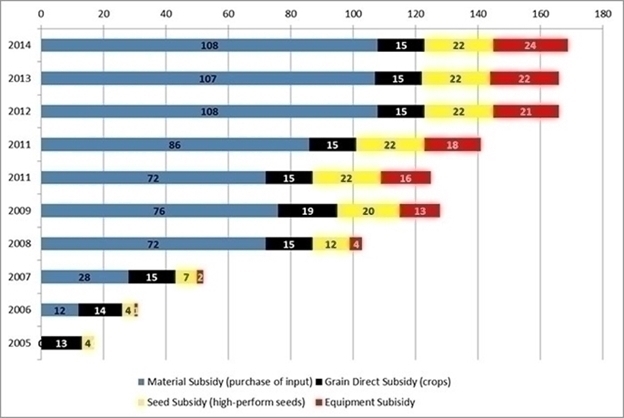
(Source: Ministry of Agriculture/ National Bureau of Statistics)
MARKET – CHINA AGRICULTURAL MACHINERY
MARKET OVERVIEW
Until recently, the Chinese market for agricultural machinery was dominated by two types of enterprise:
· | Small-sized companies producing low-end, low price, low-quality machinery often propelled exclusively by humans or animals. |
| |
· | big state-owned enterprises, predominantly producing small horsepower tractors, at very low quality. |
Traditionally, China’s farming sector consisted of small farms relying almost exclusively on manual labor. Since about 2004 China’s rapid change of its economic model from stone-age communism towards a market-driven economy, has started to take effect on rural live and work. Although still at a low level, mechanization has started and the availability and use of fertilizers as well as pesticides saw production levels soaring.
Nowadays the mechanization ratio has reached 55%, a still a very low level compared to western industrialized societies, and there is the reason to believe that this figure still includes a good number of very old, low-performance equipment.
The demographic developments, and the drag of the cities have left a countryside behind that is suffering from labor shortages and excessive aging. This demographic situation alone, favors the agricultural machinery sectors for many reasons:
LAND LEASE- people who started working in the factories are nowadays renting out there fields to other farmers, thus the average plot size is getting bigger. While bigger plots can be farmed more economically, the shrinking labor pool and aging rural society forces the farmers to increase the mechanization. This trend is supported by the government, first of all making it possible to lease farmland from third parties, secondly by putting in place special lending- and agriculture-related subsidy programs, encouraging bigger farm sizes.
MECHANIZED SERVICE COOPERATIVES- bigger fields and shrinking labor pool have seen the rise of a new class of agro-entrepreneurship in China, the so-called Mechanized Service Cooperatives (‘MSC’). These cooperatives often consist of groups of farmers pooling their resources to purchase high-performance equipment. After working their own fields, they rent out the machinery to other small farmers who cannot afford advanced equipment by themselves. These MSC’s have become so successful, that China Mobile, the leading countryside cellular network operator, even launched a platform for the MSC’s to manage their business more efficiently.
SURGING FARMERS INCOME- during the last decade, spurred by rising food prices, increased farm sizes and government supportive actions, rural incomes have improved significantly. Although the picture is incomplete due to a lack of data, increased production output, food prices and mechanization levels, imply that farming in China is moving towards becoming a real industry, that will ultimately create its very own industrialists.
GOVERNMENT POLICIES AND AIMS
An important indicator for the development of the countryside is the target set by the government to produce 85% of the agricultural output with only 7% of the labor force by 2030, bringing China in line with the modern industrial nations (Source: Ministry of Agriculture). This target corresponds to urbanization and demographic trends.
This aim seems more realistic than the goal laid down in a previous five-year plan, to source 99% of China’s food consumption domestically.
These developments have not gone unnoticed outside China and western companies began to widen their presence and activities in China in the last 4 years, either by developing sales & distribution networks for import machinery or setting up production bases in China.
Several market reports and industry experts estimate that the market for agricultural machinery is growing by over 10% p.a. This estimation is confirmed by figures published by western companies supplying and/ or producing agricultural equipment in China (Source: John Deere/ Claas/ Agco).
In 2015 more than 50% of the German agricultural machinery companies active in China, judged the business climate for agricultural machinery in the PRC as very good or good, with more than 80% judging the business climate in this sector as at least satisfactory (Source: Agrievolution/ VDMA). This makes China the market with the strongest outlook in this survey by far.
Nowadays 15% of the global output of agricultural machinery is manufactured in China already.
(Source: VDMA)
COMPETITION ANALYSIS & PEER ACTIVITY
MAIN COMPETITORS
The following key international and Chinese players have developed manufacturing bases for agricultural machinery in China.
JOHN DEERE, USA
The biggest agricultural machinery producer in the world has currently set up four plants in China in Ningbo, Harbin, Tianjin, and Jiamusi. John Deere also established a joint venture with Tianjin Tractor Manufacturing Co. Limited.
CNH (CASE NEW HOLLAND), ITALY
CNH operates four manufacturing sites in Harbin, Shanghai, Foshan, and Urumqi. The company´s largest manufacturing base In Harbin was commissioned in July 2014. New Holland produces a wide range of agricultural machinery ranging from tractors to add-on applications.
CLAAS, GERMANY
German-based company has grown through acquisitions aggressively in the past decade and propelled itself into the top tier of agricultural machinery manufacturers. The company reports an 11,3% growth in Asian sales in 2015. CLAAS raised 300 million USD in the US in 2012 issuing debt certificates to finance its further growth. In 2013 the company acquired an 85% stake in Shandong based Jinyee Machinery Manufacturing Co. Ltd, a state-owned enterprise.
AGCO, USA
The US Group has commissioned a major manufacturing facility in Changzhou in 2014, focusing on Tractors.
YTO GROUP, CHINA
The company´s tractor business is mainly conducted through its publicly listed subsidiary First Tractor Company Limited. The company´s business had been heavily affected by foreign competition, with its tractor sales declining by 22% in 2014 and its agricultural machinery sales dropping 18% in the same year.
FOTON LOVOL, CHINA
Since 2015 the company aggressively develops its agricultural machinery segment. In January of the same year, the company acquired Mater Macc, an Italian agricultural machinery enterprise. In March 2015 Phase I of its CNY 2 billion investment, a high-end agricultural machinery production base was commissioned focusing on balers and grain dryers.
ZOOMLION HEAVY MACHINERY, CHINA
Formerly known as Chery Heavy Industry Limited, spun off the mother company in 2014. Zoomlion Group is still the biggest shareholder, holding over 60% of the stock. In December 2014 the company commissioned a new production base with a planned capacity of 18,000 units of large-scale equipment, predominantly harvesters.
Besides these key players, a large number of small domestic enterprises is active in the market, which is still highly fragmented. These companies often produce very cheap, very low-quality products and suffer from a lack of engineering capabilities and technological know-how.
Apart from the equipment as mentioned before providers and other Chinese enterprises have started to discover the countryside. Shandong based white good giant Haier entered the arena, through its subsidiary Haier Finance, providing lease financing for agricultural machinery with two offices located in Beijing and Shanghai.

Haier Finance Advertisement for Agricultural Machinery Leasing, 2016
Suning, the Chinese electronics and home appliances retailing giant will invest CNY 5 billion in the Chinese rural market in 2016 to open 1,500 additional self-owned stores and develop 10,000 agent points and authorized service sites. The company’s chairman Zhang Jindong announced that by building channels like self-owned stores and Chinese local-featured halls, Suning aims to promote the industrialization of agriculture in China.
(Source: Chinatechnewswire)
STRATEGIC APPROACH AND KEY MARKETS (PROVINCES)
The company will initially launch the K868 baler machine in China’s ten biggest agricultural provinces. These 10 selected Provinces account for significant amounts of agricultural products.
Table: Agricultural output FCA’s target Provinces compared with total US production
| WHEAT | CORN | RICE |
PROVINCES | 79,815,000 | 135,402,000 | 37,943,000 |
UNITED STATES | 57,966,700 | 333,010,910 | 8,613,090 |
The company will develop its own sales, distribution and service network in the 5 northeastern provinces surrounding its production base in Shandong. These five provinces include some of the most productive in agriculture. The company will appoint provincial representatives and agents and work with local banks and nationwide operating providers of leasing finance. The company received an inquiry from a leading Shandong paper producer for 300 baler machines in July 2016.
Table: Provinces selected for FCA’s own distribution & service network
PROVINCE/ CROP | WHEAT | CORN | RICE |
LIAONING | 37,000 | 11,505,000 | 4,576,000 |
SHANDONG | 20,588,000 | 19,321,000 | 1,064,000 |
SHANXI | 4,038,000 | 5,322,000 | 810,000 |
HEBEI | 12,306,000 | 15,087,000 | 542,000 |
HENAN | 30,822,000 | 16,448,000 | 4,712,000 |
TOTAL | 67,791,000 | 67,683,000 | 11,704,000 |
In six more Provinces the company has already identified suitable distribution partners for its products and signed LOI’s with several local distribution companies. These provinces are also among China’s most productive farming areas.
Table: Provinces with Distribution Partners
PROVINCE/ CROP | WHEAT | CORN | RICE |
XINJIANG | 6,235,000 | 4,216,000 | 590,000 |
INNER MONGOLIA | 1,652,000 | 14,657,000 | 784,000 |
JILING | N/A | 20,040,000 | 5,685,000 |
NINGXIA | 703,000 | 1,658,000 | 700,000 |
HEILONGJIANG | 925,000 | 23,244,000 | 18,439,000 |
GANSU | 2,509,000 | 3,904,000 | 41,000 |
TOTAL | 12,024,000 | 67,719,000 | 26,239,000 |
SALES & DISTRIBUTION
The existing dealerships and dealer networks in China for agricultural machinery is highly fragmented. The company seeks to develop relationships with leading sales organizations in key regions as well as develop its own sales network in the strongest farming areas, co-operating with bigger local farms and MSC’s.
The company is in active talks with First Mongolian Machinery Co. Limited in Baotou, a subsidiary of Norinco (www.norincogroup.com.cn), concerning the access to their nationwide sales network.
The company will also approach leading machinery leasing and financing institutions such as Haier Finance and Agricultural Bank of China.
The company will attend important trade fairs throughout China such as the CIAME (China International Agricultural Machinery Fair) regularly.
SERVICE NETWORK
The company will train service technicians. They will independently operate in their provinces and order spare parts from the company or the local distributor. Our clear, structured design with no electronics involved in key operating parts, allow any car mechanic or locksmith to be trained to maintain and to repair the machines.
The company will set up a service network of 3-5 mobile mechanics per province. These mechanics will rotate inside the provinces and return every four weeks to the Qingdao headquarter for further training. The service mechanics will be Qingdao based employees, this way it can be prevented that they leave the company or start developing their local operations after obtaining the necessary know-how.
The company will establish a WeChat based repair request platform and is considering further methods such as GPS trackers on the machines to obtain data concerning machinery use as well as market information.
The Directors that the additional turnover generated from spare part sales and servicing will amount to 4%-8% of the machinery sales volume per annum. Currently, it is considered to install GPS trackers on every machine sold, in order to establish a database that will enable the company to identify machinery use times and locations, in order to increase maintenance efficiency. The company is exploring opportunities for spare part shipping also through China Post’s agricultural product service and online order platforms.
CSSC COMPANY PROFILE 
CSSC is the production base for Fortschritt and PlanET. The main object of the enterprise is the production of agricultural machinery parts for the German market Fortschritt and PlanET.
CSSC was established in Qingdao, China in 2004. QCSSC provides CAD design, prototype development, production and assembly of metal products to such customers as HYDAC, HAKO, KÄRCHER, KRONE, and MINUTEMAN. The Company is staffed by 120 professionals including German management and a skilled team of European and Chinese specialists and 40 Trainees. The location is approximately 400m from the company “Fortschritt China”. The whole area is about 10.000 sqm, 6.000 sqm production facility, storage and office building.
CSSC`s metal-processing-spectrum includes full-automated laser-cutting, the use of combine- technology to stamping, folding, welding, finishing and assembly. In addition, we provide all the finishes including powder coating. CSSC`s machine-park with a modern and innovative production is absolutely high-quality and ensures our customers at all times to provide consistent and high-grade-products. The high-tech manufacturing equipment, ERP-process-control and the expertise of our highly-qualified-staff build a more solid foundation for quality, reliability of delivery times and competitive prices. CSSC manufacture all common materials such as normal and stainless steels, aluminum and other nonferrous metals.

Typical Industrial work with Robotics nowadays, and part of CSSC beside its machine-park:
FACE RECOGNITION, LASER EQUIPMENT, ROBOT-WELDING
CSSC works with its customers to provide fully comprehensive product design, development, prototyping, manufacture, and assembly of final products. Customers entrust the Company with development tasks in such fields as vehicle technology (agricultural machinery, trailers, spare parts, etc.), traffic engineering (railway transport, spatial planning, alignment, planning, etc.), engineering (process engineering, power engineering, supply engineering, production engineering), material handling (platform trucks, cranes, etc.) and furniture design (product design, materials science, lighting design) as well as transport logistics.

// SERVICE MANAGEMENT. The Company creates long-term sustainable and fruitful business relationships by creating trust through transparency. The Company strives to keep its customers fully informed throughout the project lifecycle. From the idea and sketch to the complex system-solution, creation and design-development is part of this concept. They assist and advise on cost-optimization through intelligent planning and functional analysis.
For example, the selection of a suitable material plays just as an important role as the forming-process, the design or the laser-compatible design-optimization. Their seamless combination of design and manufacture is effective and practicable. The implementation of customer ideas is made by the most modern design and construction software.
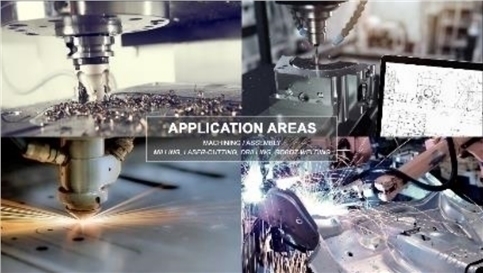
| APPLICATION AREAS OF CSSC: CNC-MILLING DRILLING CNC-LASER-CUTTING PLASMA-CUTTING ROBOT WELDING MAG-WIG-WELDING BENDING SOURCING: FORGINGS & CASTINGS |
// SERVICE. The CSSC metal-processing-spectrum includes fully automated laser-cutting, the use of combine- technology to stamping, folding, welding, finishing, and assembly. In addition, CSSC provides all the finishes including powder coating. The machine-park with the highest quality, modern and innovative production provides their customers with consistent and high-grade-products. The high-tech manufacturing equipment, ERP-process-control and the expertise of highly-qualified-staff provide a solid foundation for manufacturing quality, reliability of delivery times and competitive prices. CSSC manufactures all common materials such as normal and stainless steels, aluminum and other nonferrous metals.

// COMPETITORS. What distinguishes CSSC and makes it special compared to its competitors is its versatility. While other companies specialize in a particular activity, CSSC is broadly diversified and offers a variety of uses. The CSSC offers e.g. not just welding in their portfolio. You already have to distinguish between the manual welding MAG and TIG, and then there is still the welding by robots. Not only in China, but also technology leading countries such as Germany, companies specialize in an activity to have a competitive advantage.
However, this advantage consists only in the subjective perception of each customer, because specialization suggests especially much experience and quality. CSSC has a unique selling proposition as a German-led company in China, which has been successful over 15 years as a supplier worldwide without ever having money borrowed.
// COMPETITIVE SITUATION. Customers include market leaders such as KÄRCHER, KRONE, AEROSPACE or HAKO. And these customers not only order individual single parts but entire assemblies. This implies a wide range of finishing possibilities, from CNC laser cutting to wire erosion to sandblast. The CSSC produces everything in its own enterprise. And for sure the CSSC is also training. Constantly grow the own claim to quality, whether process assurance like automation (Industry 4.0), leadership and training of employees, or in the development of certifications.
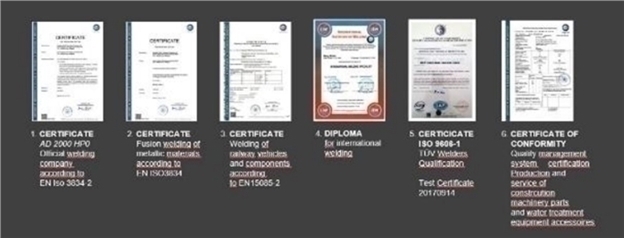
Certifications for an industrial manufacturing company require high investment costs.
For every license of the assembly or welding of products for HIGH-SPEED TRAINS, FILTER-PLANTS or WIND-GENERATORS, a company needs special certificates.
CSSC has more than 50 welders with international high-level welding certificate for railway or pressure-vessels, supplied over 800 clients worldwide & produced over 30.000 assembly units (each unit consists of 2-150 single parts).
CSSC started supplying global players like KRONE, that focused on Agriculture Machinery. The subsidiary of ITC collected experiences over one and half decade and is ready to supply the ITC-owned-brand-Fortschritt to produce own machines of the Agriculture Machinery. That`s what makes the competitive position of this subsidiary more than strong and defines specialization in a new way. CSSC builds the basic; Starting with the acquisition, to accounting and customer care up, to the packing and the dispatch of the parts on container ships or in airplanes.
PlanET COMPANY PROFILE 
PlanET China; supplier for GREEN ENERGY
PlanET stands for “Planning and Application of Energy Technology”. PlanET China specializes in the design, construction, and service of advanced biogas plants. PlanET China is an affiliate of PlanET Biogas Group GmbH ( “ PlanET Germany ”) which is based in Vreden, Germany. The PlanET Biogas Group is one of the leading providers for the planning, construction, service, and repowering of AD plants. We offer technical solutions for the use of 100 percent manure or slurry and challenging substrates such as grass or straw.
Mr. Andreas Spiegler is CEO of PlanET China , and as of June 2019 PlanET China had no employees. PlanET China plans to acquire prefabricated biogas equipment sourced from PlanET Germany , and use local Chinese workers to install and service the biogas equipment in China . Plan ET Germany will be responsible for design and engineering of the Biogas plant s .
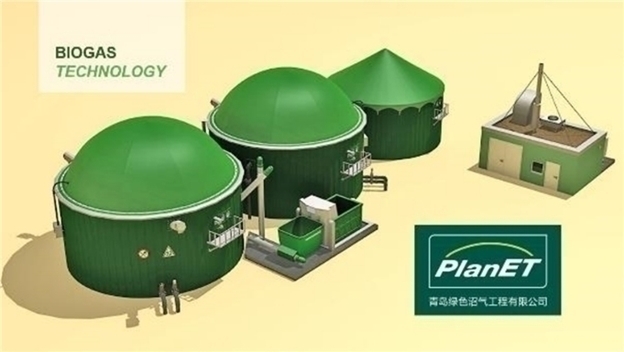
PlanET Biogas China ltd. is an affiliate of PlanET Biogas Group GmbH, which is based in Vreden, Germany. PlanET Biogas Group GmbH ranks among the leading biogas plant builders in Germany and Europe and has designed, constructed and services over 400 anaerobic digestion systems worldwide. PlanET China is located inside of the office building of CSSC.
The name PlanET stands for “Planning and Application of Energy Technology”. PlanET specializes in the design, construction, and service of advanced biogas plants. PlanET Germany started in 1998, and now has over 250 employees, and 400 operating biogas plants. The expected turnover of PlanET group will reach 160 Mio Euro in 2019.
BIOGAS
Biogas is a mixture of gases, predominantly carbon dioxide (CO2) and methane. Methane is the enriching component, which is used for energetic benefits. Sludge, bio-waste and leftovers, farm residues such as dung and slurry and selective energy crops like corn are ideally suited as input. Biogas develops through microbial degradation of organic substances without oxygen. The biogas can be transferred to a Combined Heat and Power Unit (CHP). The electricity and heat produced in this way can be used off-site or fed into the public grid.
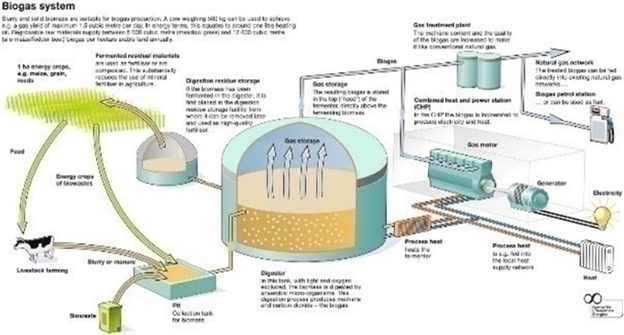
BENEFITS OF BIOGAS
Biogas can be converted into electricity and heat or it can be used as fuel. It may be used as an equivalent to natural gas.
In addition to the economy of turning bio-waste streams into usable energy, biogas has enormous ecological advantages: Substituting fossil fuels with biogas reduces carbon dioxide (CO2) emissions, a recognized contributor to global warming. Digestion products can furthermore replace industrial mineral fertilizer because the mineral nutrients are not degraded and can be returned on the fields as a valuable fertilizer.
While countries like Germany reduced its emission of CO2 to -24,1%, Chinas emission grew up to +306,6% in 2017. (Source: Statista) The biggest emission of CO2 in the world gets out from China.
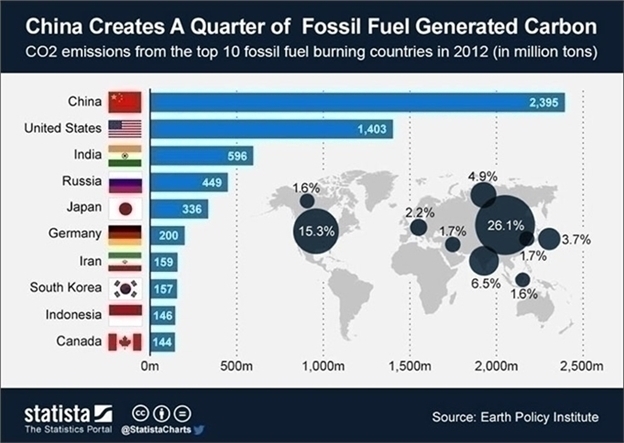
WHY IS BIOGAS NEUTRAL TO THE CLIMATE BALANCE?
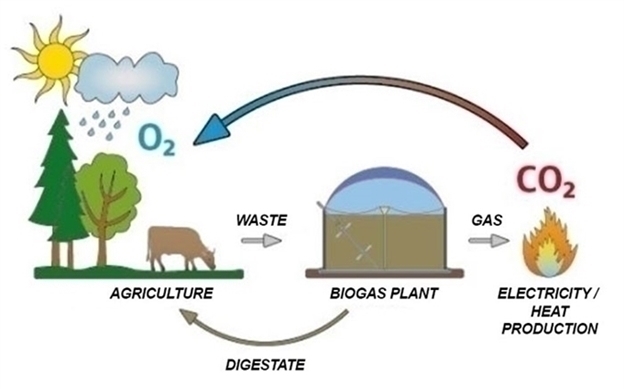
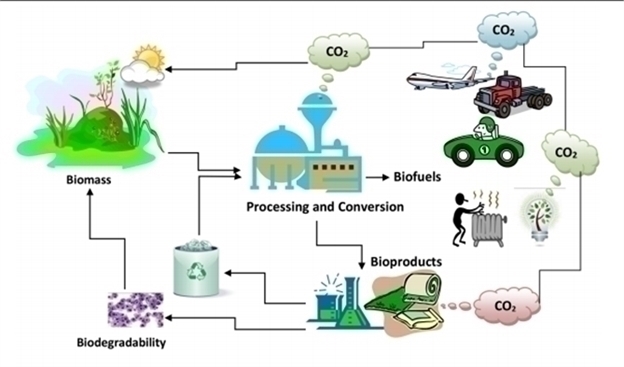
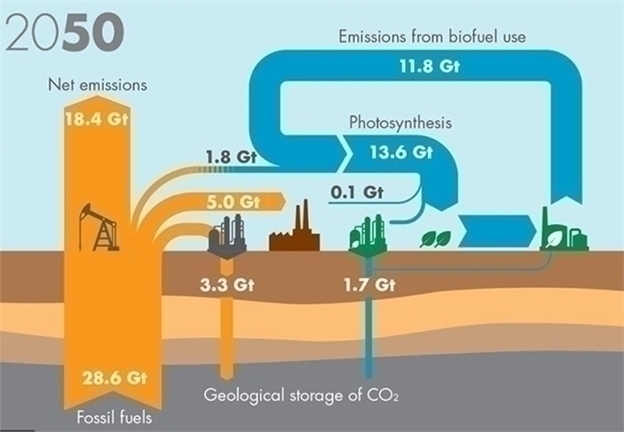
Because of the biogas only CO2 which was created by the organic plants is used. But the fossil fuels come additional to our atmosphere and change the balance. For this reason, we have the climate change, one of the most dangerous processes in the human future.
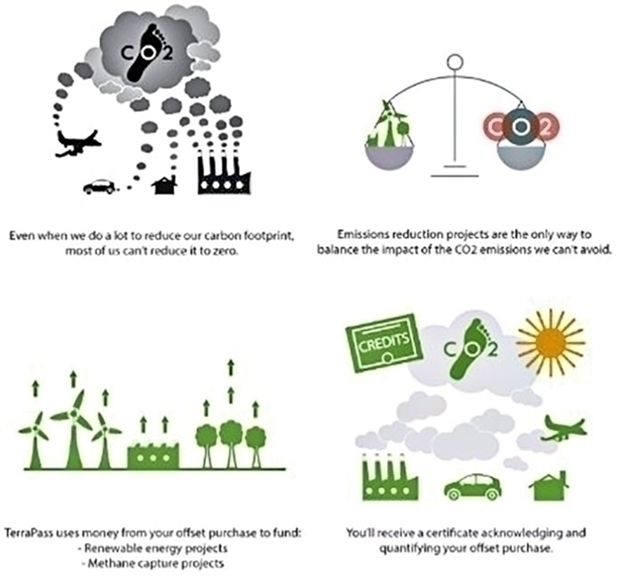
On-Farm Solution. Recycling slurry and manure through an AD plant provides a sustainable system for adding value to farm waste and boosting farm income. The PlanET on-farm solutions are tailor-made and meet the needs of agricultural farms in order to successfully integrate a plant in an already existing business. It is possible to simply utilize the existing farm waste stream to generate power and provide fertilizer. Most project calculations show customer return on investment capital (ROIC) of more than 10% once investment, fixed and variable costs and electricity generation revenues have been considered. Furthermore, on-farm AD plants generally benefit from high levels of public acceptance and do not normally require additional space.
Heat Use. Biogas offers a number of outstanding interactions especially with regard to the methods of livestock farming. Pig and poultry farmers, in particular, need considerable amounts of heat. Most of the CHP’s thermal energy can be used for local heat concepts to replace costly fossil fuels or granting the operator additional income by selling it to e.g. public buildings like hospitals, swimming pools or retirement houses. Another way is the addition of a dryer to the biogas plant set up. There are several containerized PlanET plug-and-play solutions for easy integration into existing or newly designed concepts.
Operating a biogas plant is a chance to reduce energy costs with the production of electricity and heat. When heat is needed for the production process, the integration of an AD plant into existing production structures could realize enormous benefits. You could achieve perfect synergies by feeding the biogas plant with left-overs from the production process and simultaneously using the biogas heat from the CHP unit.

Circular Waste Management. The digestion of waste could complete a cycle of raw materials based on food production or food waste management. Waste disposals are used for the production of biogas and the biogas can substitute fossil fuels for the generation of electricity and heat – such a biogas concept provides a double benefit for its plant owner! The PlanET portfolio also covers the construction and the service of waste to energy plants. Our biogas plants can process almost all organic waste materials from the food industry as well as agricultural residues or fats and oils. Especially in the food industry business sector, anaerobic digestion offers significant cost advantages over traditional disposal methods – both to waste management companies and producers alike.
// COMPETITIVE SITUATION
In China are only two competitors who are able to produce plants which are working:
- A German – Chinese JV between Krieger & Fischer and Hangzhou Energy
- EnviTec Germany
MARKET CHANCES IN CHINA
The Chinese government aims to cover 15 percent of its primary energy demand by renewable energy sources by 2020. Here, bioenergy can contribute to the diversification of the renewable energy mix and support a stable baseload power. It not only contributes to rural development and decreases local environmental pollution as well as the greenhouse gas emissions but also supports overall development towards a sustainable low-carbon circular economy.
The government states that by the end of 2010, about 45,259 small-scale and 27,436 middle and large-scale biogas plants (digester >50 m3) existed with a digester capacity of 8.57 million m3 and an annual biogas output of 1.05 billion nm3 throughout the Chinese biogas sector. This includes 4,641 biogas plants with digesters of more than 300 m3. However, middle and large-scale biogas plants, which are explicitly developed for energy use, and not solely for anaerobic treatment of wastewater, have only emerged in recent years. To utilize the various positives effects and application potentials of bioenergy, the Chinese government has set ambitious goals for its biogas sector. As part of its medium and long-term development plan for renewable energy from 2006 to 2020, the National Development and Reform Commission (NDRC) aims to create 10,000 middle and large-scale biogas plants in the livestock industry and 6,000 industrial wastewater treatment plants with an overall biogas yield of 14 billion nm3 biogas, realize an installed electric capacity of three gigawatts.
During the last ten years, climate change mitigation emerged as an additional development driver of China’s biogas sector. As part of its greenhouse gas emission reduction policies, China signed the Kyoto Protocol in 2002. During the 11th Five-Year Plan, the Chinese government achieved a 20 percent reduction of CO2 emission per unit of Gross Domestic Product (GDP). A total of about two trillion Chinese Yuan (CNY) – 240 billion euros – was invested to achieve this goal. In the course of the Copenhagen UN Climate Change Conference 2009, China then announced its 2020 voluntary targets of reducing the intensity of CO2 emissions per GDP by 40 to 45 percent compared to 2005 and increasing the share of non-fossil fuels in primary energy consumption to around 15 percent by 2020.
MAKING USE OF A HUGE POTENTIAL
Current estimates indicate that use biomass resources in China alone have the energetic potential to cover about five percent of China’s primary energy. The combined energetic potential of crop residues, energy crops, animal manure, urban household waste, and wastewater sludge will lead to a future biogas potential of about 440 billion nm3 in 2030 or installed capacity of about 71 GW. According to current estimates of the total yearly biomass energy potential in 2030, crop residues, including by-products, will represent the largest share at 50 percent of the total biogas potential. Cultivated energy crops on marginal land are estimated to reach 40 percent of the total biomass energy potential by 2030. Animal manure could contribute 9 percent of the future biogas energy, while simultaneously reducing environmental pollution in rural areas. Biodegradable and municipal sewage waste could add another seven and 3 percent respectively.
Regarding the Chinese greenhouse gas (GHG) emission reduction goals, the utilization of the described biomass resources as a substitute for fossil fuels as well as through replacing chemical fertilizer through biogas plant effluent as organic fertilizer is estimated to lead to a yearly emission reduction potential of CO2 equivalents of 4.75 billion tons by 2020 and seven billion tons by 2030.
USE OF PROCEEDS
We will not receive any proceeds from the sale of the ordinary shares by the selling shareholders. All net proceeds from the sale of the ordinary shares will go to the selling shareholders.
DIVIDEND POLICY
We have never declared or paid any cash dividends on our Ordinary Shares and do not anticipate paying any cash dividends in the foreseeable future. Payment of cash dividends, if any, in the future will be at the discretion of our board of directors and will depend on then-existing conditions, including our financial condition, operating results, contractual restrictions, capital requirements, business prospects, and other factors our board of directors may deem relevant.
Under British Virgin Islands law, we may only pay dividends from surplus (the excess, if any, at the time of the determination of the total assets of our company over the sum of our liabilities, as shown in our books of account, plus our capital), and we must be solvent before and after the dividend payment in the sense that we will be able to satisfy our liabilities as they become due in the ordinary course of business; and the realizable value of assets of our company will not be less than the sum of our total liabilities, other than deferred taxes as shown on our books of account, and our capital.
If we determine to pay dividends on any of our Ordinary Shares in the future, as a holding company, we will be dependent on receipt of funds from our Hong Kong subsidiary, ITC-HK. Current PRC regulations permit the PRC Subsidiaries to pay dividends to ITC-HK. Under British Virgin Islands law, we may only pay dividends from surplus (the excess, if any, at the time of the determination of the total assets of our company over the sum of our liabilities, as shown in our books of account, plus our capital), and we must be solvent before and after the dividend payment in the sense that we will be able to satisfy our liabilities as they become due in the ordinary course of business; and the realizable value of assets of our company will not be less than the sum of our total liabilities, other than deferred taxes as shown on our books of account, and our capital; only out of their accumulated profits, if any, determined in accordance with Chinese accounting standards and regulations. In addition, each of our subsidiaries in China is required to set aside at least 10% of its after-tax profits each year, if any, to fund a statutory reserve until such reserve reaches 50% of its registered capital. Each of such entity in China is also required to further set aside a portion of its after-tax profits to fund the employee welfare fund, although the amount to be set aside, if any, is determined at the discretion of its board of directors. Although the statutory reserves can be used, among other ways, to increase the registered capital and eliminate future losses in excess of retained earnings of the respective companies, the reserve funds are not distributable as cash dividends except in the event of a liquidation.
In addition, pursuant to the EIT Law and its implementation rules, dividends generated after January 1, 2008 and distributed to us by our PRC subsidiaries are subject to withholding tax at a rate of 10% unless otherwise exempted or reduced according to treaties or arrangements between the PRC central government and governments of other countries or regions where the non-PRC-resident enterprises are incorporated.
Under existing PRC foreign exchange regulations, payments of current account items, including profit distributions, interest payments and trade, and service-related foreign exchange transactions, can be made in foreign currencies without prior approval of the State Administration of Foreign Exchange, or SAFE, by complying with certain procedural requirements. Specifically, under the existing exchange restrictions, without prior approval of SAFE, cash generated from operations in China may be used to pay dividends to our company. The PRC Subsidiaries may go to a licensed bank to remit their after-tax profits out of China. Nevertheless, the bank will require the PRC Subsidiaries to produce the following documents for verification before they may transfer the dividends to an overseas bank account of their parent company, Industrial Technical Holdings Corporation , or indirect parent, ITC-HK: (1) tax payment statement and tax return; (2) auditor’s report issued by a Chinese certified public accounting firm confirming the availability of profits and dividends for distribution in the current year; (3) the Board minutes authorizing the distribution of dividends to its shareholders; (4) the foreign exchange registration certificate issued by SAFE; (5) the capital verification report issued by a Chinese certified public accounting firm; (6) if the declared dividends will be distributed out of accumulated profits earned in prior years, the PRC Subsidiaries must appoint a Chinese certified public accounting firm to issue an auditors’ report to the bank to certify the PRC Subsidiaries’ financial position during the years from which the profits arose; and (7) other information as required by SAFE.
CAPITALIZATION
The following table sets forth our unaudited capitalization at December 31, 2018 and as adjusted to give effect to the public listing.
| | December 31, 2018 | |
| | Actual | | | As Adjusted (1) | |
Deferred IPO cost | | $ | 106,750 | | | $ | - | |
| | | | | | | | |
| | | | | | | - | |
Common shares, no par value, 100,000,000 shares authorized; 3,236,400 shares in issue (actual) | | | - | | | | - | |
Additional paid-in capital | | | 2,792,395 | | | | 2,685,645 | |
Accumulated deficit | | | (1,486,338 | ) | | | (1,486,338 | ) |
Accumulated other comprehensive loss | | | (184,414 | ) | | | (184,414 | ) |
Total shareholders’ equity | | | 1,121,643 | | | | 1,014,893 | |
Total capitalization | | $ | 1,121,643 | | | $ | 1,014,893 | |
____________
(1) | Reclass of deferred IPO costs to additional-paid-in-capital. |
DILUTION
The Shares to be sold by the selling security holders are Ordinary Shares that are currently issued and outstanding. Accordingly, there will not be any dilution to our existing shareholders or new investors from the sale of the Shares.
MANAGEMENT’S DISCUSSION AND ANALYSIS OF FINANCIAL CONDITION AND RESULTS OF
OPERATIONS OF INDUSTRIAL TECHNICAL HOLDINGS CORPORATION AND SUBSIDIARIES
The following discussion and analysis should be read in conjunction with our consolidated financial statements and the related notes included elsewhere in this prospectus. This discussion contains forward-looking statements that are based on our management’s current expectations, estimates and projections for our business, which are subject to a number of risks and uncertainties. Our actual results may differ materially from those anticipated in these forward-looking statements as a result of many factors, including those set forth under “Forward-Looking Statements” and “Risk Factors”.
Overview
The Registrant was formed under the laws of the British Virgin Islands on the 22nd day of February 2018 to act as a holding company for Industrial Technical Corporation, Ltd., (“ITC - HK”) a company formed under the laws of Hong Kong. ITC-HK is a holding company which conducts operations through subsidiaries as follows:
(i) ITC-HK owns 100% of Qingdao CSSC Co. Ltd. (“CSSC”); a manufacturer of machinery components based in mainland China. CSSC specializes in the design and engineering of the precision parts of agricultural equipment and machinery; and
(ii) ITC-HK owns 100% of Fortschritt China Agritech Co. Ltd. (“Fortschritt HK”); a holding company based in Hong Kong; and
(iii) Fortschritt HK owns 100% of Qingdao Fortschritt China Agritech Co. Ltd (“Fortschritt” also “Fortschritt China”); a manufacturer of modern agricultural machinery; and
(iv) CSSC owns 50% of PlanET LTD Qingdao (“PlanET”); a joint venture with a leading German company ( PlanET Biogas Global GmbH ) in the area of engineering and building green energy biogas plants. PlanET has no sales to date.
On March 16, 2018, the Company entered into a share exchange agreement with ITC-HK (the “Reorganization”); ITC-HK exchanged 100% of its outstanding capital stock for 2,342,000 shares of common stock of the Company. ITC-HK was controlled by the majority shareholder of the Company, Andras Spiegler, CEO and Simon Scholz, former Director.
In accordance with Accounting Standards Codification (“ASC”) 805-50-25, this Reorganization has been accounted for as a recapitalization among entities under common control. The “combination” of the Company and its subsidiaries has been accounted for at historical cost and prepared on the basis as if the aforementioned transactions had become effective as of the beginning of the first period presented in the accompanying consolidated financial statements. Results of operations for the period presented comprise those of the previously separate entities combined from the beginning of the period to the end of the period. By eliminating the effects of intra-entity transactions in determining the results of operations for the period before the Reorganization, those results will be on substantially the same basis as the results of operations for the period after the date of combination. The effects of intra-entity transactions on current assets, current liabilities, revenue, and cost of sales for periods presented and on retained earnings (accumulated deficit) at the beginning of the periods presented are eliminated to the extent possible. Furthermore, ASC 805-50-45 5 indicates that the consolidated financial statements and financial information presented for prior years also shall be retrospectively adjusted to furnish comparative information.
Unless otherwise indicated, references to the “Company”, “us”, “we” or “ITHC” refer to Industrial Technical Holdings Corporation and its consolidated subsidiaries.
The Company’s aim is to create an integrated industrial complex, serving global markets with German precision-engineered parts, products, and services made in China. The principal production base is located in Qingdao, Shandong Province, PR China.
ITHC holds interests in machining parts manufacturing, special machinery assembly as well as agricultural and environmental technologies, and have three operating subsidiaries .
Company ownership structure below:
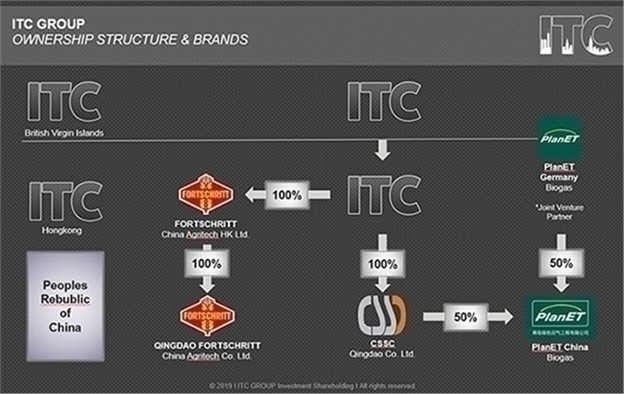
Results of Operations
The following tables set forth a summary of ITHC’s consolidated results of operations for the periods presented. This information should be read together with ITHC’s consolidated financial statements and related notes included elsewhere in this proxy statement. The operating results in any period are not necessarily indicative of the results that may be expected for any future period.
| | Year Ended December 31, | | | Six months ended June 30, | |
| | 2018 | | | 2017 | | | 2019 | | | 2018 | |
| | | | | | | | | | |
Net revenues | | $ | 6,182,801 | | | $ | 5,851,546 | | | $ | 2,280,798 | | | $ | 2,757,474 | |
| | | | | | | | | | | | | | | | |
Cost of revenues | | | 4,743,454 | | | | 4,434,480 | | | | 1,802,454 | | | | 2,026,221 | |
| | | | | | | | | | | | | | | | |
Gross profit | | | 1,439,347 | | | | 1,417,066 | | | | 478,344 | | | | 731,253 | |
| | | | | | | | | | | | | | | | |
Selling, general and administrative expenses: | | | | | | | | | | | | | | | | |
Selling and marketing expenses | | | 343,719 | | | | 503,907 | | | | 54,941 | | | | 159,558 | |
General and administrative expenses | | | 1,819,087 | | | | 1,485,145 | | | | 765,375 | | | | 837,620 | |
Stock base compensation | | | 127,500 | | | | - | | | | 20,000 | | | | - | |
Total operating expenses | | | 2,290,306 | | | | 1,989,052 | | | | 840,316 | | | | 997,178 | |
| | | | | | | | | | | | | | | | |
Loss from operations | | | (850,959 | ) | | | (571,986 | ) | | | (361,972 | ) | | | (265,925 | ) |
| | | | | | | | | | | | | | | | |
Other Income/(expenses): | | | | | | | | | | | | | | | | |
Loss from equity investment | | | (11,199 | ) | | | (1,509 | ) | | | (4,216 | ) | | | (4 | ) |
Other income | | | 264,463 | | | | 95,310 | | | | 6,366 | | | | 66,572 | |
Other expense | | | (37,580 | ) | | | (101,444 | ) | | | (18,164 | ) | | | (17,971 | ) |
OTHER INCOMES/(EXPENSES) | | | 215,684 | | | | (7,643 | ) | | | (16,014 | ) | | | 48,597 | |
| | | | | | | | | | | | | | | | |
Loss before income taxes | | | (635,275 | ) | | | (579,629 | ) | | | (377,986 | ) | | | (217,328 | ) |
| | | | | | | | | | | | | | | | |
Benefit from (provision for) income taxes | | | - | | | | - | | | | - | | | | - | |
| | | | | | | | | | | | | | | | |
NET LOSS | | $ | (635,275 | ) | | $ | (579,629 | ) | | $ | (377,986 | ) | | $ | (217,328 | ) |
The following tables set forth a breakdown of ITHC’s subsidiaries results of operations
| | Year Ended December 31, | | | Six months ended June 30, | |
| | 2018 | | | 2017 | | | 2019 | | | 2018 | |
| | | | | | | | | | | | | | | | | | | | | | | | |
CSSC | | | 5,912,790 | | | | 96 | % | | | 5,505,097 | | | | 94 | % | | | 2,255,172 | | | | 99 | % | | | 2,613,433 | | | | 95 | % |
ITC | | | 270,011 | | | | 4 | % | | | 346,449 | | | | 6 | % | | | 25,626 | | | | 1 | % | | | 144,041 | | | | 5 | % |
Net revenues | | $ | 6,182,801 | | | | 100 | % | | $ | 5,851,546 | | | | 100 | % | | $ | 2,280,798 | | | | 100 | % | | $ | 2,757,474 | | | | 100 | % |
| | | | | | | | | | | | | | | | | | | | | | | | | | | | | | | | |
CSSC | | | 4,443,421 | | | | 94 | % | | | 4,151,496 | | | | 94 | % | | | 1,725,532 | | | | 96 | % | | | 2,026,221 | | | | 100 | % |
ITC | | | 300,034 | | | | 6 | % | | | 282,984 | | | | 6 | % | | | 76,922 | | | | 4 | % | | | - | | | | 0 | % |
Cost of revenues | | | 4,743,454 | | | | 100 | % | | | 4,434,480 | | | | 100 | % | | | 1,802,454 | | | | 100 | % | | | 2,026,221 | | | | 100 | % |
During the period presented above, Fortschritt and PlanET’s revenue and cost of revenue were $nil and $nil respectively.
Year Ended December 31, 2018 Compared to Year Ended December 31, 2017
Revenues:
The following tables present the average selling prices, quantities sold for our products and new product implementation for the periods indicated:
| | Year Ended | | | | |
| | December 31, | | | | |
| | 2018 | | | 2017 | | | Change % | |
| | | | | | | | | |
Average selling prices | | $ | 4.70 | | | $ | 5.11 | | | | -8 | % |
Quantities sold | | | 1,316,520 | | | | 1,145,004 | | | | 15 | % |
New products | | | - | | | | - | | | | - | |
Net revenues increased from $5,851,546 during the year ended December 31, 2017 to $6,182,801 during the year ended December 31, 2018 due to the continued growth in our export sales business. For the period presented, the Company did not have change in price or new products implementation; therefore, increase in revenue is mainly driven by increase in quantities sold from 1,145,004 during the year ended December 31,2017 to 1,316,520 during the year ended December 31,2018. Although the Company did not have price change in products, average price was reduced by 8% to $ 4.70 per unit as compared to last year as less high unit price products were sold for the year ended December 31,2018.
Cost of Sales:
Cost of sales increased from $4,434,480 during the year ended December 31, 2017 to $4,743,454 during the year ended December 31, 2018, which is in line with our sales which was primarily driven by the continued growth in our export sales business primarily driven by continued diversification into oversea market.
Gross Profit:
Gross profit slightly increased from $1,417,066 during the year ended December 31, 2017 to $1,439,347 during the year ended December 31, 2018.
Selling, General and Administrative Expenses:
Total selling, general and administrative expenses increased from $1,989,052 during the year ended December 31, 2017 to $2,290,306 during the year ended December 31, 2018.
Selling and marketing expense. Selling and marketing expense slightly decreased from $503,907 during the year ended December 31, 2017 to $343,719 during the year ended December 31, 2018, primarily due to a decrease in transportation cost.
General and administrative expenses. General and administrative expenses increased from $1,485,145 during the year ended December 31, 2017 to $1,819,087 during the year ended December 31, 2018, primarily due to increased allowance of account receivables in 2018.
Stock base compensation. Stock base compensation increased from nil during the year ended December 31, 2017 to $127,500 during the year ended December 31, 2018, primarily due to stock base compensation of ITHC (BVI) incurred in 2018.
Other Income/(expenses):
Total other income/(expenses) increased from $(7,643) during the year ended December 31, 2017 to $215,684 during the year ended December 31, 2018.
Other Income. Other income increased from $95,310 during the year ended December 31, 2017 to $ 264,463 during the year ended December 31, 2018. This primarily reflects 2018 foreign exchange positive impact and subsidies amount change.
Other Expense. Other expense decreased from $101,444 during the year ended December 31, 2017 to $37,580 during the year ended December 31, 2018. This primarily due to the write-off of uncollectable receivables in 2017.
Income Tax Expense:
Provision for income tax were nil during the year ended December 31, 2017 and 2018.
Net Loss:
As a result of the foregoing, net loss remained stable at $579,629 during the year ended December 31, 2017 and $635,275 during the year ended December 31, 2018.
Six Months Ended June 30, 2019 Compared to Six Months Ended June 30, 2018
Revenue:
The following tables present the average selling prices, quantities sold for our products and new product implementation for the periods indicated:
| | Six Months Ended | | | | |
| | June 30, | | | | |
| | 2019 | | | 2018 | | | Change % | |
| | | | | | | | | |
Average selling prices | | | 5.70 | | | | 3.93 | | | | 45 | % |
Quantities sold | | | 400,396 | | | | 701,731 | | | | -43 | % |
New products | | | - | | | | - | | | | - | |
Net revenue decreased from $2,757,474 during the six months ended June 30, 2018 to $2,280,798 in the same period of 2019. The decrease was primarily due to slowed down in the demand from customer orders. For the period presented, the Company did not have change in price or new products implementation; therefore, decrease in revenue is mainly driven by decrease in quantities sold from 701,731 during the six months ended June 30, 2018 to 400,396 during the six months ended June 30, 2019. Although the Company did not have price change in products, average price has increased by 45% to $5.70 per unit as compared to last year as more high unit price products were sold for the six months ended June 30, 2019.
Cost of Sales:
Cost of sales decreased from $2,026,221 during the six months ended June 30, 2018 to $1,802,454 in the same period of 2019 because of the decrease in quantities produced during the six months ended June 30, 2019.
Gross Profit:
Gross profit decreased from $731,253 during the six months ended June 30 , 2018 to $478,344 during the six months ended June 30, 2019. The decrease was primarily due to decline in sales.
Selling, General and Administrative Expenses:
Total selling, general and administrative expenses decreased slightly from $997,178 during the six months ended June 30, 2018 to $840,316 during the six months ended June 30, 2019.
Selling and marketing expense. Selling and marketing expenses decreased from $159,558 during the six months ended June 30, 2018 to $54,941 during the six months ended June 30, 2019. The decrease was primarily due to the decrease in net revenue in 2019 as compared to the 2018 period, which resulted in decreased freight expenses.
General and administrative expenses. General and administrative expenses decr eased slightly from $837,620 during the six months ended June 30 , 2018 to $765,375 during the same period in 2019. The decrease was primarily due to the decreased employees from 131 to 111 which resulted in lower payroll during the six months ended June 30, 2019 as compared to the same period in 2018.
Stock based compensation. Stock based compensation increased from nil during the six months ended June 30, 2018 to $20,000 during the six months ended June 30, 2019, primarily due to stock base compensation to directors of ITHC (BVI) incurred in 2019.
Other Income/(Expenses):
Total other income /(expenses) decreased from $48,597 income during the six months ended June 30, 2018 to an expense of $16,014 expenses during the six months ended June 30, 2019.
Other Income . Other income decreased from $66,572 during the six months ended June 30, 2018 to $6,366 during the six months ended June 30, 2019. Thi s primarily reflects loss on foreign currency transactions during the six months ended June 30, 2019.
Other Expense . Other expense increased sl ightly from $17, 971 expenses during the six months ended June 30, 2018 to $18,164 expenses during the six months ended June 30, 2019. This increase was primarily due to the increase of bank transfer fees.
Income Tax Expense:
Provision for income tax were nil during the six months ended June 30, 2018 and 2019.
Net Loss:
As a result of the foregoing, net loss increased from $217,328 during the six months ended June 30 , 2018 to $377,986 during the six months ended June 30 , 2019.
Liquidity and Capital Resources
Going Concern Consideration
The accompanying consolidated financial statements have been prepared in conformity with accounting principles generally accepted in the United States of America which contemplate continuation of the Company as a going concern basis. The going-concern basis assumes that assets are realized and liabilities are extinguished in the ordinary course of business at amounts disclosed on the consolidated financial statements. The Group’s ability to continue as a going concern depends on the liquidation of its current assets and business developments. As of June 30, 2019, the Company incurred positive working capital, $2 77 ,0 02 , a comprehensive loss of $2,1 11 , 833 and incurred a negative operating cash flow of $ 493,106 . As of December 31, 2018, the Company incurred positive working capital, $404,154, a comprehensive loss of $1,670,752 and incurred a negative operating cash flow of $871,232. These conditions raise substantial doubt about the ability of the Company to continue as a going concern.
Our continuation as a going concern is dependent upon improving our profitability and the continuing financial support from our stockholders. Our sources of capital in the past have included borrowings from our stockholders and related parties. While we believe that our existing shareholders and related parties will continue to provide the additional cash to meet our obligations as they become due, there can be no assurance that we will be able to raise such additional capital resources on satisfactory terms.
In order to carry out our proposed business plan, we will require a significant amount of capital. We estimate that we will need approximately $10 million to finance our planned operations for the next 12 months.
We estimate that we will need approximately $10 million to finance our planned operations for the next 12 months. The Company may, to raise our cash requirements for the next 12 months through the sale of our equity securities in private placements, through shareholder loans or possibly through a registered public offering (either self-underwritten or through a broker-dealer). If we are unsuccessful in raising enough money through such capital-raising efforts, we may review other financing possibilities such as bank loans or loan from related parties. At this time, we do not commit any broker-dealer to provide us with financing. There is no assurance that any financing will be available to us or if available, on terms that will be acceptable to us. We also may negotiate with our management and consultants to pay parts of their salaries and fees with stock and stock options instead of cash.
Cash Flows and Working Capital
ITHC’s primary sources of liquidity have been funding from issuance of common shares for cash, which have historically been sufficient to meet ITHC’s working capital and substantially all of its capital expenditure requirements.
In order to carry out our proposed business plan, we will require a significant amount of capital. We estimate that we will need approximately $10 million to finance our planned operations for the next 12 months.
We intend to raise our cash requirements for the next 12 months through the sale of our equity securities in private placements, through shareholder loans or possibly through a registered public offering (either self-underwritten or through a broker-dealer). If we are unsuccessful in raising enough money through such capital-raising efforts, we may review other financing possibilities such as bank loans. At this time we do not commit any broker-dealer to provide us with financing. There is no assurance that any financing will be available to us or if available, on terms that will be acceptable to us. We also may negotiate with our management and consultants to pay parts of their salaries and fees with stock and stock options instead of cash.
Net cash used in operating activities of $692,377 in 2017, compared to net cash used in operating activities of $871,233 in 2018. Net cash used in operating activities was $493,106 in the six months ended June 30, 2019, compared with net cash used in operating activities of $859,652 in the same period of 2018.
As of December 31, 2018, ITHC had cash and cash equivalents of approximately $608,001, compared to cash and cash equivalents of approximately $124,152 as of December 31, 2017 and cash and cash equivalents of approximately $261,285 as of June 30, 2019.
The following table sets forth a summary of ITHC’s cash flows for the periods presented:
| | Year Ended | | | Six Months Ended | |
| | December 31, | | | June 30, | |
| | 2018 | | | 2017 | | | 2019 | | | 2018 | |
| | $ | | | $ | | | $ | | | $ | |
Summary Consolidated Cash Flow Data: | | | | | | | | | | | | |
Net cash used in operating activities | | | (871,233 | ) | | | (692,377 | ) | | | (493,106 | ) | | | (859,652 | ) |
Net cash used in investing activities | | | (3,173 | ) | | | (367,281 | ) | | | (16,392 | ) | | | - | |
Net cash provided by financing activities | | | 1,370,257 | | | | 632,081 | | | | 224,997 | | | | 1,359,757 | |
Effect of exchange rate changes on cash and cash equivalents | | | (12,002 | ) | | | 32,513 | | | | (62,215 | ) | | | (7,488 | ) |
Cash and cash equivalents and restricted cash at beginning of period | | | 124,152 | | | | 519,216 | | | | 608,001 | | | | 124,152 | |
Cash and cash equivalents and restricted cash at end of period | | | 608,001 | | | | 124,152 | | | | 261,285 | | | | 616,769 | |
Operating Activities
Net cash used in operating activities was $871,233 in 2018 compared to $692,377 in 2017.
Net cash used in operating activities was $871,233 in 2018. The principal items accounting for the difference between ITHC’s net loss and net cash used in operating activities in 2018 were a decrease in account receivable $205,479, decrease in prepaid expense of $108,592. These items were partially offset by an increase in depreciation and amortization of $190,806.
Net cash used in operating activities amounted to $692,377 in 2017. The principal items accounting for the difference between ITHC’s net loss and its net cash used in operating activities in 2017 were an increase in trade accounts payable of $1,031,837, which were partially offset by a decrease in product inventories of $1,129,193.
Net cash used in operating activities was $493,106 in the six months ended June 30, 2019, compared with net cash used by operating activities of $859,652 in the same period of 2018
Net cash used in operating activities amounted to $493,106 in the six months ended June 30, 2019. The principal items accounting for the difference between ITHC’s net loss and its net cash used in operating activities in the six months ended June 30, 2019 were a decrease in trade accounts payable of $400,038 due to slow down in production and an increase in accounts receivable of $34,030 due to increased sales in June 2019.
Investing Activities
Net cash used in investing activities was $3,173 in 2018, and $367,281 in 2017.
Net cash used in investing activities was $3,173 in 2018, which was attributable to acquisition of intangible assets of $3,173.
Net cash used in investing activities was $367,281 in 2017, which was attributable to acquisition of property and equipment of $224,239, investment in construction in progress of $94,907, and investment in joint ventures of $ 48,135 .
Net cash used in investing activities was $16,392 in the six months ended June 30, 2019 , which was attributable to acquisition of property and equipment such as Weld Cleaner and Kaercher Sweeper of $13,148 and purchase of intangible assets, Tianxin ERP software of $3,244 in the six months ended June 30, 2019, compared with nil in the same period of 2018.
Financing Activities
Net cash provided by financing activities was $1,370,257 in 2018, and $632,081 in 2017.
Net cash provided by financing activities was $1,370,257 in 2018, which was primarily due to proceed from common stock issuance.
Net cash provided by financing activities was $632,081 in 2017, which was primarily due to cash received from shareholder for subscription receivable.
Net cash provided by financing activities was $224,997 in the six months ended June 30 , 2019 compared with $ 1,359,757 in the same period of 2018.
Net cash provided by financing activities was $224,997 in the six months ended June 30, 2019, which was due to issuance of common shares for cash.
Net cash provided by financing activities was $1,359,757 in the six months ended June 30, 2018, which was primarily due to proceeds from common stock issuance.
Commitments and Contingencies
Lease commitments
We have several operating leases, primarily for offices and factories rent. Our principal executive offices are located in Qingdao, China. The aggregate future minimum payment under these non-cancelable operating leases are summarizes in the table below.
Twelve months ending June 30, 2019 | | Minimum lease payment | |
2020 | | $ | 94,750 | |
2021 | | | | |
2022 | | | | |
2023 | | | | |
2024 | | | | |
Thereafter | | | | |
Total minimum lease payments | | $ | 94,750 | |
For the year ended December 31, 2018 and 2017, the Company has rent expense for the amount of $136,748 and $77,887 respectively. For the six months ended June 30 , 2019 and 2018, the Company has rent expense for the amount of $79,120 and $69,010 respectively.
As of June 30, 2019, December 31, 2018, and 2017, Company has no material purchase commitments, significant leases, unused letters of credit or pending legal proceedings.
As of June 30, 2019, the aggregate future minimum payments consist of:
Lessor | | Lease Date | | Expire Date | | Minimum lease payment($) | |
Daosheng Jiang | | 2018/2/1 | | 2020/1/31 | | | 17,205 | |
Yanan Jiang | | 2019/2/1 | | 2020/1/31 | | | 31,916 | |
Jun Jiang | | 2019/1/1 | | 2020/1/31 | | | 18,066 | |
Jishan Liu | | 2019/1/1 | | 2020/1/31 | | | 18,066 | |
Fangjian Wang | | 2019/4/1 | | 2020/1/31 | | | 9,497 | |
| | | | | | | 94,750 | |
Lease Agreements
As at date of this Report, the Company has executed several leases in respect of premises occupied by the Company.
Qingdao, China
CSSC, our subsidiary, rents offices and laboratory premises, consisting of approximately 28,880 square feet, located at Shuanglong Industrial Park, Huanxiu Subdistrict Office, Jimo District, Qingdao from Jiang Daosheng and Jiang Yanan. The two-year renewable lease expire on January 31, 2020. The total rental charge in respect of the year ended December 31, 2018 was approximately $56,580.
Qingdao, China
FQA, our subsidiary, rents office premises , consisting of approximately 24,500 square feet, which are located at Shuanglong Industrial Park, Huanxiu Subdistrict Office, Jimo District, Qingdao from Jiang Jun, Liu Jishan and Wang Fangjian. The two-year renewable lease expire on January 31, 2020. The total rental charge in respect of the year ended December 31, 2018 was approximately $ 80,168 .
The Company does not have material plans to construct, expand or improve its leased facilities.
Off-Balance Sheet Arrangements
As of June 30, 2019, we did not have any off-balance sheet debt nor did we have any transactions, arrangements, obligations (including contingent obligations) or other relationships with any unconsolidated entities or other persons that may have material current or future effect on financial conditions, changes in the financial conditions, results of operations, liquidity, capital expenditures, capital resources, or significant components of revenue or expenses.
Capital Expenditures
ITHC made capital expenditures of $3,173 and $367,281 during the year ended December 31, 2018 and 2017, and $16,393 and $nil during the six months ended June 30, 2019 and 2018, respectively. In these periods, ITHC’s capital expenditures were mainly used to purchase property, investment in production line and joint venture investment for its business. ITHC will continue to make capital expenditures to meet the expected growth of its business.
Capital expenditures during the year ended December 31, 2018 was $3,173, which was attributable to acquisition of intangible assets of $3,173.
Capital expenditures during the year ended December 31, 2017 was $367,281, which was attributable to acquisition of equipment and machinery of $224,239, investment in production line of $94,907, and investment in joint ventures of $ 48,135
Capital expenditures during the six months ended June 30, 2019 was $16,393, which was attributable to acquisition of property and equipment such as Weld Cleaner and Kaercher Sweeper of $13,148 and purchase of intangible assets, Tianxin ERP software of $3,244, compared with $nil in the same period of 2018.
CRITICAL ACCOUNTING POLICIES AND ESTIMATES
We prepare our consolidated financial statements in conformity with U.S. GAAP, which requires us to make judgments, estimates and assumptions. We continually evaluate these estimates and assumptions based on the most recently available information, our own historical experiences and various other assumptions that we believe to be reasonable under the circumstances. Since the use of estimates is an integral component of the financial reporting process, actual results could differ from our expectations as a result of changes in our estimates. Some of our accounting policies require a higher degree of judgment than others in their application and require us to make significant accounting estimates.
The following descriptions of critical accounting policies, judgments and estimates should be read in conjunction with our consolidated financial statements and other disclosures included in this prospectus. The selection of critical accounting policies, the judgments and other uncertainties affecting application of those policies and the sensitivity of reported results to changes in conditions and assumptions are factors that should be considered when reviewing our consolidated financial statements. We believe the following accounting policies involve the most significant judgments and estimates used in the preparation of our consolidated financial statements.
Consolidation of entities
The consolidated financial statements include the accounts of the Company and its subsidiaries. All inter-company transactions and balances are eliminated upon consolidation.
On March 16, 2018, the Company entered into a share exchange agreement with ITC-HK (the “Reorganization”); ITC-HK exchanged 100% of its outstanding capital stock for 2,342,000 shares of common stock of the Company. ITC-HK was controlled by the majority shareholder of the Company, Andreas Spiegler, CEO and Simon Scholz, former Director.
In accordance with Accounting Standards Codification (“ASC”) 805-50-25, this Reorganization has been accounted for as a recapitalization among entities under common control. The “combination” of the Company and its subsidiaries has been accounted for at historical cost and prepared on the basis as if the aforementioned transactions had become effective as of the beginning of the first period presented in the accompanying consolidated financial statements. Results of operations for the period presented comprise those of the previously separate entities combined from the beginning of the period to the end of the period. By eliminating the effects of intra-entity transactions in determining the results of operations for the period before the Reorganization, those results will be on substantially the same basis as the results of operations for the period after the date of combination. The effects of intra-entity transactions on current assets, current liabilities, revenue, and cost of sales for periods presented and on retained earnings (accumulated deficit) at the beginning of the periods presented are eliminated to the extent possible. Furthermore, ASC 805-50-45 5 indicates that the consolidated financial statements and financial information presented for prior years also shall be retrospectively adjusted to furnish comparative information.
Basis of presentation
The consolidated financial statements have been prepared in accordance with accounting principles generally accepted in the United States of America (“U.S. GAAP”) and pursuant to the rules and regulations of the Securities Exchange Commission (“SEC”). The Company’s consolidated financial statements are expressed in U.S. dollars.
Use of estimates and assumptions
The preparation of consolidated financial statements in accordance with U.S. GAAP requires management to make estimates and assumptions that affect the amounts reported and disclosed in the consolidated financial statements and accompanying notes. Actual amounts could differ from those estimates and differences could be material. Changes in estimates are recorded in the period they are identified.
Significant accounting estimates reflected in the Company’s consolidated financial statements include valuation allowances for deferred tax assets, allowance for doubtful accounts, the useful lives of fixed assets, valuation of share-based awards, accruals and other liabilities.
Foreign currency translation
The functional currency of the Company’s operations in the PRC is the Chinese Yuan or Renminbi (“RMB”). The consolidated financial statements are translated to U.S. dollars using the period-end rates of exchange for assets and liabilities, equity is translated at historical exchange rates, and average rates of exchange (for the period) are used for revenues and expenses and cash flows. As a result, amounts relating to assets and liabilities reported on the statements of cash flows may not necessarily agree with the changes in the corresponding balances on the balance sheets. Translation adjustments resulting from the process of translating the local currency financial statements into U.S. dollars are included in determining comprehensive income / loss. Transactions denominated in foreign currencies are translated into the functional currency at the exchange rates prevailing on the transaction dates. Assets and liabilities denominated in foreign currencies are translated into the functional currency at the exchange rates prevailing at the balance sheet date with any transaction gains and losses that arise from exchange rate fluctuations on transactions denominated in a currency other than the functional currency are included in the results of operations as incurred.
All of the Company’s revenue transactions are transacted in its functional currency. The Company does not enter into any material transaction in foreign currencies. Transaction gains or losses have not had, and are not expected to have, a material effect on the results of operations of the Company.
Asset and liability accounts at June 30, 2019 and 2018 were translated at 6.8747 RMB to $1.00 and 6.6166 RMB to $1.00, at December 31, 2018 and 2017 were translated at 6.8632 RMB to $1.00 and at 6.5342 RMB to $1.00, respectively, which were the exchange rates on the balance sheet dates. Equity accounts were stated at their historical rates. The average translation rates applied to the statements of operations for the six months ended June 30, 2019 and 2018 were 6.7808 RMB to $1.00 and 6.3711 RMB to $1.00, and for the years ended December 31, 2018 and 2017 were 6.6174 RMB and 6.7518 RMB to $1.00, respectively. Cash flows from the Company’s operations are calculated based upon the local currencies using the average translation rate.
Accounts receivable
Accounts receivable are recorded at net realizable value consisting of the carrying amount less an allowance for non-collectible accounts as needed. The Company establishes a provision for doubtful accounts when there is objective evidence that the Company may not be able to collect amounts due. Management reviews the adequacy of the allowance for doubtful accounts on an ongoing basis, using historical collection trends and individual account analysis. The allowance is based on management’s best estimates of specific losses on individual customer exposures, as well as the historical trends of collections. Account balances are charged off against the allowance after all means of collection have been exhausted and the likelihood of collection is not probable. As of June 30, 2019, December 31, 2018 and 2017, the allowance for doubtful accounts were amounted to $157,124, $175,744 and $28,149, respectively.
Deferred IPO costs
The Company complies with the requirements of ASC 340-10-S99-1 and SEC Staff Accounting Bulletin (SAB) Topic 5A — “Expenses of Offering”. Offering costs consist principally of professional and registration fees incurred through the balance sheet date that are related to the Public Offering and that were charged to stockholders’ equity upon the completion of the Initial Public Offering. Offering costs of approximately $106,750 have been charged to deferred IPO costs account till completion of the Initial Public Offering in 2020.
Inventories
Inventories are stated at the lower of cost or net realizable value. Cost of inventories is calculated using the weighted-average method. In addition to the cost of raw materials, work in progress and finished goods include direct labor costs and overhead. The Company periodically assesses the recoverability of all inventories to determine whether adjustments are required to record inventories at the lower of cost or market value. Inventories that the Company determines to be obsolete or in excess of forecasted usage are reduced to its estimated realizable value based on assumptions about future demand and market conditions. If actual demand is lower than the forecasted demand, additional inventory write-downs may be required.
Investments in joint ventures- Equity method
A joint venture is a type of joint arrangement whereby the parties that have joint control of the arrangement have rights to the net assets of the joint venture. Joint control is the contractually agreed sharing of control of an arrangement, which exists only when decisions about the relevant activities require the unanimous consent of the parties sharing control.
The considerations made in determining significant influence or joint control are similar to those necessary to determine control over subsidiaries. The Company’s investments in its joint venture are accounted for using the equity method.
Under the equity method, the investment in a joint venture is initially recognized at cost. The carrying amount of the investment is adjusted to recognize changes in the Company share of net assets of the joint venture since the investment date. The consolidated statements of profit or loss reflect the Company's share of the results of operations of the joint venture.
After application of the equity method, the Company determines whether it is necessary to recognize an impairment loss on its investment in its associate or joint venture. At each reporting date, the Company determines whether there is objective evidence that the investment in the joint venture is impaired. If there is such evidence, the Company calculates the amount of impairment as the difference between the recoverable amount of the joint venture and its carrying value, and then recognizes the pro-rata loss in the consolidated statements of profit or loss.
Upon loss of significant influence over the joint venture, the Company measures and recognizes any retained investment at its fair value. Any difference between the carrying amount of the joint venture upon loss of significant influence or joint control and the fair value of the retained investment and proceeds from disposal is recognized in consolidated statements of profit or loss.
Impairment for long-lived assets
Long-lived assets, including property and equipment with finite lives are reviewed for impairment whenever events or changes in circumstances (such as a significant adverse change to market conditions that will impact the future use of the assets) indicate that the carrying value of an asset may not be recoverable. The Company assesses the recoverability of the assets based on the non-discounted future cash flows the assets are expected to generate and recognize an impairment loss when estimated discounted future cash flows expected to result from the use of the asset plus net proceeds expected from disposition of the asset, if any, are less than the carrying value of the asset. If an impairment is identified, the Company will reduce the carrying amount of the asset to its estimated fair value based on a discounted cash flows approach or, when available and appropriate, to comparable market values. As of June 30, 2019, December 31, 2018, and 2017, no impairment of long-lived assets was recognized.
Revenue recognition
Pursuant to the guidance of ASC Topic 605, the Company recognizes revenue when persuasive evidence of an arrangement exists, delivery has occurred or services have been provided, the purchase price is fixed or determinable and collectability is reasonably assured.
The Company recognizes revenue on all contracts when control of the product is transferred to the customer. Control is generally transferred when products are shipped, the title is transferred, significant risks of ownership have transferred, the Company has rights to payment, and rewards of ownership pass to the customer.
Stock-Based Compensation
The Company accounts for stock-based compensation in accordance with ASC 718-10 “Compensation-Stock Compensation” which requires the measurement and recognition of compensation expense for all share-based payment awards made to employees and directors including employee stock options, restricted stock units, and stock appreciation rights are based on estimated fair values. Stock-based compensation expense recognized during the period is based on the value of the portion of share-based payment awards that is ultimately expected to vest during the period.
The Company accounts for non-employee stock-based awards at fair value in accordance with the measurement and recognition criteria of ASC 505-50 “Equity-Based Payments to Non-Employees.
Segment Reporting
The Company follows the provisions of ASC Topic 280, “Segment Reporting”, which establishes standards for reporting information about operating segments of public entity by the method of “management approach” for determining reporting segments such as products and services, geographic areas, or major customers. The management approach designates the internal organization that is used by management for making operating decisions and assessing performance as the source of the Company’s reportable segments.
The Company’s management reporting structure provided for only one operating segment during the period presented because other operating segments did not pass quantitative threshold according to ASC 280-10-50-10(b). Moreover, the Company operates in one single geographic area. In short, the Company is not required to present separate segment information in this financial statement.
The Company accounts for income taxes in accordance with U.S. GAAP for income taxes. Under the asset and liability method as required by this accounting standard, the recognition of deferred income tax liabilities and assets for the expected future tax consequences of temporary differences between the income tax basis and financial reporting basis of assets and liabilities. Provision for income taxes consists of taxes currently due plus deferred taxes.
The charge for taxation is based on the results for the fiscal year as adjusted for items, which are non-assessable or disallowed. It is calculated using tax rates that have been enacted or substantively enacted by the balance sheet date.
Deferred taxes are accounted for using the asset and liability method in respect of temporary differences arising from differences between the carrying amount of assets and liabilities in the consolidated financial statements and the corresponding tax basis used in the computation of assessable tax profit. Deferred tax liabilities are recognized for all future taxable temporary differences. Deferred tax assets are recognized to the extent that it is probable that taxable income will be available against which deductible temporary differences can be utilized. Deferred tax is calculated using tax rates that are expected to apply to the period when the asset is realized, or the liability is settled.
Deferred tax is charged or credited in the consolidated statement of operations, except when it is related to items credited or charged directly to equity. Deferred tax assets are reduced by a valuation allowance when, in the opinion of management, it is more likely than not that some portion or all of the deferred tax assets will not be realized. Current income taxes are provided in accordance with the laws of the relevant taxing authorities.
An uncertain tax position is recognized as a benefit only if it is “more likely than not” that the tax position would be sustained in a tax examination, with a tax examination being presumed to occur. The amount recognized is the largest amount of tax benefit that is greater than 50% likely of being realized on examination. For tax positions not meeting the “more likely than not” test, no tax benefit is recorded. As of June 30, 2019, December 31, 2018 and 2017, the Company had no uncertain tax positions, and will continue to evaluate for uncertain positions in the future.
Value Added Tax (“VAT”)
Value-added taxes (“VAT”) collected from customers relating to product sales and remitted to governmental authorities are presented on a net basis. The VAT collected from customers is excluded from revenue. The Company’ revenue is subject to a VAT rate of 17% before April 30, 2018, and a VAT rate of 16% from May 1, 2018 onwards.
RECENTLY ISSUED ACCOUNTING PRONOUNCEMENTS
In May 2014, the Financial Accounting Standards Board (“FASB”) issued ASU No. 2014-09, “Revenue from Contracts with Customers (Topic 606)” (“ASU 2014-09”). ASU 2014-09 requires an entity to recognize the amount of revenue to which it expects to be entitled for the transfer of promised goods or services to customers. ASU 2014-09 will replace most existing revenue recognition guidance in U.S. GAAP when it becomes effective and permits the use of either the retrospective or cumulative effect transition method. The guidance also requires additional disclosure about the nature, amount, timing and uncertainty of revenue and cash flows arising from customer contracts. In August 2015, the FASB issued ASU No. 2015-14, “Deferral of the Effective Date” (“ASU 2015-14”), which defers the effective date for ASU 2014-09 by one year. For public entities, the guidance in ASU 2014-09 was effective for annual reporting periods beginning after December 15, 2017 (including interim reporting periods within those periods), which means it will be effective for the Company’s fiscal year beginning January 1, 2018. In March 2016, the FASB issued ASU No. 2016-08, “Principal versus Agent Considerations (Reporting Revenue versus Net)” (“ASU 2016-08”), which clarifies the implementation guidance on principal versus agent considerations in the new revenue recognition standard. In April 2016, the FASB issued ASU No. 2016-10, “Identifying Performance Obligations and Licensing” (“ASU 2016-10”), which reduces the complexity when applying the guidance for identifying performance obligations and improves the operability and understandability of the license implementation guidance. In May 2016, the FASB issued ASU No. 2016-12 “Narrow-Scope Improvements and Practical Expedients” (“ASU 2016-12”), which amends the guidance on transition, collectability, noncash consideration and the presentation of sales and other similar taxes. In December 2016, the FASB further issued ASU 2016-20, “Technical Corrections and Improvements to Topic 606, Revenue from Contracts with Customers” (“ASU 2016-20”), which makes minor corrections or minor improvements to the Codification that are not expected to have a significant effect on current accounting practice or create a significant administrative cost to most entities. The amendments are intended to address implementation and provide additional practical expedients to reduce the cost and complexity of applying the new revenue standard. These amendments have the same effective date as the new revenue standard. The Company’s current revenue recognition policies are generally consistent with the new revenue recognition standards set forth in ASU 2014-09. As an “emerging growth company,” or EGC, the Company has elected to take advantage of the extended transition period provided in the Securities Act Section 7(a)(2)(B) for complying with new or revised accounting standards applicable to private companies. The amendments in this ASU are effective for annual reporting periods beginning after December 15, 2018, including interim periods beginning after December 15, 2019. The Company is currently evaluating the impact of the adoption of ASU 2014-09 on its consolidated financial statements and related disclosures.
In February 2016, the FASB issued ASU No. 2016-02, Leases (Topic 842). This update will require the recognition of a right-of-use asset and a corresponding lease liability, initially measured at the present value of the lease payments, for all leases with terms longer than 12 months. For operating leases, the asset and liability will be expensed over the lease term on a straight-line basis, with all cash flows included in the operating section of the statement of cash flows. For finance leases, interest on the lease liability will be recognized separately from the amortization of the right-of-use asset in the statement of comprehensive income and the repayment of the principal portion of the lease liability will be classified as a financing activity while the interest component will be included in the operating section of the statement of cash flows. ASU 2016-02 is effective for interim and annual periods beginning after December 15, 2018 and requires a modified retrospective approach to adoption. Early adoption is permitted. In September 2017, the FASB issued ASU No. 2017-13, which to clarify effective dates that public business entities and other entities were required to adopt ASC Topic 842 for annual reporting. A public business entity that otherwise would not meet the definition of a public business entity except for a requirement to include or the inclusion of its financial statements or financial information in another entity’s filing with the SEC adopting ASC Topic 842 for annual reporting periods beginning after December 15, 2019, and interim reporting periods within annual reporting periods beginning after December 15, 2020. ASU No. 2017-13 also amended that all components of a leveraged lease be recalculated from inception of the lease based on the revised after-tax cash flows arising from the change in the tax law, including revised tax rates. The difference between the amounts originally recorded and the recalculated amounts must be included in income of the year in which the tax law is enacted. In November 2019, the FASB issued ASU No. 2019-10, by which to defer the effective date for all other entities by an additional year. As an emerging growth company, the Company has not early adopted this update and it will become effective on January 1, 2021. The Company is currently evaluating the impact of the adoption of ASU 2016-02 on its consolidated financial statements and related disclosures.
In January 2017, the FASB issued ASU No. 2017-01, Business Combinations (Topic 805): Clarifying the definition of a business. The amendments in this ASU is to clarify the definition of a business with the objective of adding guidance to assist entities with evaluating whether transactions should be accounted for as acquisitions (or disposals) of assets or businesses. The definition of a business affects many areas of accounting including acquisitions, disposals, goodwill, and consolidation. The amendments are effective for entities for fiscal years beginning after December 15, 2017, including interim periods within those fiscal years. The Company adopted ASU 2017-1 as of January 1, 2018 and believe the adoption of this ASU does not have a material effect on the Company’s consolidated financial statements.
In May 2017, the FASB issued ASU 2017-09, Scope of Modification Accounting, which amends the scope of modification accounting for share-based payment arrangements and provides guidance on the types of changes to the terms or conditions of share-based payment awards to which an entity would be required to apply modification accounting under ASC 718. This ASU is effective for annual reporting periods, including interim periods within those annual reporting periods, beginning after December 15, 2017. The Company adopted ASU 2017-09 as of January 1, 2018 and adoption of this ASU does not have a material effect on the Company’s consolidated financial statements.
In July 2017, the FASB Issued ASU 2017-11, Earnings Per Share (Topic 260), Distinguishing Liabilities from Equity (Topic 480) and Derivatives and Hedging (Topic 815). The amendments in Part I of the Update change the reclassification analysis of certain equity-lined financial instruments (or embedded features) with down round features. The amendments in Part II of this Update recharacterize the indefinite deferral of certain provisions of Topic 480 that now are presented as pending content in the Codification, to a scope exception. For public business entities, the amendments in Part I of this Update are effective for fiscal years, and interim periods within those fiscal years, beginning after December 15, 2018. For all other entities, the amendments in Part I of this Update are effective for fiscal years beginning after December 15, 2019, and interim periods within fiscal years beginning after December 15, 2020. Early adoption is permitted for all entities, including adoption in an interim period. If an entity early adopts the amendments in an interim period, any adjustments should be reflected as of the beginning of the fiscal year that includes that interim period. The amendments in Part II of this Update do not require any transition guidance because those amendments do not have an accounting effect. The Company is currently evaluating the impact of the adoption of ASU 2017-11 on its consolidated financial statements and related disclosures.
In February 2018, the FASB issued ASU 2018-02, Income Statement - Reporting Comprehensive Income (Topic 220): Reclassification of Certain Tax Effects from Accumulated Other Comprehensive Income. The amendments in this Update affect any entity that is required to apply the provisions of Topic 220, Income Statement – Reporting Comprehensive Income, and has items of other comprehensive income for which the related tax effects are presented in other comprehensive income as required by GAAP. The amendments in this Update are effective for all entities for fiscal years beginning after December 15, 2018, and interim periods within those fiscal years. Early adoption of the amendments in this Update is permitted, including adoption in any interim period, (1) for public business entities for reporting periods for which financial statements have not yet been issued and (2) for all other entities for reporting periods for which financial statements have not yet been made available for issuance. The amendments in this Update should be applied either in the period of adoption or retrospectively to each period (or periods) in which the effect of the change in the U.S. federal corporate income tax rate in the Tax Cuts and Jobs Act is recognized. The Company adopted ASU 2018-02 as of January 1, 2019 and adoption of this ASU does not have a material effect on the Company’s consolidated financial statements.
The Company does not believe other recently issued but not yet effective accounting standards, if currently adopted, would have a material effect on the Company’s consolidated balance sheets, statements of operations and comprehensive income (loss) and statements of cash flows.
EXEMPTIONS UNDER THE JUMPSTART OUR BUSINESS STARTUPS ACT
Recently the United States Congress passed the Jumpstart Our Business Startups Act of 2012 (the “JOBS Act”), which provides for certain exemptions from various reporting requirements applicable to reporting companies under the Securities Exchange Act of 1934, as amended (the “Exchange Act”), that qualify as “emerging growth companies.” We are an “emerging growth company” as defined in section 3(a) of the Exchange Act (as amended by the JOBS Act, enacted on April 5, 2012), and we will continue to qualify as an “emerging growth company” until the earliest to occur of: (a) the last day of the fiscal year during which we have total annual gross revenues of $1,000,000,000 (as such amount is indexed for inflation every 5 years by the SEC) or more; (b) the last day of our fiscal year following the fifth anniversary of the date of the first sale of our common equity securities pursuant to an effective registration statement under the Securities Act; (c) the date on which we have, during the previous 3-year period, issued more than $1,000,000,000 in non-convertible debt; or (d) the date on which we are deemed to be a “large accelerated filer”, as defined in Exchange Act Rule 12b-2. Therefore, we expect to continue to be an emerging growth company for the foreseeable future.
Generally, a registrant that registers any class of its securities under section 12 of the Exchange Act is required to include in the second and all subsequent annual reports filed by it under the Exchange Act, a management report on internal control over financial reporting and, subject to an exemption available to registrants that meet the definition of a “smaller reporting company” in Exchange Act Rule 12b-2, an auditor attestation report on management’s assessment of internal control over financial reporting. However, for so long as we continue to qualify as an emerging growth company, we will be exempt from the requirement to include an auditor attestation report in our annual reports filed under the Exchange Act, even if we do not qualify as a “smaller reporting company”. In addition, section 103(a)(3) of the Sarbanes-Oxley Act of 2002 has been amended by the JOBS Act to provide that, among other things, auditors of an emerging growth company are exempt from the rules of the Public Company Accounting Oversight Board requiring mandatory audit firm rotation or a supplement to the auditor’s report in which the auditor would be required to provide additional information about the audit and the financial statements of the registrant (auditor discussion and analysis).
Additionally, we have irrevocably elected to comply with new or revised accounting standards even though we are an emerging growth company.
CAUTIONARY NOTE REGARDING FINANCIAL DISCLOSURE IN THIS PROSPECTUS
This prospectus should be read in conjunction with the accompanying consolidated financial statements and related notes. The discussion and analysis of the financial condition and results of operations are based upon the consolidated financial statements, which have been prepared in accordance with Generally Accepted Accounting Principles in the United States of America.
The preparation of consolidated financial statements in conformity with these accounting principles requires us to make estimates and assumptions that affect the reported amounts of assets and liabilities, disclosure of contingent liabilities at the financial statement date and reported amounts of revenue and expenses during the reporting period. On an on-going basis, we review our estimates and assumptions. The estimates were based on historical experience and other assumptions that we believe to be reasonable under the circumstances. Actual results are likely to differ from those estimates under different assumptions or conditions, but we do not believe such differences will materially affect our financial position or results of operations.
Critical accounting policies, the policies we believe are most important to the presentation of our consolidated financial statements and require the most difficult, subjective and complex judgments, are outlined below under the heading Critical Accounting Policies, and have not changed significantly.
MANAGEMENT DIRECTORS AND OFFICERS
Our directors and executive officers, their positions and state or province of residence are as follows:
ANDREAS SPIEGLER Qingdao, Shandong, China | Chairman and CEO, Interim CFO |
ANDREW BEFUMO VA, USA | Secretary |
ARNE KRUEGER Qingdao, Shandong, China | Director and COO |
JACQUES BENOLIEL Madrid, Spain | Director |
DR. HEIKO SCHOLZ Beijing, China | Director |
JOEL GALLO, Shenzhen, China and New York, NY, USA | Director |
For additional information concerning our director and senior management, please see the discussion under the heading, “Senior Management and Employees.”
Our Memorandum and Articles of Association are attached to this registration statement as exhibits. The Articles of the Company provide that the number of directors is set at:
| (a) | subject to paragraphs (b) and (c), the number of directors that is equal to the number of the Company’s first directors; |
| | |
| (b) | if the Company is a public company, the greater of three and the number most recently elected by ordinary resolution (whether or not previous notice of the resolution was given); and |
| | |
| (c) | if the Company is not a public company, the number most recently elected by ordinary resolution (whether or not previous notice of the resolution was given). |
Our Board of Directors (the “Board” or “Board of Directors”) currently consists of three directors. Our directors are elected annually at each annual meeting of our Company’s shareholders.
Our Board of Directors currently has one committee, the Audit Committee. The Board has not appointed a compensation committee or a nominating committee because the Board fulfills these functions. The Board assesses potential Board candidates to fill perceived needs on the Board for required skills, expertise, independence and other factors.
Our Board of Directors is responsible for appointing our Company’s officers.
The following table sets forth the names and ages of all our directors, executive officers and key employees:
NAME, PROVINCE/STATE & COUNTRY OF RESIDENCE | AGE | POSITION | DIRECTOR/OFFICER SINCE |
ANDREAS SPIEGLER Qingdao, Shandong, China | 61 | Chairman, CEO and Interim CFO | February 2018 |
DR. HEIKO SCHOLZ Beijing, China | 62 | Director | February 2018 |
ANDREW BEFUMO VA, USA | 56 | Secretary | February 2018 |
JOEL GALLO Shenzhen, China and New York, NY, USA | 47 | Director | May 2019 |
JACQUES BENOLIEL Madrid, Spain | 57 | Director | June 2019 |
ARNE KRUEGER Qingdao, Shandong, China | 46 | Director and COO | May 2019 |
BUSINESS EXPERIENCE
The following summarizes the occupation and business experience during the past five (5) years or more for our directors, executive officers and key employees as of the date of this prospectus:
ANDREAS SPIEGLER
Chairman, CEO and Interim CFO
Mr. Spiegler has a track record of more than 30 years in engineering and technical design. He started his career at the water company of the City of Erfurt in East Germany in 1984. He remained with the company as a Department Director until 1992, when he started his first own venture, the WATAG Gmbh, a company designing and building pumping stations, drink water plants and adjacent water piping systems.
As an entrepreneur, he was involved in several municipal water projects in Germany. In 1997, he travelled the first time to China starting to work as a consultant for NBCC in Beijing, a German - Chinese JV, specialized on water projects in Mongolia. In the wake of his activities in China he started to audit suppliers and potential JV partners of technical products for German companies.
In 2002 he relocated to Qingdao and built up a JV together with German based EPT GmbH, a company specialized on environmental technology. After leaving the JV, he started operating independently as a sourcing specialist for metal parts predominantly for German companies.
In 2004, he founded ITC Limited and it`s operating subsidiary CSSC Co. Limited, raising the amount of US$ 500,000 from German special vehicle manufacturer Hako for 45% of ITC’s equity.
In 2011 ITC’s shareholders re-purchased the equity held by Hako. Nowadays CSSC supplies parts to major players in the European agricultural and special machinery arena, such as KRONE Agriculture Machinery, KÄRCHER, HAKO and many other well renowned European companies. Andreas is fluent in English, Russian, and his native German.
DR. HEIKO SCHOLZ
Director
Dr. Heiko Scholz started his professional career in 1982 as a research engineer with VEB Kombinat Fortschritt. In 1984 he graduated from Technical University Dresden with a PhD in mechanical engineering and subsequently became Technical Director of VEB Kombinat Fortschritt. After the collapse of East Germany, Dr . Scholz took over DSD GmbH. DSD spun off from VEB Kombinat Fortschritt in the wake of the German reunification and the following privatization and break-up of the state-owned enterprise sector. At its height DSD had more than 200 employees and subsidiaries in Mexico, Spain as well as Hungary. DSD’s core business was the manufacturing and design of special purpose machines and vehicles. Since 2002 he is active as a freelance project engineer. In this time, Dr . Scholz has taken on several high-profile assignments:
| · | Head of Engineering Zodiac Aerospace / EVAC GmbH (2002-2006), -leading a team of 35 engineers responsible for the development of sanitary systems for Asian high-speed train projects in co-operation with Bombardier, Alstom, Kawasaki, Rotem and Siemens. |
| | |
| · | Chief Engineer, Bombardier (2006-2012) - Supervision of the underfloor design of Project Zefiro (high speed train) in Qingdao, including hydraulics, cabling, pneumatics, 3D design as well as testing and clearance. |
| | |
| · | Head of Mechanical Integration (2012-2014) Bombardier, Project SBB Twindex- design and integration of components in a 40- strong engineering team, including design review, testing, certification, supplier management and supervision of the production of the first train set. |
| | |
| · | Supervision of three production lines at BT Henningsdorf, Talbot Aachen and Alstom Salzgitter for the Rhine-Main and Stuttgart S-Bahn trains. |
| | |
| · | Team Leader Production Supervision (2014) - Leader of the Engineering Supervision for Project ICx’s first production of six high speed trains, responsible for the coordination between Siemens and Bombardier as well as supplier management. |
| | |
| · | Engineering & Testing Support (2015-2016) - Supervision of prototype building and operative design solutions in the context of occurring topics during prototype testing; as well as test definitions, creation of test documents and commissioning for Bombardier India and Project QNGR, Australia. |
Dr. Scholz spent 10 years of his professional life in China and is fluent in English, Spanish and his native German. He will relocate to China upon the completion of the financing for FCA.
ARNE KRUEGER
Director and COO
Arne Krüger grew up in Rostock, Germany. After successful a pprenticeship as industrial mechanic for plants and machines in the company “Groth & Co Rostock” 1994 he started as an entrepreneur w ith his own business till 2001 for new construction and renovation of buildings.
From 2001 – 2005 he got experience as construction management and implementation for exhibitions worldwide, for big companies like SIEMENS, BMW, AQUA, SAP, BOSCH and others.
From 2005 to 2008 he work ed in the team for the SIEMENS AG, EXIDERDOM, and join the tour as a technical expert in countries like China, USA, Canada, Korea, Mexico, Thailand and Russia.
From 2008 to 2010 he led a construction team for green energy, solar fields installation in Germany, Spain and Italy.
Since 2011 he works as a Production Manager in CSSC Qingdao and has been a Director and the COO of the Company since May 2019.
JACQUES BENOLIEL
Director
Jacques Benoliel is an experienced international Director with more than 30 years’ experience in IT and innovation. He is a civil engineer from the Ecole des Ponts & Chaussées de Paris and a PDG from the IESE university of Navarra. He has developed his professional career in Spain, France and the US. He is an external-advisor of several technology-based companies. From July 2015 – prese nt, Mr. Benoliel has been Buying Director o f Eurofins a . F rom October 2015 – January 2016, Mr. Gallo served as jury member of final project for the International MBA with the E AE Business School, mentoring different teams for final project preparation. From June 2013 – July 2014, he was a board member of Tomsaver: Strat egy & Technology, an e-commerce startup dedicated to optimizing buying of consumer goods.
JOEL GALLO
Director
Joel Gallo is a Financial Services Industry Thought leader with over 25 years’ experience, a former Director at PwC from 2011 to 2013; Senior Manager at Deloitte from 2004-2005; and Senior Manager at Ernst & Young from 2008-2001; Co-managed a book of business with over $50mm in revenue and more than 250 staff nationally, directed global projects. Former Head of Investment Operations / Technology at Deutsche Bank Asset Management ($500 billion in assets) from 1994-2000 . Joel has advised “C suite” executives at more than 75 global investment banks, asset/wealth managers, hedge funds, private equity firms (e.g. Bank of America, Barclays, BlackRock, BNP Paribas, Carlyle Group, Cerberus, Deutsche Bank, IMF, JP Morgan, Morgan Stanley, Royal Bank of Canada, Royal Bank of Scotland, Taconic, UBS).He has advised clients on: Blockchain and RPA (Robotic Process Automation); ALMT (Asset Liability Management Treasury); Intraday Liquidity; Stress Testing; Risk Management, Audit and Controls; Operational / Technology Models; Operational Re-engineering; Data Management and Governance; System Development and Implementation; Financial Reporting / Analysis; Cost Restructuring; M&A due diligence; Regulatory Compliance (e.g. Dodd Frank, FATCA, Sarbanes Oxley, BCBS 239 and 248, AML); Outsourcing; and numerous other areas.
ANDREW BEFUMO
Secretary ITHC
Mr. Befumo has more than 10 years of experience in cross-border, corporate, transactional and securities law. Mr. Befumo serves as secretary of ITHC (BVI). Since 2008 , Mr. Befumo has been a partner in the law firm of Befumo & Schaeffer, PLLC.
FAMILY RELATIONSHIPS
Marketing Director Johannes Spiegler is the son of Chairman, CEO and Interim CFO Andreas Spiegler.
TERM OF OFFICE
Each director of our Company is to serve for a term of one year ending on the date of the subsequent annual meeting of stockholders following the annual meeting at which such director was elected. Notwithstanding the foregoing, each director is to serve until his successor is elected and qualified or until his death, resignation or removal. Our board of directors is to elect our officers and each officer is to serve until his successor is elected and qualified or until his or her death, resignation or removal.
INVOLVEMENT IN CERTAIN LEGAL PROCEEDINGS
During the past ten years, Andreas Spiegler, Dr. Heiko Scholz, Arne Krueger, Joel Gallo, Jacques Benoliel and Andrew Befumo have not been the subject of the following events:
| 1. | A petition under the Federal bankruptcy laws or any state insolvency law was filed by or against, or a receiver, fiscal agent or similar officer was appointed by a court for the business or property of such person, or any partnership in which he was a general partner at or within two years before the time of such filing, or any corporation or business association of which he was an executive officer at or within two years before the time of such filing; |
| | |
| 2. | Convicted in a criminal proceeding or is a named subject of a pending criminal proceeding (excluding traffic violations and other minor offenses); |
| | |
| 3. | The subject of any order, judgment, or decree, not subsequently reversed, suspended or vacated, of any court of competent jurisdiction, permanently or temporarily enjoining him from, or otherwise limiting, the following activities; |
| | i. | Acting as a futures commission merchant, introducing broker, commodity trading advisor, commodity pool operator, floor broker, leverage transaction merchant, any other person regulated by the Commodity Futures Trading Commission, or an associated person of any of the foregoing, or as an investment adviser, underwriter, broker or dealer in securities, or as an affiliated person, director or employee of any investment company, bank, savings and loan association or insurance company, or engaging in or continuing any conduct or practice in connection with such activity; |
| | | |
| | ii. | Engaging in any type of business practice; or |
| | | |
| | iii. | Engaging in any activity in connection with the purchase or sale of any security or commodity or in connection with any violation of Federal or State securities laws or Federal commodities laws; |
| 4. | The subject of any order, judgment or decree, not subsequently reversed, suspended or vacated, of any Federal or State authority barring, suspending or otherwise limiting for more than 60 days the right of such person to engage in any activity described in paragraph 3.i in the preceding paragraph or to be associated with persons engaged in any such activity; |
| | |
| 5. | Was found by a court of competent jurisdiction in a civil action or by the SEC to have violated any Federal or State securities law, and the judgment in such civil action or finding by the SEC has not been subsequently reversed, suspended, or vacated; |
| | |
| 6. | Was found by a court of competent jurisdiction in a civil action or by the Commodity Futures Trading Commission to have violated any Federal commodities law, and the judgment in such civil action or finding by the Commodity Futures Trading Commission has not been subsequently reversed, suspended or vacated; |
| | |
| 7. | Was the subject of, or a party to, any Federal or State judicial or administrative order, judgment, decree, or finding, not subsequently reversed, suspended or vacated, relating to an alleged violation of: |
| | i. | Any Federal or State securities or commodities law or regulation; or |
| | | |
| | ii. | Any law or regulation respecting financial institutions or insurance companies including, but not limited to, a temporary or permanent injunction, order of disgorgement or restitution, civil money penalty or temporary or permanent cease-and-desist order, or removal or prohibition order, or |
| | | |
| | iii. | Any law or regulation prohibiting mail or wire fraud or fraud in connection with any business entity; or |
| 8. | Was the subject of, or a party to, any sanction or order, not subsequently reversed, suspended or vacated, of any self-regulatory organization (as defined in Section 3(a)(26) of the Exchange Act (15 U.S.C. 78c(a)(26))), any registered entity (as defined in Section 1(a)(29) of the Commodity Exchange Act (7 U.S.C. 1(a)(29))), or any equivalent exchange, association, entity or organization that has disciplinary authority over its members or persons associated with a member. |
DIRECTOR INDEPENDENCE
Our Board has determined that the following directors are “independent” as such directors do not have a direct or indirect material relationship with the issuer. A material relationship is a relationship which could, in the view of the Company’s board of directors, be reasonably expected to interfere with the exercise of a member’s independent judgment.
| · | Dr. Heiko Scholz |
| | |
| · | Joel Gallo |
| | |
| · | Jacques Benoliel |
AUDIT COMMITTEE AND FINANCIAL EXPERT
Our audit committee consists of three independent, non-executive directors: Joel Gallo, Jacques Benoliel and Dr. Heiko Scholz. We believe that Joel Gallo qualifies as an audit committee “financial expert,” as such term is defined in Regulation S-K promulgated by the SEC. The audit committee is responsible for overseeing the accounting and financial reporting processes of our company and audits of the combined financial statements of our company, including the appointment, compensation and oversight of the work of our independent auditors.
The Audit Committee will be responsible for, among other matters:
| · | appointing, compensating, retaining, evaluating, terminating, and overseeing our independent registered public accounting firm; |
| | |
| · | discussing with our independent registered public accounting firm the independence of its members from its management; |
| | |
| · | reviewing with our independent registered public accounting firm the scope and results of their audit; |
| | |
| · | approving all audit and permissible non-audit services to be performed by our independent registered public accounting firm; |
| | |
| · | overseeing the financial reporting process and discussing with management and our independent registered public accounting firm the interim and annual financial statements that we file with the SEC; |
| | |
| · | reviewing and monitoring our accounting principles, accounting policies, financial and accounting controls, and compliance with legal and regulatory requirements; |
| | |
| · | coordinating the oversight by our Board of Directors of our code of business conduct and our disclosure controls and procedures; |
| | |
| · | establishing procedures for the confidential and/or anonymous submission of concerns regarding accounting, internal controls or auditing matters; and |
| | |
| · | reviewing and approving related-party transactions |
CODE OF BUSINESS CONDUCT AND ETHICS
We have adopted a written code of conduct which outlines the principles of legal and ethical business conduct under which we do business. The code of conduct applies to all of our supervisory board members, management board members and employees. The full text of the code of conduct is available on our website at www.itc-group.biz. The information and other content appearing on our website are not part of this prospectus. Any amendments or waivers from the provisions of the code of conduct for members of our supervisory or management boards will be made only after approval by our board of directors and will be disclosed on our website promptly following the date of such amendment or waiver.
EXECUTIVE COMPENSATION
COMPENSATION DISCUSSION AND ANALYSIS
This section sets out the objectives of our Company’s executive compensation arrangements, our Company’s executive compensation philosophy and the application of this philosophy to our Company’s executive compensation arrangements. It also provides an analysis of the compensation design, and the decisions that the Board made in fiscal 2017 with respect to the Named Executive Officers. When determining the compensation arrangements for the Named Executive Officers, our Board of Directors acting as the Compensation Committee considers the objectives of: (i) retaining an executive critical to the success of the Company and the enhancement of shareholder value; (ii) providing fair and competitive compensation; (iii) balancing the interests of management and our Company’s shareholders; and (iv) rewarding performance, both on an individual basis and with respect to the business in general.
BENCHMARKING
Our Board of Directors acting as the Compensation Committee considers a variety of factors when designing and establishing, reviewing and making recommendations for executive compensation arrangements for all executive officers of the Company. The Board typically does not position executive pay to reflect a single percentile within the industry for each executive. Rather, in determining the compensation level for each executive, the Board looks at factors such as the relative complexity of the executive’s role within the organization, the executive’s performance and potential for future advancement and pay equity considerations.
SUMMARY COMPENSATION TABLE
The following table sets forth all annual and long-term compensation for services in all capacities to the Company for the year ended December 31, 2018, in respect of the Named Executive Officers:
Named Executive Officer and Principal Position | | Year | | Salary ($) | | | Share-based awards ($) | | Option-based awards ($) | | Annual Incentive Plan ($) | | Long-term Incentive Plan ($) | | Pension Value ($) | | All Other Compensation ($) | | Total Compensation ($) | |
Andreas Spiegler, CEO | | 2018 | | $ | 31,370 | | | | | | | | | | | | | | | $ | 31,370 | |
Jacques Benoliel, Director | | 2018 | | | - | | | | | | | | | | | | | | | | | |
Dr. Heiko Scholz, Director | | 2018 | | | - | | | | | | | | | | | | | | | | | |
Joel Gallo, Director | | 2018 | | | - | | | | | | | | | | | | | | | | | |
Andrew Befumo, Secretary | | 2018 | | | | | | | | | | | | | | | | | | | | |
Arne Krueger, COO | | 2018 | | $ | 31,370 | | | | | | | | | | | | | | | $ | 31,370 | |
RESEARCH AND DEVELOPMENT, PATENTS AND LICENSES
Research costs are expensed when incurred and are net of government grants. Development costs including direct material, direct labor and contract service costs are capitalized as intangible assets when the Company can demonstrate that the technical feasibility of the project has been established; the Company intends to complete the asset for use or sale and has the ability to do so; the asset can generate probable future economic benefits; the technical and financial resources are available to complete the development; and the Company can reliably measure the expenditure attributable to the intangible asset during its development. After initial recognition, internally generated intangible assets are recorded at cost less accumulated amortization and accumulated impairment losses. These costs are amortized on a straight-line basis over the estimated useful life. To date, the Company has not met the criteria to capitalize development costs.
ADVISORS
We have engaged the law firm of Befumo & Schaeffer, PLLC, as our U.S. securities counsel. Befumo & Schaeffer, PLLC has an office address of 1629 K St., NW, Washington, DC 20006, and a telephone of (202) 669-0619.
AUDITORS
We appointed Centurion ZD CPA & Co., an independent registered public accounting firm, as our auditor and they have audited consolidated financial statements for the period from January 1, 2017 to December 31, 2018. Centurion ZD CPA & Co. has offices at Unit 1304, 13/F, Two Harbourfront, 22 Tak Fung Street, Hunghom, Hong Kong, and a telephone number of (852) 2126 2388.
SELLING SHAREHOLDERS
The selling shareholders acquired the ordinary shares being registered for resale pursuant to this prospectus, pursuant to a contractual agreement, as detailed in Prospectus Summary. We have agreed to file this registration statement covering the resale of the ordinary shares sold in the offering. We are registering the ordinary shares in order to permit the selling shareholders to offer the ordinary shares for resale from time to time.
Other than the relationships described herein, to our knowledge, none of the selling shareholders are employees or suppliers of ours or our affiliates. Within the past three years, other than the relationships described herein, none of the selling shareholders has held a position as an officer a director of ours, nor has any selling shareholders had any material relationship of any kind with us or any of our affiliates. All information with respect to share ownership has been furnished by the selling shareholders, unless otherwise noted. The ordinary shares being offered are being registered to permit public secondary trading of such ordinary shares and each selling shareholders may offer all or part of the ordinary shares it owns for resale from time to time pursuant to this prospectus. None of the selling shareholders has any family relationships with our officers, other directors or controlling shareholders.
Any selling shareholders who are affiliates of broker-dealers and any participating broker-dealers are deemed to be “underwriters” within the meaning of the Securities Act, and any commissions or discounts given to any such selling shareholders or broker-dealer may be regarded as underwriting commissions or discounts under the Securities Act.
The term “selling shareholders” also includes any transferees, pledgees, donees, or other successors in interest to the selling shareholders named in the table below. Unless otherwise indicated, to our knowledge, each person named in the table below has sole voting and investment power (subject to applicable community property laws) with respect to the ordinary shares set forth opposite such person’s name.
We will file a supplement to this prospectus (or a post-effective amendment hereto, if necessary) to name successors to any named selling shareholders who are able to use this prospectus to resell the ordinary shares registered hereby.
The table below lists the selling shareholders and other information regarding the beneficial ownership of the ordinary shares held by the selling shareholders. The second column lists the number of ordinary shares beneficially owned by the selling shareholders, based on its ownership of ordinary shares, as of January 21, 2020.
The third column lists the ordinary shares being offered by this prospectus by the selling shareholders.
The fourth column assumes the sale of all of the ordinary shares offered by the selling shareholders pursuant to this prospectus. The selling shareholders may sell all, some or none of their shares in this offering.
NAME OF SELLING SHAREHOLDER | | ORDINARY SHARES BENEFICALLY OWNED PRIOR TO OFFERING | | | MAXIMUM NUMBER OF ORDINARY SHARES TO BE SOLD PURSUANT TO THIS PROSPECTUS | | | ORDINARY SHARES OWNED IMEMDIATELY AFTER SALE OF MAXIMUM NUMBER OF SHARES IN THIS OFFERING | |
Alain W Speeckaert | | | 33,750 | | | | 33,750 | | | | 0 | |
Aleutian Equity Holdings LLC | | | 81,000 | | | | 81,000 | | | | 0 | |
Andre Franck | | | 3,600 | | | | 3,600 | | | | 0 | |
Antoine De Sejournet De Rameignies | | | 36,000 | | | | 36,000 | | | | 0 | |
Aude De Villenfagne | | | 9,000 | | | | 9,000 | | | | 0 | |
Bernadette Beeckmans | | | 4,320 | | | | 4,320 | | | | 0 | |
Caroline Ruellan | | | 14,400 | | | | 14,400 | | | | 0 | |
Caroline Sorel | | | 24,000 | | | | 24,000 | | | | 0 | |
Catherine Stepan | | | 31,200 | | | | 31,200 | | | | 0 | |
Charles Van Havre | | | 3,130 | | | | 3,130 | | | | 0 | |
Christopher Le Jeune | | | 40,000 | | | | 40,000 | | | | 0 | |
Claude DeVillenfagne and Isabel 't Kint de Roodenbeke | | | 14,400 | | | | 14,400 | | | | 0 | |
DDB Capital L.P. | | | 20,000 | | | | 20,000 | | | | 0 | |
EMB Capital L.P. | | | 10,000 | | | | 10,000 | | | | 0 | |
Eric Bernard and Catherine Gillet | | | 6,000 | | | | 6,000 | | | | 0 | |
Fermont Holdings LLC | | | 3,500 | | | | 3,500 | | | | 0 | |
George Bandelac | | | 5,000 | | | | 5,000 | | | | 0 | |
Helio Fernandez | | | 6,000 | | | | 6,000 | | | | 0 | |
Hemlock Holdings International Inc | | | 67,500 | | | | 67,500 | | | | 0 | |
Hemlock Holdings LLC | | | 44,000 | | | | 44,000 | | | | 0 | |
Herve Thieren | | | 4,570 | | | | 4,570 | | | | 0 | |
Jakob Engstrom | | | 13,920 | | | | 13,920 | | | | 0 | |
Jean Charles A. Ullens de Schooten Whetnall | | | 20,000 | | | | 20,000 | | | | 0 | |
Jean Maurissen | | | 7,200 | | | | 7,200 | | | | 0 | |
Joan Capellini | | | 5,000 | | | | 5,000 | | | | 0 | |
Kathleen Emsens | | | 24,000 | | | | 24,000 | | | | 0 | |
Luc De Ridder | | | 12,000 | | | | 12,000 | | | | 0 | |
Magalama Foundation | | | 38,880 | | | | 38,880 | | | | 0 | |
Martin Keppler | | | 2,000 | | | | 2,000 | | | | 0 | |
Nadine Van Havre | | | 5,000 | | | | 5,000 | | | | 0 | |
Newscape Global Multi-Asset Adventurous Fund | | | 25,000 | | | | 25,000 | | | | 0 | |
Newscape Global Multi-Asset Conservative Fund | | | 25,000 | | | | 25,000 | | | | 0 | |
Nicolas Prudhomme | | | 24,000 | | | | 24,000 | | | | 0 | |
Nordic Capital LLC | | | 1,000 | | | | 1,000 | | | | 0 | |
Pamela Wajsman | | | 6,000 | | | | 6,000 | | | | 0 | |
Patrick van Herck | | | 10,750 | | | | 10,750 | | | | 0 | |
Peggy Wajsman Coscas | | | 6,000 | | | | 6,000 | | | | 0 | |
Pemaga SCA | | | 28,800 | | | | 28,800 | | | | 0 | |
Peter Weprin | | | 40,000 | | | | 40,000 | | | | 0 | |
Philippe De Cock De Rameyen | | | 33,250 | | | | 33,250 | | | | 0 | |
Quentin Speeckaert | | | 6,240 | | | | 6,240 | | | | 0 | |
Raf Thienpont | | | 11,000 | | | | 11,000 | | | | 0 | |
Randwyck LLC | | | 80,000 | | | | 80,000 | | | | 0 | |
Robert Osselaer | | | 12,000 | | | | 12,000 | | | | 0 | |
SMC Family Limited Partnership | | | 27,500 | | | | 27,500 | | | | 0 | |
Société d’Équipement Général International – SEGI | | | 5,000 | | | | 5,000 | | | | 0 | |
SP Associates Corporation | | | 5,500 | | | | 5,500 | | | | 0 | |
The Final Frontier Inc | | | 20,250 | | | | 20,250 | | | | 0 | |
Thierry De Landtsheer | | | 15,000 | | | | 15,000 | | | | 0 | |
Thomas W. Capellini | | | 20,500 | | | | 20,500 | | | | 0 | |
Whitney K. Connor | | | 20,000 | | | | 20,000 | | | | 0 | |
Zhang Yan | | | 100 | | | | 100 | | | | 0 | |
Feng Xiangjun | | | 100 | | | | 100 | | | | 0 | |
Liu Meiyu | | | 100 | | | | 100 | | | | 0 | |
Zhang Hua | | | 100 | | | | 100 | | | | 0 | |
Wang Jiawen | | | 100 | | | | 100 | | | | 0 | |
Zhang Jing | | | 100 | | | | 100 | | | | 0 | |
Jiao Minglei | | | 100 | | | | 100 | | | | 0 | |
Jiao Ruihong | | | 100 | | | | 100 | | | | 0 | |
Feng xiangming | | | 100 | | | | 100 | | | | 0 | |
Sun Yuli | | | 100 | | | | 100 | | | | 0 | |
Feng Shiqing | | | 100 | | | | 100 | | | | 0 | |
Li Yanan | | | 100 | | | | 100 | | | | 0 | |
Feng Xiangli | | | 100 | | | | 100 | | | | 0 | |
Feng Qizi | | | 100 | | | | 100 | | | | 0 | |
Zhang Xin | | | 100 | | | | 100 | | | | 0 | |
Guo Xixi | | | 100 | | | | 100 | | | | 0 | |
Cui Yongwei | | | 100 | | | | 100 | | | | 0 | |
Sun Xiuying | | | 100 | | | | 100 | | | | 0 | |
Sun Renyi | | | 100 | | | | 100 | | | | 0 | |
Sun Yuying | | | 100 | | | | 100 | | | | 0 | |
Li Suyun | | | 100 | | | | 100 | | | | 0 | |
Li Futao | | | 100 | | | | 100 | | | | 0 | |
Li Daidi | | | 100 | | | | 100 | | | | 0 | |
Zhao Peiyu | | | 100 | | | | 100 | | | | 0 | |
He Dong | | | 100 | | | | 100 | | | | 0 | |
Guo Shanshan | | | 100 | | | | 100 | | | | 0 | |
Li Jiangtao | | | 100 | | | | 100 | | | | 0 | |
Sun Zhanling | | | 100 | | | | 100 | | | | 0 | |
Yu Qindong | | | 100 | | | | 100 | | | | 0 | |
Li Nini | | | 100 | | | | 100 | | | | 0 | |
Li Qiuli | | | 100 | | | | 100 | | | | 0 | |
Xiong Xianchao | | | 100 | | | | 100 | | | | 0 | |
Sun Xiaoli | | | 100 | | | | 100 | | | | 0 | |
Liu Shiqi | | | 100 | | | | 100 | | | | 0 | |
Li Qifen | | | 100 | | | | 100 | | | | 0 | |
Sui Suizhi | | | 100 | | | | 100 | | | | 0 | |
Gao Zhengteng | | | 100 | | | | 100 | | | | 0 | |
Sui Gongzhi | | | 100 | | | | 100 | | | | 0 | |
Zhang Caixia | | | 100 | | | | 100 | | | | 0 | |
Wan Zongying | | | 100 | | | | 100 | | | | 0 | |
Yu Zunlin | | | 100 | | | | 100 | | | | 0 | |
Sui Shantao | | | 100 | | | | 100 | | | | 0 | |
Zhang Fengying | | | 100 | | | | 100 | | | | 0 | |
Sui Xingyu | | | 100 | | | | 100 | | | | 0 | |
Yu Cuifeng | | | 100 | | | | 100 | | | | 0 | |
Wang Dong | | | 100 | | | | 100 | | | | 0 | |
Wang Changfeng | | | 100 | | | | 100 | | | | 0 | |
Jiang Mei | | | 100 | | | | 100 | | | | 0 | |
Zhang Na | | | 100 | | | | 100 | | | | 0 | |
Guo Dechao | | | 100 | | | | 100 | | | | 0 | |
Wang Ying | | | 100 | | | | 100 | | | | 0 | |
Li Shujuan | | | 100 | | | | 100 | | | | 0 | |
Li Xiangang | | | 100 | | | | 100 | | | | 0 | |
Yu Shouxiang | | | 100 | | | | 100 | | | | 0 | |
Zhang Xinyue | | | 100 | | | | 100 | | | | 0 | |
Liu Jie | | | 100 | | | | 100 | | | | 0 | |
Yu Jun | | | 100 | | | | 100 | | | | 0 | |
Yang Shengchun | | | 100 | | | | 100 | | | | 0 | |
Lv Wendong | | | 100 | | | | 100 | | | | 0 | |
Yuan Jijuan | | | 100 | | | | 100 | | | | 0 | |
Xin Xiao | | | 100 | | | | 100 | | | | 0 | |
Bing Jiyun | | | 100 | | | | 100 | | | | 0 | |
Xin Zhusheng | | | 100 | | | | 100 | | | | 0 | |
Yuan Xianwen | | | 100 | | | | 100 | | | | 0 | |
Yuan Pengsheng | | | 100 | | | | 100 | | | | 0 | |
Wang Liu | | | 100 | | | | 100 | | | | 0 | |
Jiang Renqing | | | 100 | | | | 100 | | | | 0 | |
Wang Yuejin | | | 100 | | | | 100 | | | | 0 | |
Chen Tihong | | | 100 | | | | 100 | | | | 0 | |
Wang Yu | | | 100 | | | | 100 | | | | 0 | |
Wang Weiwei | | | 100 | | | | 100 | | | | 0 | |
Wang Bo | | | 100 | | | | 100 | | | | 0 | |
Xu Huifang | | | 100 | | | | 100 | | | | 0 | |
Wang Wenwen | | | 100 | | | | 100 | | | | 0 | |
Wang Xin | | | 100 | | | | 100 | | | | 0 | |
Li Na | | | 100 | | | | 100 | | | | 0 | |
Zhang Zhenlei | | | 100 | | | | 100 | | | | 0 | |
Zhang Nannan | | | 100 | | | | 100 | | | | 0 | |
Zhang Pixiang | | | 100 | | | | 100 | | | | 0 | |
Han Jin | | | 100 | | | | 100 | | | | 0 | |
Cheng Xianrong | | | 100 | | | | 100 | | | | 0 | |
Wang Litao | | | 100 | | | | 100 | | | | 0 | |
Wang Liyan | | | 100 | | | | 100 | | | | 0 | |
Cheng Xianchang | | | 100 | | | | 100 | | | | 0 | |
Li Yimin | | | 100 | | | | 100 | | | | 0 | |
Jia Xiaoyan | | | 100 | | | | 100 | | | | 0 | |
Xu Shidong | | | 100 | | | | 100 | | | | 0 | |
Zhang Meiqin | | | 100 | | | | 100 | | | | 0 | |
Cao Huimin | | | 100 | | | | 100 | | | | 0 | |
Wang Mingxiao | | | 100 | | | | 100 | | | | 0 | |
Hu Yong | | | 100 | | | | 100 | | | | 0 | |
Jiang Rihua | | | 100 | | | | 100 | | | | 0 | |
Wang Na | | | 100 | | | | 100 | | | | 0 | |
Ding Zhixia | | | 100 | | | | 100 | | | | 0 | |
Lin Heben | | | 100 | | | | 100 | | | | 0 | |
Xu Jinshuai | | | 100 | | | | 100 | | | | 0 | |
Hu Chonggang | | | 100 | | | | 100 | | | | 0 | |
Fang Xiuhua | | | 100 | | | | 100 | | | | 0 | |
Ellen | | | 100 | | | | 100 | | | | 0 | |
Fu Jun | | | 100 | | | | 100 | | | | 0 | |
Li Nan | | | 100 | | | | 100 | | | | 0 | |
Wei Na | | | 100 | | | | 100 | | | | 0 | |
Li Tian | | | 100 | | | | 100 | | | | 0 | |
Bai zheng li | | | 100 | | | | 100 | | | | 0 | |
Huangfu jun xi | | | 100 | | | | 100 | | | | 0 | |
Huangfu Qian | | | 100 | | | | 100 | | | | 0 | |
Dr. Heiko Scholz | | | 100 | | | | 100 | | | | 0 | |
Zhu Tong | | | 100 | | | | 100 | | | | 0 | |
Jens Arild Apland | | | 100 | | | | 100 | | | | 0 | |
Aaron Mark Gillespie | | | 100 | | | | 100 | | | | 0 | |
Thiemo Schwarz | | | 100 | | | | 100 | | | | 0 | |
Hannes Spiegler | | | 100 | | | | 100 | | | | 0 | |
Che Tao | | | 100 | | | | 100 | | | | 0 | |
Gong Xueliang | | | 100 | | | | 100 | | | | 0 | |
Ran Yujie | | | 100 | | | | 100 | | | | 0 | |
Che Junteng | | | 100 | | | | 100 | | | | 0 | |
Lin Chao | | | 100 | | | | 100 | | | | 0 | |
Su Liyan | | | 100 | | | | 100 | | | | 0 | |
Su Limei | | | 100 | | | | 100 | | | | 0 | |
Su Liyun | | | 100 | | | | 100 | | | | 0 | |
Su Lizhen | | | 100 | | | | 100 | | | | 0 | |
Sui Zhongxi | | | 100 | | | | 100 | | | | 0 | |
Sui Mingxuan | | | 100 | | | | 100 | | | | 0 | |
Sui Zhongxun | | | 100 | | | | 100 | | | | 0 | |
Sui Diangui | | | 100 | | | | 100 | | | | 0 | |
Sun Liankui | | | 100 | | | | 100 | | | | 0 | |
Su Guangqin | | | 100 | | | | 100 | | | | 0 | |
Li Aiqing | | | 100 | | | | 100 | | | | 0 | |
Fang Haixia | | | 100 | | | | 100 | | | | 0 | |
Su Yiming | | | 100 | | | | 100 | | | | 0 | |
Su Liyan | | | 100 | | | | 100 | | | | 0 | |
Zhang Bo | | | 100 | | | | 100 | | | | 0 | |
Zhang Yinuo | | | 100 | | | | 100 | | | | 0 | |
Xu Yongxia | | | 100 | | | | 100 | | | | 0 | |
Su Lixia | | | 100 | | | | 100 | | | | 0 | |
Sun Jun | | | 100 | | | | 100 | | | | 0 | |
Song Zhenxing | | | 100 | | | | 100 | | | | 0 | |
Gao Liben | | | 100 | | | | 100 | | | | 0 | |
Xu Jing | | | 100 | | | | 100 | | | | 0 | |
Xu Hong | | | 100 | | | | 100 | | | | 0 | |
Xu Guang | | | 100 | | | | 100 | | | | 0 | |
Xu Li | | | 100 | | | | 100 | | | | 0 | |
Zhang Kun | | | 100 | | | | 100 | | | | 0 | |
Yang Lifu | | | 100 | | | | 100 | | | | 0 | |
Sun Dongwei | | | 100 | | | | 100 | | | | 0 | |
Xu Yongfa | | | 100 | | | | 100 | | | | 0 | |
Xu Xueying | | | 100 | | | | 100 | | | | 0 | |
Gao Yuxi | | | 100 | | | | 100 | | | | 0 | |
Gao Shan | | | 100 | | | | 100 | | | | 0 | |
Gao Xueyan | | | 100 | | | | 100 | | | | 0 | |
Wang Jiyong | | | 100 | | | | 100 | | | | 0 | |
Gao Xiaohan | | | 100 | | | | 100 | | | | 0 | |
Ye Youjing | | | 100 | | | | 100 | | | | 0 | |
Liu Shuping | | | 100 | | | | 100 | | | | 0 | |
Ye Youchun | | | 100 | | | | 100 | | | | 0 | |
Tan Huarong | | | 100 | | | | 100 | | | | 0 | |
Sun Jiliang | | | 100 | | | | 100 | | | | 0 | |
Liu Zhenping | | | 100 | | | | 100 | | | | 0 | |
Sun Jie | | | 100 | | | | 100 | | | | 0 | |
Ye Weijie | | | 100 | | | | 100 | | | | 0 | |
Liu Cuiping | | | 100 | | | | 100 | | | | 0 | |
Ye Chuanyun | | | 100 | | | | 100 | | | | 0 | |
Xia Lei | | | 100 | | | | 100 | | | | 0 | |
Bi Degang | | | 100 | | | | 100 | | | | 0 | |
Bi Baoyue | | | 100 | | | | 100 | | | | 0 | |
Xia Zhenguo | | | 100 | | | | 100 | | | | 0 | |
Wang Xiuzhen | | | 100 | | | | 100 | | | | 0 | |
Bi Yuanshun | | | 100 | | | | 100 | | | | 0 | |
Bi Dewen | | | 100 | | | | 100 | | | | 0 | |
Wang Jianhua | | | 100 | | | | 100 | | | | 0 | |
Fan Yinping | | | 100 | | | | 100 | | | | 0 | |
Bi Ruifan | | | 100 | | | | 100 | | | | 0 | |
Yin Yanqiu | | | 100 | | | | 100 | | | | 0 | |
Wang Cuicui | | | 100 | | | | 100 | | | | 0 | |
Chen Jiasheng | | | 100 | | | | 100 | | | | 0 | |
Li Fenghua | | | 100 | | | | 100 | | | | 0 | |
Chen Shuqin | | | 100 | | | | 100 | | | | 0 | |
Zhang Wei | | | 100 | | | | 100 | | | | 0 | |
Zhang Qiuyun | | | 100 | | | | 100 | | | | 0 | |
Zhang Junwei | | | 100 | | | | 100 | | | | 0 | |
Hu Xueqin | | | 100 | | | | 100 | | | | 0 | |
Wang Wei | | | 100 | | | | 100 | | | | 0 | |
Yan Dandan | | | 100 | | | | 100 | | | | 0 | |
Wang Cong | | | 100 | | | | 100 | | | | 0 | |
Yan Shijian | | | 100 | | | | 100 | | | | 0 | |
Wang Debao | | | 100 | | | | 100 | | | | 0 | |
Kong Fanying | | | 100 | | | | 100 | | | | 0 | |
Zhang Li | | | 100 | | | | 100 | | | | 0 | |
Zhang Min | | | 100 | | | | 100 | | | | 0 | |
Hou Xinchuang | | | 100 | | | | 100 | | | | 0 | |
Hou Yueran | | | 100 | | | | 100 | | | | 0 | |
Hou Jiayan | | | 100 | | | | 100 | | | | 0 | |
HuangYujing | | | 100 | | | | 100 | | | | 0 | |
Zhang Yongliang | | | 100 | | | | 100 | | | | 0 | |
Zhang Lingyi | | | 100 | | | | 100 | | | | 0 | |
Zhang Yingbin | | | 100 | | | | 100 | | | | 0 | |
Gao Shuping | | | 100 | | | | 100 | | | | 0 | |
Wang Yunzhi | | | 100 | | | | 100 | | | | 0 | |
Wang Guozhi | | | 100 | | | | 100 | | | | 0 | |
Sun Jianhua | | | 100 | | | | 100 | | | | 0 | |
Wang Laijiang | | | 100 | | | | 100 | | | | 0 | |
Wei Zhaoqin | | | 100 | | | | 100 | | | | 0 | |
Zhao Yanshao | | | 100 | | | | 100 | | | | 0 | |
Zhao Xiaolei | | | 100 | | | | 100 | | | | 0 | |
Song Yufang | | | 100 | | | | 100 | | | | 0 | |
Li Lefeng | | | 100 | | | | 100 | | | | 0 | |
Cui Guirong | | | 100 | | | | 100 | | | | 0 | |
Li Mingxin | | | 100 | | | | 100 | | | | 0 | |
Gong Qingsuo | | | 100 | | | | 100 | | | | 0 | |
Niu Chun e | | | 100 | | | | 100 | | | | 0 | |
Gong Qinghua | | | 100 | | | | 100 | | | | 0 | |
Li Jinhui | | | 100 | | | | 100 | | | | 0 | |
Dong Yanzheng | | | 100 | | | | 100 | | | | 0 | |
Zhang Baohua | | | 100 | | | | 100 | | | | 0 | |
Zhang Zhenzhi | | | 100 | | | | 100 | | | | 0 | |
Tang Jixiao | | | 100 | | | | 100 | | | | 0 | |
Liu Shujuan | | | 100 | | | | 100 | | | | 0 | |
Zhang Qixian | | | 100 | | | | 100 | | | | 0 | |
Ni Xin | | | 100 | | | | 100 | | | | 0 | |
Lu Ning | | | 100 | | | | 100 | | | | 0 | |
Lu Wei | | | 100 | | | | 100 | | | | 0 | |
Wang Xiufang | | | 100 | | | | 100 | | | | 0 | |
Wang Long | | | 100 | | | | 100 | | | | 0 | |
Qiu Jizhi | | | 100 | | | | 100 | | | | 0 | |
Qiu Jicai | | | 100 | | | | 100 | | | | 0 | |
Wang Binbin | | | 100 | | | | 100 | | | | 0 | |
Wang Zhiyong | | | 100 | | | | 100 | | | | 0 | |
Chi Xixin | | | 100 | | | | 100 | | | | 0 | |
Zhang Zhaoshuai | | | 100 | | | | 100 | | | | 0 | |
Du Chuanbo | | | 100 | | | | 100 | | | | 0 | |
Guo Xianshui | | | 100 | | | | 100 | | | | 0 | |
Zhu Yuzeng | | | 100 | | | | 100 | | | | 0 | |
Wang Xushun | | | 100 | | | | 100 | | | | 0 | |
Zhang Dong | | | 100 | | | | 100 | | | | 0 | |
Chen Liangquan | | | 100 | | | | 100 | | | | 0 | |
Wang Xuelin | | | 100 | | | | 100 | | | | 0 | |
Sui Sixian | | | 100 | | | | 100 | | | | 0 | |
Yu Peng | | | 100 | | | | 100 | | | | 0 | |
Qin Jifeng | | | 100 | | | | 100 | | | | 0 | |
Xia Hongxian | | | 100 | | | | 100 | | | | 0 | |
Zhou Minglin | | | 100 | | | | 100 | | | | 0 | |
Duan Kexue | | | 100 | | | | 100 | | | | 0 | |
Su Yanwei | | | 100 | | | | 100 | | | | 0 | |
Du Delong | | | 100 | | | | 100 | | | | 0 | |
Song Dalin | | | 100 | | | | 100 | | | | 0 | |
Cai Zhihua | | | 100 | | | | 100 | | | | 0 | |
Geng Xiaoli | | | 100 | | | | 100 | | | | 0 | |
Yu Xiaolin | | | 100 | | | | 100 | | | | 0 | |
Yu Zhichang | | | 100 | | | | 100 | | | | 0 | |
Qu Deting | | | 100 | | | | 100 | | | | 0 | |
Xin juanjuan | | | 100 | | | | 100 | | | | 0 | |
Yang xiaoxiang | | | 100 | | | | 100 | | | | 0 | |
Pang xianyong | | | 100 | | | | 100 | | | | 0 | |
Wang yuping | | | 100 | | | | 100 | | | | 0 | |
Huang Xuelei | | | 100 | | | | 100 | | | | 0 | |
Newscape Global Multi-Asset Conservative Fund | | | 18,750 | | | | 18,750 | | | | 0 | |
Newscape Global Multi-Asset Adventurous Fund | | | 18,750 | | | | 18,750 | | | | 0 | |
| | | 1,075,160 | | | | 1,075,160 | | | | 0 | |
DETERMINATION OF OFFERING PRICE
There is currently no public market for our securities. The selling security holders may sell all or a portion of the ordinary shares of stock beneficially owned by them and offered hereby from time to time at a price of $5.00 per share until our ordinary shares are quoted on a national securities exchange and thereafter at prevailing market prices, at varying prices determined at the time of sale, or negotiated prices. If the shares are sold through underwriters or broker-dealers, the Selling Security Holders will be responsible for underwriting discounts or commissions or agent’s commissions.
PLAN OF DISTRIBUTION
Each of the selling shareholders of the ordinary shares and any of their pledgees, assignees and successors-in-interest may, from time to time, offer and sell any or all of their ordinary shares covered hereby at a price of $5.00 per share until our ordinary shares are quoted on a national securities exchange, and thereafter at prevailing market prices, at varying prices determined at the time of sale, or at negotiated prices . The selling shareholders may use any one or more of the following methods when selling securities:
| · | Ordinary brokerage transactions and transactions in which the broker dealer solicits purchasers; |
| | |
| · | Block trades in which the broker dealer will attempt to sell the shares as agent but may position and resell a portion of the block as principal to facilitate the transaction; |
| | |
| · | Purchasers by a broker dealer as principal and resale by the broker dealer for its account; |
| | |
| · | An exchange distribution in accordance with the rules of the applicable exchange; |
| | |
| · | Privately negotiated transactions; |
| | |
| · | Settlement of short sales |
| | |
| · | In transactions through broker dealers that agree with the selling shareholders to a specified number of such shares at a stipulated price per share; |
| | |
| · | Through the writing or settlement of options or other hedging transactions, whether through an options exchange or otherwise; |
| | |
| · | A combination of any such methods of sale; or |
| | |
| · | Any other method permitted pursuant to applicable law. |
The selling shareholders may also sell shares under Rule 144 or any other exemption from registration under the Securities Act, if available, rather than under this prospectus.
Broker dealers engaged by the selling shareholders may arrange for other brokers dealers to participate in sales. Broker dealers may receive commissions or discounts from the selling shareholders (or, if any broker dealer acts as agent for the purchaser of shares, from the purchaser) in amounts to be negotiated, but, except as set forth in a supplement to this Prospectus, in the case of an agency transaction not in excess of a customary brokerage commission in compliance with FINRA Rule 2440; and in the case of a principal transaction a markup or markdown in compliance with FINRA IM-2440.
In connection with the sale of the ordinary shares or interests therein, the selling shareholders may enter into hedging transactions with broker-dealers or other financial institutions, which may in turn engage in short sales of the ordinary shares in the course of hedging the positions they assume. The selling shareholders may also sell ordinary shares short and deliver these ordinary shares to close out their short positions, or loan or pledge the securities to broker-dealers that in turn may sell these ordinary shares. The selling shareholders may also enter into option or other transactions with broker-dealers or other financial institutions or create one or more derivative securities which require the delivery to such broker-dealer or other financial institution of ordinary shares offered by this prospectus, which ordinary shares such broker-dealer or other financial institution may resell pursuant to this prospectus (as supplemented or amended to reflect such transaction).
The selling shareholders and any broker-dealers or agents that are involved in selling the ordinary shares may be deemed to be “underwriters” within the meaning of the Securities Act in connection with such sales. In such event, any commissions received by such broker-dealers or agents and any profit on the resale of the ordinary shares purchased by them may be deemed to be underwriting commissions or discounts under the Securities Act. Each selling shareholders has informed the Company that it does not have any written or oral agreement or understanding, directly or indirectly, with any person to distribute the ordinary shares.
We are required to pay certain fees and expenses incurred by the Company incident to the registration of the ordinary shares. We have agreed to indemnify the selling shareholders against certain losses, claims, damages and liabilities, including liabilities under the Securities Act.
We agreed to keep this prospectus effective until the earlier of (i) the date on which the ordinary shares may be resold by the selling shareholders without registration and without regard to any volume or manner-of-sale limitations by reason of Rule 144, without the requirement for the Company to be in compliance with the current public information under Rule 144 under the Securities Act or any other rule of similar effect or (ii) all of the ordinary shares have been sold pursuant to this prospectus or Rule 144 under the Securities Act or any other rule of similar effect. The ordinary shares will be sold only through registered or licensed brokers or dealers if required under applicable state securities laws.
In addition, in certain states, the ordinary shares covered hereby may not be sold unless they have been registered or qualified for sale in the applicable state or an exemption from the registration or qualification requirement is available and is complied with.
Under applicable rules and regulations under the Exchange Act, any person engaged in the distribution of the ordinary shares may not simultaneously engage in market making activities with respect to the ordinary shares for the applicable restricted period, as defined in Regulation M, prior to the commencement of the distribution. In addition, the selling shareholders will be subject to applicable provisions of the Exchange Act and the rules and regulations thereunder, including Regulation M, which may limit the timing of purchases and sales of the ordinary shares by the selling shareholders or any other person. We will make copies of this prospectus available to the selling shareholders and have informed them of the need to deliver a copy of this prospectus to each purchaser at or prior to the time of the sale (including by compliance with Rule 172 under the Securities Act).
SALES PURSUANT TO RULE 144
Any ordinary shares of stock covered by this prospectus which qualify for sale pursuant to Rule 144 under the Securities Act, may be sold under Rule 144 rather than pursuant to this prospectus.
REGULATION M
We have advised the Selling Security Holders that the anti-manipulation rules of Regulation M under the Exchange Act may apply to sales of shares in the market and to the activities of the Selling Security Holders and their affiliates.
Regulation M under the Exchange Act prohibits, with certain exceptions, participants in a distribution from bidding for, or purchasing for an account in which the participant has a beneficial interest, any of the securities that are the subject of the distribution. Accordingly, the Selling Security Holder is not permitted to cover short sales by purchasing shares while the distribution is taking place.
Regulation M also governs bids and purchases made in order to stabilize the price of a security in connection with a distribution of the security. In addition, we will make copies of this prospectus available to the Selling Security Holders for the purpose of satisfying the prospectus delivery requirements of the Securities Act.
STATE SECURITIES LAWS
Under the securities laws of some states, the shares may be sold in such states only through registered or licensed brokers or dealers. In addition, in some states the shares may not be sold unless the shares have been registered or qualified for sale in the state or an exemption from registration or qualification is available and is complied with, also known as “blue sky laws.” All states offer a variety of exemptions from the registration of secondary sales.
Many states, for example, grant an exemption for the secondary trading of securities registered under section 12(g) of the U.S. Securities Exchange Act of 1934, as amended, or for securities of issuers that publish continuous disclosure of financial and non-financial information in a recognized securities manual, such as Mergent, Inc. The broker for a Selling Security Holder should be able to advise the Security Holder which states grant exemptions for secondary sales of our ordinary shares of stock.
Any person who purchases ordinary shares of our stock from a Selling Security Holder pursuant to this Prospectus, and who subsequently wishes to resell the shares will also have to comply with blue sky laws regarding secondary sales.
KEY INFORMATION
CAPITALIZATION AND INDEBTEDNESS
The following table sets forth our capitalization at June 30, 2019, being the end of the second quarter of our current fiscal year, on a historical basis and as adjusted to reflect the sale of the shares:
STOCKHOLDERS’ EQUITY | |
Preferred Stock: 0 shares authorized with no par value | |
Common Stock: 100,000,000 ordinary shares authorized with no par value | |
3,373,760 ordinary shares issued and outstanding | |
OUTSTANDING SHARE DATA
Our authorized share capital consists of 100,000,000 ordinary shares of no par value and zero preferred shares without par value. As at December 31, 2018, our outstanding equity and convertible securities were as follows:
SECURITIES | OUTSTANDING |
Voting equity securities issued and outstanding | 3,236,400 ordinary shares |
Preferred shares | None |
Securities convertible or exercisable into voting equity securities - stock options | None |
Securities convertible or exercisable into voting equity securities - warrants | 566,800 |
As at the date of this report, our outstanding equity and convertible securities were as follows:
SECURITIES | OUTSTANDING |
Voting equity securities issued and outstanding | 3,373,760 ordinary shares |
Preferred shares | None |
Securities convertible or exercisable into voting equity securities - stock options | None |
Securities convertible or exercisable into voting equity securities - warrants | 37,500 |
On June 10, 2019, the Company issued 50,000 ordinary shares for $250,000.
On June 10, 2019, the Company issued 4,000 ordinary shares to two directors.
On June 15, 2019, the Company redeemed the outstanding warrants and issued 83,360 ordinary shares collectively to the warrant holders.
On July 1, 2019, the Company issued two separate convertible promissory notes to third parties at $75,000 each bearing interest at 8% per annum with a maturity date on July 5, 2020. Each note is convertible at a price equal to the lowest of $4.00 per share or a 20% discount to the market price of the share if conversion occurs post-listing of common share.
ORDINARY SHARES
The holders of ordinary shares of our stock are entitled to vote at all meetings of shareholders, to receive dividends if, as and when declared by the directors and to participate pro rata in any distribution of property or assets upon our liquidation, winding-up or other dissolution. Our ordinary shares carry no pre-emptive rights, conversion or exchange rights, redemption, retraction, repurchase, sinking fund or purchase fund provisions. There are no provisions requiring the holder of our ordinary shares to contribute additional capital and no restrictions on the issuance of additional securities by us.
Any Shareholder receiving a certificate shall indemnify and hold the Company and its directors and officers harmless from any loss or liability which it or they may incur by reason of any wrongful or fraudulent use or representation made by any person by virtue of the possession thereof. If a certificate for Shares is worn out or lost it may be renewed on production of the worn-out certificate or on satisfactory proof of its loss together with such indemnity as may be required by Resolution of Directors.
Insofar as indemnification for liabilities arising under the Securities Act of 1933, as amended, may be permitted to directors, officers and controlling persons of the registrant pursuant to the foregoing provisions, or otherwise, we have been advised that in the opinion of the Securities and Exchange Commission such indemnification is against public policy as expressed in the Securities Act and is, therefore, unenforceable. In the event that a claim of indemnification against such liabilities (other than the payment by us of expenses incurred or paid by a director, officer or controlling person of ours in the successful defense of any action, suit or proceeding) is asserted by such director, officer or controlling person in connection with the securities being registered, we will, unless in the opinion of our counsel the matter has been settled by controlling precedent, submit to a court of appropriate jurisdiction the question whether such indemnification by us is against public policy as expressed in the Securities Act and will be governed by the final adjudication of such issue.
For additional information regarding our ordinary shares of stock, please see the discussion under the heading “Memorandum and Articles of Association - Rights, Preferences and Restrictions Attaching to Our Ordinary Shares”.
NON-CUMULATIVE VOTING
Holders of our ordinary shares of stock do not have cumulative voting rights, which means that the holders of more than 50% of the outstanding shares, voting for the election of directors, can elect all of the directors to be elected, if they so choose, and, in that event, the holders of the remaining shares will not be able to elect any of our directors.
PREFERRED SHARES
We do not have any preferred shares outstanding as of the date of this prospectus. However, preferred shares may be issued from time to time in one or more series, each consisting of a number of preferred shares as determined by our Board of Directors, who also may fix the designations, rights, privileges, restrictions and conditions attached to the shares of each series of preferred shares. The preferred shares of each series shall, with respect to payment of dividends and distributions of assets in the event of liquidation, dissolution or winding-up of the Company, whether voluntary or involuntary, or any other distribution of our assets among our shareholders for the purpose of winding-up our affairs, rank on a preference over shares of our common stock and the shares of any other class ranking junior to the preferred shares.
For additional information regarding our shares of preferred stock, please see the discussion under the heading “Memorandum and Articles of Association - Rights, Preferences and Restrictions Attaching to Our Ordinary Shares”.
STOCK TRANSFER AGENT
The Company has engaged TranShare Securities Transfer and Registrar as its independent transfer agent. TranShare is located at 2849 Executive Dr., Suite 200, Clearwater, FL 33762 with a telephone number of (303) 662-1112.
MAJOR SHAREHOLDERS AND RELATED PARTY TRANSACTIONS
SECURITY OWNERSHIP OF CERTAIN BENEFICIAL OWNERS AND MANAGEMENT
The following table sets forth certain information regarding the beneficial ownership of our ordinary shares of stock as of January 21, 2020 by (a) each stockholder who is known to us to own beneficially 5% or more of our outstanding ordinary shares; (b) all directors; (c) our executive officers, and (d) all executive officers and directors as a group. Except as otherwise indicated, all persons listed below have (i) sole voting power and investment power with respect to their ordinary shares of stock, except to the extent that authority is shared by spouses under applicable law, and (ii) record and beneficial ownership with respect to their ordinary shares of stock.
Name and Municipality of Residence | | Ordinary Shares of the Company Beneficially Owned, or Controlled or Directed, Directly or Indirectly | | | Percentage of Ordinary Shares Beneficially Owned, or Controlled or Directed, Directly or Indirectly | |
Director and Executive Officers: | | | | | | |
Andreas Spiegler (b) (c) | | | 1,068,010 | | | | 31.7 | % |
Simon Scholz (a) | | | 681,448 | | | | 20.2 | % |
Andrew Befumo (c) | | | 100 | | | | 0 | % |
Dr. Heiko Scholz (b) | | | 100 | | | | 0 | % |
Arne Krueger (b) (c) | | | 295,586 | | | | 8.8 | % |
Joel Gallo (b) | | | 2,000 | | | | 0 | % |
Jacques Benoliel (b) | | | 2,000 | | | | 0 | % |
Directors and Executive Officers as a Group (6 Persons) | | | 2,049,244 | | | | 60.7 | % |
The information as to shares beneficially owned or controlled or directed, directly or indirectly, not being within our knowledge, has been furnished by the officers and directors.
As at August 2, 2019, there were approximately 315 holders of record of our ordinary shares of stock. A total of 18 registered holders are from the United States, who hold an aggregate of 497,850 ordinary shares of stock, which constitutes approximately 14.8% of our issued and outstanding ordinary shares of stock as of August 2, 2019, prior to giving effect to this offering.
RELATED PARTY TRANSACTIONS
The following is a summary of related parties’ balances as of June 30, 2019, December 31, 2018 and 2017:
The amount due from related parties consists of the following
| | | | | | As of June 30 , | | | As of December 31, | |
Related Party | | Relationship | | Nature | | 2019 | | | 2018 | | | 2017 | |
Andreas Spiegler | | Chief Executive officer | | Advance for operation | | | 3,979 | | | | 1,504 | | | | - | |
Arne Krueger | | Chief Operating officer | | Advance for operation | | | 10,155 | | | | 10,131 | | | | 3,623 | |
Total | | | | | | $ | 14,134 | | | $ | 11,635 | | | $ | 3,623 | |
The amount due to related parties consists of the following
| | | | | | As of June 30 , | | | As of December 31, | |
Related Party | | Relationship | | Nature | | 2019 | | | 2018 | | | 2017 | |
PlanET China | | Joint Venture | | Advance for operation | | | 38,547 | | | | 47,354 | | | | 48,361 | |
Andreas Spiegler, | | Chief Executive officer | | Advance for operation | | | - | | | | - | | | | 14,812 | |
Total | | | | | | $ | 38,547 | | | $ | 47,354 | | | $ | 63,173 | |
MATERIAL AGREEMENTS
We have not entered into any material agreements other than in the ordinary course of business and other than those described below or elsewhere in this prospectus.
MARKET FOR OUR ORDINARY SHARES
We have no class of securities registered under the Securities Exchange Act of 1934, as amended, and none of our securities are traded on any stock exchange or stock quotation system in the United States or elsewhere.
SHARES ELIGIBLE FOR FUTURE SALE
We have 3,373,760 ordinary shares of stock outstanding. All 1,075,160 ordinary shares proposed for resale pursuant to this prospectus will be freely tradable without restriction in the United States under the U.S. Securities Act unless acquired by our affiliates. Ordinary shares issued by us in the future may be sold in the public market in the United States only if registered or if they qualify for an exemption from registration, including the exemption described below under Rule 144 promulgated under the Securities Act, if available.
Generally, our affiliates will include our directors, executive officers and those persons who beneficially own or control sufficient voting securities to materially affect control of our Company. Generally, any person who beneficially owns or controls at least 10% of our Company’s ordinary shares will be presumed to materially affect control of our Company, and therefore will be considered an affiliate of our Company.
Any ordinary shares of our Company that are directly or indirectly acquired by such persons pursuant to this prospectus, or otherwise, will be considered to constitute “control shares”, and each of them could be deemed to be underwriters of our ordinary shares, with the result that they will not be able to effect any resale transactions of our ordinary shares (including those that may be distributed to them under this prospectus) absent registration under the U.S. Securities Act or an exemption from registration. In addition, they will be unable to rely on section 4(a)(1) of the U.S. Securities Act to effect transactions in our ordinary shares.
In practice, given the foregoing restrictions on “control securities”, an affiliate of an issuer will typically seek to rely on the safe harbor in U.S. Securities Act Rule 144, if available, in order to resell such securities.
RULE 144
In general, Rule 144 of the U.S. Securities Act provides a safe harbor for the resale of restricted and control securities, subject to certain restrictions (including, in some cases, volume and manner of sale restrictions) and procedural requirements (including, in some cases, the requirement to file a notice on Form 144 with the SEC). The following table summarizes the requirements of Rule 144, as applicable to issuers that are subject to the reporting requirements of the Securities Exchange Act of 1934, as amended (the “Exchange Act”):
| | AFFILIATE OR PERSON SELLING ON BEHALF OF AN AFFILIATE | NON-AFFILIATE (AND HAS NOT BEEN AN AFFILIATE DURING THE PRIOR SIX MONTHS) |
| | | | | |
RESTRICTED SECURITIES OF REPORTING COMPANIES | | During six-month holding period - no resales under Rule 144 permitted. | During six-month holding period - no resales under Rule 144 permitted. |
| | | | |
| | After six-month holding period - may resell in accordance with all Rule 144 requirements including: | After six-month holding period but before one year - unlimited public resales under Rule 144 except that the current public information requirements still applies. After one-year holding period - unlimited public resales under Rule 144; need not comply with any other Rule 144 requirements. |
| | | | |
| | · | Current public information, | |
| | | | |
| | · | Volume limitations, | |
| | | | |
| | · | Manner of sale requirements for equity securities, and | |
| | | | |
| | · | Filing of Form 144. | |
| | | | |
CONTROL SECURITIES OF REPORTING COMPANIES | | May resell in accordance with all Rule 144 requirements including: | |
| | | | |
| | · | Current public information, | |
| | | | |
| | | · | Volume limitations, | |
| | | | | |
| | | · | Manner of sale requirements for equity securities, and | |
| | | | | |
| | | · | Filing of Form 144. | |
As noted above, an affiliate of an issuer who holds “control shares” that are not “restricted securities” may also rely on Rule 144 to resell such shares. All the requirements applicable in respect of “restricted securities”, other than the six-month holding period would apply to such resale transactions.
Generally, holders of securities of any issuer that is or was a “shell company” may not rely on Rule 144 to resell their securities. Rule 144 will be available for the resale of restricted or unrestricted securities that were initially issued by a reporting or non-reporting shell company, or an issuer that has been at any time previously a reporting or non-reporting shell company, only if the following conditions are met:
| · | the issuer of the securities that was formerly a reporting or non-reporting shell company has ceased to be a shell company; |
| | |
| · | the issuer of the securities is subject to the reporting requirements of Section 13 or 15(d) of the Exchange Act; |
| | |
| · | the issuer of the securities has filed all reports and material required to be filed under Section 13 or 15(d) of the Exchange Act, as applicable, during the preceding 12 months (or for such shorter period that the issuer was required to file such reports and materials), other than Form 8-K reports; and |
| | |
| · | at least one year has elapsed from the time that the issuer filed current “Form 10 type information” with the SEC reflecting its status as an entity that is not a shell company. |
“Form 10 type information” is information that a company would be required to file if it were registering a class of securities on Form 10 or Form 20-F under the Exchange Act. A registration statement on Form F-1 would qualify.
For these purposes, a “shell company” is an issuer, other than a business combination related shell company, as defined in Securities Act Rule 405, or an asset-backed issuer, as defined in Item 1101(b) of Regulation AB, that has:
| (A) | No or nominal operations; and |
| | |
| (B) | Either: |
| | 1) | No or nominal assets; |
| | | |
| | 2) | Assets consisting solely of cash and cash equivalents; or |
| | | |
| | 3) | Assets consisting of any amount of cash and cash equivalents and nominal other assets. |
RULE 701
In general, under Rule 701 of the U.S. Securities Act, any of our employees, officers, directors, consultants or advisors who purchased or received ordinary shares from us before this offering under a compensatory stock or option plan or written agreement will be eligible to resell their shares in the United States in reliance on Rule 144, when it becomes available.
EXPENSES
The following are the estimated expenses of the issuance and distribution of the securities being registered under the registration statement of which this prospectus forms a part, all of which will be paid by us. With the exception of the SEC registration fee, all amounts are estimated and may change:
SEC registration fee | | $ | 1,000 | |
Printer fees and expenses | | $ | 3,000 | |
Legal fees and expenses | | $ | 75,000 | |
Accounting fees and expenses | | $ | 125,000 | |
Miscellaneous | | $ | 2,500 | |
Total | | $ | 181,500 | |
MEMORANDUM AND ARTICLES OF ASSOCIATION
As discussed above under the heading “Company Information”, our Company was incorporated as a BVI business company under the BVI Business Companies Act, 2004 as amended, in the BVI on February 22, 2018 under the name Industrial Technical Holdings Corporation.
REMUNERATION OF DIRECTORS
Our directors are entitled to the remuneration, if any, for acting as directors as the directors may from time to time determine. If the directors so decide, the remuneration of the directors will be determined by the shareholders. That remuneration may be in addition to any salary or other remuneration paid to a director in such director’s capacity as an officer or employee of the Company.
NUMBER OF DIRECTORS
According to Article 8.3 of our Articles, the minimum number of directors shall be one and there shall be no maximum number.
AUTHORIZED CAPITAL
Our Memorandum and Articles of Association provide that our authorized capital consists of a maximum of 100,000,000 Ordinary shares of no par value in one class.
RIGHTS, PREFERENCES AND RESTRICTIONS ATTACHING TO OUR SHARES
Each share in the Company confers upon the shareholder: the right to one vote on any resolution of the shareholders; the right to an equal share in any dividend paid by the Company; and, the right to an equal share in the distribution of the surplus assets of the Company.
SHAREHOLDER MEETINGS
Any director of the Company may convene meetings of the shareholders at such times and in such manner and places within or outside the British Virgin Islands as the director considers necessary or desirable.
Upon the written request of shareholders entitled to exercise 30% or more of the voting rights in respect of the matter for which the meeting is requested the directors shall convene a meeting of shareholders.
The director convening a meeting shall give not less than 7 days’ notice of a meeting of shareholders to: those shareholders whose names on the date notice is given appear as shareholders in the register of members of the Company and are entitled to vote at the meeting; and, the other directors.
A shareholder may be represented at a meeting of shareholders by a proxy who may speak and vote on behalf of the shareholder.
LEGAL MATTERS
Our management is not aware of any legal proceedings contemplated by any governmental authority or any other party involving us. As of the date of this prospectus, no director, officer or affiliate is a party adverse to us in any legal proceeding or has an adverse interest to us in any legal proceeding.
DISCLOSURE OF COMMISSION POSITION ON INDEMNIFICATION FOR SECURITIES ACT LIABILITIES
Insofar as indemnification for liabilities arising under the Securities Act of 1933 may be permitted to directors, officers or persons controlling the registrant pursuant to the foregoing provisions, the registrant has been informed that in the opinion of the Securities and Exchange Commission such indemnification is against public policy as expressed in the Act and is therefore unenforceable.
EXPERTS
The consolidated financial statements of Industrial Technical Holdings Corporation as at December 31, 2018 and 2017, respectively, included in this prospectus and registration statement have been so included in reliance on the report of Centurion ZD CPA & Co., an independent registered public accounting firm, given on the authority of said firm as experts in accounting and auditing.
INTERESTS OF EXPERTS AND COUNSEL
None of the named experts or legal counsel was employed on a contingent basis, owns a number of shares in our Company which is material to that person, or has a material, direct or indirect economic interest in our Company or that depends on the success of the offering.
WHERE YOU CAN FIND ADDITIONAL INFORMATION
We have filed with the SEC a registration statement on Form F-1 under the Securities Act relating to this offering of the ordinary shares. This prospectus does not contain all of the information contained in the registration statement. The rules and regulations of the SEC allow us to omit certain information from this prospectus that is included in the registration statement. Statements made in this prospectus concerning the contents of any contract, agreement or other document are summaries of all material information about the documents summarized but are not complete descriptions of all terms of these documents. If we filed any of these documents as an exhibit to the registration statement, you may read the document itself for a complete description of its terms.
The SEC also maintains an Internet website that contains reports and other information regarding issuers that file electronically with the SEC. Our filings with the SEC are also available to the public through the SEC’s website at http://www.sec.gov.
We are subject to the information reporting requirements of the Exchange Act that are applicable to foreign private issuers, and under those requirements are filing reports with the SEC. Those other reports or other information may be inspected without charge at the locations described above. As a foreign private issuer, we are exempt from the rules under the Exchange Act related to the furnishing and content of proxy statements, and our officers, directors and principal shareholders are exempt from the reporting and short-swing profit recovery provisions contained in Section 16 of the Exchange Act. In addition, we are not required under the Exchange Act to file annual, quarterly and current reports and financial statements with the SEC as frequently or as promptly as United States companies whose securities are registered under the Exchange Act. However, we will file with the SEC, within 120 days after the end of each fiscal year, or such applicable time as required by the SEC, an annual report on Form 20-F containing financial statements audited by an independent registered public accounting firm, and will submit to the SEC, on Form 6-K, unaudited quarterly financial information.
We maintain a corporate website at www.itc-group.biz. Information contained on, or that can be accessed through, our website does not constitute a part of this prospectus. We have included our website address in this prospectus solely as an inactive textual reference. We will post on our website any materials required to be so posted on such website under applicable corporate or securities laws and regulations, including, posting any XBRL interactive financial data required to be filed with the SEC and any notices of general meetings of our shareholders.
INDEX TO CONSOLIDATED FINANCIAL STATEMENTS
FINANCIAL STATEMENTS
INDUSTRIAL TECHNICAL HOLDINGS CORPORATION
| | Page | |
Report of Independent Registered Public Accounting Firm | | F-2 | |
| | | |
Consolidated Balance Sheets as of June 30, 2019 (unaudited), December 31, 2018 and 2017 | | F-3 | |
| | | |
Consolidated Statements of Operations and Comprehensive Income (Loss) for the s ix months ended June 30, 2019 and June 30, 2018 (unaudited), and for the years ended December 31, 2018 and 2017 | | F-4 | |
| | | |
Consolidated Statements of Changes in Stockholders’ Equity for the s ix months ended June 30, 2019 (unaudited) and for the years ended December 31, 2018 and 2017 | | F-5 | |
| | | |
Consolidated Statements of Cash Flows for the s ix months ended June 30, 2019 and June 30, 2018 (unaudited), and for the years ended December 31, 2018 and 2017 | | F-6 | |
| | | |
Notes to Consolidated Financial Statements | | F-7 - F-21 | |

| 中正達會計師事務所 Centurion ZD CPA & Co. Certified Public Accountants (Practising) Unit 1304, 13/F., Two Harbourfront, 22 Tak Fung Street, Hunghom, Hong Kong 香港紅磡德豐街 22 號海濱廣場二期 13 樓1304室 |
Tel : (852) 2126 2388 Fax: (852) 2122 9078 |
To: The Board of Directors and Stockholders of Industrial Technical Holdings Corporation
Report of Independent Registered Public Accounting Firm
Opinion on the Financial Statements
We have audited the accompanying consolidated balance sheets of Industrial Technical Holdings Corporation and its subsidiaries (collectively referred to as the “Group”) as of December 31, 2018 and 2017, and the related consolidated statement of operations and comprehensive loss, changes in equity and cash flows for each of the two years in the period ended December 31, 2018, and the related notes (collectively referred to as the “financial statements”). In our opinion, the consolidated financial statements present fairly, in all material respects, the financial position of the Group as of December 31, 2018 and 2017, and the results of its operations and its cash flows for each of the two years in the period ended December 31, 2018, in conformity with accounting principles generally accepted in the United States of America.
The accompanying consolidated financial statements have been prepared assuming that the Group will continue as a going concern. As discussed in Note 2 to the consolidated financial statements, the Group has suffered from losses from operations and significant accumulated deficits. The Group comes to have insufficient cash flows generated from operations and provided for development. These factors raise substantial doubt about the Company’s ability to continue as a going concern. The consolidated financial statements do not include any adjustments that might result from the outcome of this uncertainty.
Basis for Opinion
These consolidated financial statements are the responsibility of the Group’s management. Our responsibility is to express an opinion on the Company’s consolidated financial statements based on our audits. We are a public accounting firm registered with the Public Company Accounting Oversight Board (United States) (“PCAOB”) and are required to be independent with respect to the Company in accordance with the U.S. federal securities laws and the applicable rules and regulations of the Securities and Exchange Commission and the PCAOB.
We conducted our audits in accordance with the standards of the PCAOB. Those standards require that we plan and perform the audit to obtain reasonable assurance about whether the financial statements are free of material misstatement, whether due to error or fraud. The Group is not required to have, nor were we engaged to perform, an audit of its internal control over financial reporting. As part of our audits, we are required to obtain an understanding of internal control over financial reporting but not for the purpose of expressing an opinion on the effectiveness of the Group’s internal control over financial reporting. Accordingly, we express no such opinion.
Our audits included performing procedures to assess the risks of material misstatement of the financial statements, whether due to error or fraud, and performing procedures that respond to those risks. Such procedures included examining, on a test basis, evidence regarding the amounts and disclosures in the financial statements. Our audits also included evaluating the accounting principles used and significant estimates made by management, as well as evaluating the overall presentation of the financial statements. We believe that our audits provide a reasonable basis for our opinion.
/s/ Centurion ZD CPA & Co.
Centurion ZD CPA & Co.
(as successor to Centurion ZD CPA Limited)
We have served as the Company’s auditor since 2019.
Hong Kong, China
September 4, 2019 except for the note to consolidated financial stat e ments is January 2 3 , 2020
Industrial Technical Holdings Corporation
Consolidated Balance Sheets
(Stated in US Dollars)
| | June 30 , | | | December 31, | |
| | (Unaudited) | | | (Audited) | |
| | 2019 | | | 2018 | | | 2017 | |
ASSETS | | | | | | | | | |
Current assets: | | | | | | | | | |
Cash and cash equivalents | | $ | 261,285 | | | $ | 608,001 | | | $ | 124,152 | |
Accounts receivable | | | 326,333 | | | | 274,862 | | | | 237,049 | |
Other receivables | | | 108,653 | | | | 71,331 | | | | 86,961 | |
Due from related parties | | | 14,134 | | | | 11,635 | | | | 3,623 | |
Prepayment | | | 351,175 | | | | 411,092 | | | | 303,962 | |
Deferred IPO cost | | | 106,750 | | | | 106,750 | | | | - | |
Inventories | | | 1,890,979 | | | | 1,940,315 | | | | 1,994,733 | |
Other current asset | | | 43,584 | | | | 111,246 | | | | 230,772 | |
Total current assets | | | 3,102,893 | | | | 3,535,232 | | | | 2,981,252 | |
| | | | | | | | | | | | |
Non-current assets: | | | | | | | | | | | | |
Property, plant and equipment, net | | | 518,855 | | | | 586,144 | | | | 803,688 | |
Construction in progress | | | 93,211 | | | | 93,367 | | | | 98,068 | |
Intangible asset | | | 5,637 | | | | 2,907 | | | | 5,177 | |
Investment in joint venture | | | 30,854 | | | | 35,071 | | | | 48,491 | |
Total non-current assets | | | 648,557 | | | | 717,489 | | | | 955,424 | |
TOTAL ASSETS | | $ | 3,751,450 | | | $ | 4,252,721 | | | $ | 3,936,676 | |
| | | | | | | | | | | | |
LIABILITIES AND SHAREHOLDERS’ EQUITY | | | | | | | | | | | | |
Current liabilities: | | | | | | | | | | | | |
Accounts and other payable | | $ | 2,281,809 | | | $ | 2,828,318 | | | $ | 3,300,825 | |
Advance from customer | | | 501,400 | | | | 250,036 | | | | 197,935 | |
Tax payables | | | 4,135 | | | | 5,370 | | | | 9,026 | |
Due to related party | | | 38,547 | | | | 47,354 | | | | 63,173 | |
Total current liabilities | | | 2,825,891 | | | | 3,131,078 | | | | 3,570,959 | |
TOTAL LIABILITIES | | | 2,825,891 | | | | 3,131,078 | | | | 3,570,959 | |
| | | | | | | | | | | | |
COMMITMENTS AND CONTINGENCIES | | | - | | | | - | | | | - | |
| | | | | | | | | | | | |
SHAREHOLDERS’ EQUITY | | | | | | | | | | | | |
Common shares, $0 par value, 100,000,000 shares authorized, 3,373,760, 3,236,400 and 2,342,100 shares issued and outstanding at June 30 , 2019, December 31, 2018 and 2017, respectively | | | - | | | | - | | | | - | |
Additional paid-in capital | | | 3,037,392 | | | | 2,792,395 | | | | 1,294,638 | |
Subscription receivable | | | - | | | | - | | | | - | |
Accumulated Deficit | | | (1,864,324 | ) | | | (1,486,338 | ) | | | (851,063 | ) |
Accumulated other comprehensive income | | | (247,509 | ) | | | (184,414 | ) | | | (77,858 | ) |
Total shareholders’ equity(deficit) | | | 925,559 | | | | 1,121,643 | | | | (365,717 | ) |
| | | | | | | | | | | | |
TOTAL LIABILITIES AND SHAREHOLDERS’ EQUITY | | $ | 3,751,450 | | | $ | 4,252,721 | | | $ | 3,936,676 | |
Industrial Technical Holdings Corporation
Consolidated Statements of Operations and Comprehensive Income (Loss)
(Stated in US Dollars)
| | For the six months ended June 30 , (Unaudited) | | | For the years ended December 31, (Audited) | |
| | 2019 | | | 2018 | | | 2018 | | | 2017 | |
| | | | | | | | | | | | |
Revenues | | $ | 2,280,798 | | | $ | 2,757,474 | | | $ | 6,182,801 | | | $ | 5,851,546 | |
Cost of revenues | | | 1,802,454 | | | | 2,026,221 | | | | 4,743,454 | | | | 4,434,480 | |
Gross profit | | | 478,344 | | | | 731,253 | | | | 1,439,347 | | | | 1,417,066 | |
| | | | | | | | | | | | | | | | |
Operating expenses: | | | | | | | | | | | | | | | | |
Selling and marketing | | | 54,941 | | | | 159,558 | | | | 343,719 | | | | 503,907 | |
General and administrative | | | 765,375 | | | | 837,620 | | | | 1,819,087 | | | | 1,485,145 | |
Stock-based compensation | | | 20,000 | | | | - | | | | 127,500 | | | | - | |
Total operating expenses | | | 840,316 | | | | 997,178 | | | | 2,290,306 | | | | 1,989,052 | |
| | | | | | | | | | | | | | | | |
Operating Income | | | (361,972 | ) | | | (265,925 | ) | | | (850,959 | ) | | | (571,986 | ) |
| | | | | | | | | | | | | | | | |
Other income (expenses): | | | | | | | | | | | | | | | | |
Other income | | | 6,366 | | | | 66,572 | | | | 264,463 | | | | 95,310 | |
Other expense | | | (18,164 | ) | | | (17,971 | ) | | | (37,580 | ) | | | (101,444 | ) |
Share of loss of investment in joint venture | | | (4,216 | ) | | | (4 | ) | | | (11,199 | ) | | | (1,509 | ) |
Total other income (expenses), net | | | (16,014 | ) | | | 48,597 | | | | 215,684 | | | | (7,643 | ) |
| | | | | | | | | | | | | | | | |
Income before income taxes | | | (377,986 | ) | | | (217,328 | ) | | | (635,275 | ) | | | (579,629 | ) |
| | | | | | | | | | | | | | | | |
Income tax expense | | | - | | | | - | | | | - | | | | - | |
| | | | | | | | | | | | | | | | |
Net loss | | $ | (377,986 | ) | | $ | (217,328 | ) | | $ | (635,275 | ) | | $ | (579,629 | ) |
| | | | | | | | | | | | | | | | |
Loss per share, basic and diluted | | | (0.12 | ) | | | (0.07 | ) | | | (0.21 | ) | | | (0.25 | ) |
| | | | | | | | | | | | | | | | |
Other comprehensive income (loss): | | | | | | | | | | | | | | | | |
Foreign currency translation adjustment | | | 63,095 | | | | 890,838 | | | | (106,556 | ) | | | 14,194 | |
Comprehensive income | | $ | (441,081 | ) | | $ | (673,510 | ) | | $ | (741,831 | ) | | $ | (565,435 | ) |
Industrial Technical Holdings Corporation
Consolidated Statements of Changes in Stockholders’ Equity
(Stated in US Dollars)
| | Common shares | | | Additional paid-in capital | | | Subscription Receivable | | | Accumulated Deficit | | | Accumulated other comprehensive income (loss) | | | Total equity | |
| | | | | | | | | | | | | | | | | | |
Balance at December 31, 2016 | | | 2,342,100 | | | | 1,294,638 | | | | (632,081 | ) | | | (271,434 | ) | | | (92,052 | ) | | | 299,071 | |
| | | | | | | | | | | | | | | | | | | | | | | | |
Net loss | | | - | | | | - | | | | | | | | (579,629 | ) | | | - | | | | (579,629 | ) |
Cash contribution from shareholder | | | | | | | | | | | 632,081 | | | | | | | | | | | | 632,081 | |
Foreign currency translation adjustment | | | - | | | | - | | | | | | | | - | | | | 14,194 | | | | 14,194 | |
Balance at December 31, 2017 | | | 2,342,100 | | | | 1,294,638 | | | | - | | | | (851,063 | ) | | | (77,858 | ) | | | 365,717 | |
| | | | | | | | | | | | | | | | | | | | | | | | |
Net loss | | | - | | | | - | | | | - | | | | (635,275 | ) | | | - | | | | (635,275 | ) |
Foreign currency translation adjustment | | | - | | | | - | | | | - | | | | - | | | | (106,556 | ) | | | (106,556 | ) |
Common stock issued for cash | | | 25,500 | | | | 127,500 | | | | - | | | | - | | | | - | | | | 127,500 | |
Common stock issued for service | | | | | | | | | | | | | | | | | | | | | | | | |
Warrants converted to common stock | | | 868,800 | | | | 1,370,257 | | | | - | | | | - | | | | - | | | | 1,370,257 | |
Balance at December 31, 2018 | | | 3,236,400 | | | | 2,792,395 | | | | - | | | | (1,486,338 | ) | | | (184,414 | ) | | | 1,121,643 | |
| | | | | | | - | | | | - | | | | | | | | | | | | | |
Net loss | | | - | | | | - | | | | - | | | | (377,986 | ) | | | - | | | | (377,986 | ) |
Foreign currency translation adjustment | | | - | | | | | | | | - | | | | - | | | | (63,095 | ) | | | (63,095 | ) |
Common stock issued for cash | | | 50,000 | | | 224,997 | 1 | | | | | | | | | | | | | | | 224,997 | |
Common stock issued for service | | | 4,000 | | | | 20,000 | | | | | | | | | | | | | | | | 20,000 | |
Warrants converted to common stock | | | 83,360 | | | | | | | | | | | | | | | | | | | | - | |
Balance at June 30, 2019 | | | 3,373,760 | | | | 3,037,392 | | | | - | | | | (1,864,324 | ) | | | (247,509 | ) | | | 925,559 | |
_____________
1 On June 10, 2019, the Company sold an aggregate of 50,000 common shares to third party investor. The aggregate purchase price was $250,000 from which the issuance cost of $25,003 was deducted.
Industrial Technical Holdings Corporation
Consolidated Statements of Cash Flows
(Stated in US Dollars)
| | For the six months ended June 30, (Unaudited) | | | For the years ended December 31, (Audited) | |
| | 2019 | | | 2018 | | | 2018 | | | 2017 | |
| | | | | | | | | | | | |
Cash Flows from Operating Activities: | | | | | | | | | | | | |
Net income | | $ | (377,986 | ) | | $ | (217,328 | ) | | $ | (635,275 | ) | | $ | (579,629 | ) |
Adjustments to reconcile net income to net cash provided by operating activities: | | | | | | | | | | | | | | | | |
Depreciation and Amortization | | | 80,846 | | | | 98,591 | | | | 190,806 | | | | 186,374 | |
Fixed assets write-off | | | - | | | | 137 | | | | 132 | | | | 4,039 | |
Share-based compensation | | | 20,000 | | | | - | | | | 127,500 | | | | - | |
Bad debt expense | | | (18,620 | ) | | | - | | | | 154,476 | | | | 27,242 | |
Loss from equity investment | | | 4,216 | | | | 4 | | | | 11,199 | | | | 1,509 | |
| | | | | | | | | | | | | | | | |
Changes in operating assets and liabilities: | | | | | | | | | | | | | | | | |
Accounts receivable | | | (34,030 | ) | | | 2,609 | | | | (205,479 | ) | | | (43,257 | ) |
Product inventories | | | 46,729 | | | | (1,429,521 | ) | | | (42,734 | ) | | | (1,129,193 | ) |
Prepaid expenses and other current assets | | | 90,499 | | | | (92,861 | ) | | | (108,592 | ) | | | (310,248 | ) |
Trade accounts and other payables | | | (293,358 | ) | | | 1,465,734 | | | | (263,265 | ) | | | 1,103,480 | |
Amount due from related parties | | | (2,554 | ) | | | (656,410 | ) | | | (24,706 | ) | | | 6,367 | |
Amount due to related parties | | | (8,848 | ) | | | 947,503 | | | | (75,295 | ) | | | 40,939 | |
Other non-current asset | | | - | | | | (978,110 | ) | | | - | | | | - | |
Net cash provided (used) by operating activities | | | (493,106 | ) | | | (859,652 | ) | | | (871,233 | ) | | | (692,377 | ) |
| | | | | | | | | | | | | | | | |
Cash Flows from Investing Activities: | | | | | | | | | | | | | | | | |
Purchases of property, plant and equipment | | | (13,148 | ) | | | - | | | | - | | | | (224,239 | ) |
Investment in construction in progress | | | - | | | | - | | | | - | | | | (94,907 | ) |
Investment in joint venture | | | - | | | | - | | | | - | | | | (48,135 | ) |
Purchase of intangible assets | | | (3,244 | ) | | | - | | | | (3,173 | ) | | | - | |
Net cash used in investing activities | | | (16,392 | ) | | | - | | | | (3,173 | ) | | | (367,281 | ) |
| | | | | | | | | | | | | | | | |
Cash Flows from Financing activities: | | | | | | | | | | | | | | | | |
Issuance of common shares and warrants for cash, net of issuance costs | | | 224,997 | | | | 1,359,757 | | | | 1,370,257 | | | | - | |
Cash received from subscription receivable | | | - | | | | - | | | | - | | | | 632,081 | |
Net cash provided by financing activities | | | 224,997 | | | | 1,359,757 | | | | 1,370,257 | | | | 632,081 | |
| | | | | | | | | | | | | | | | |
Effect of exchange rate changes on cash and cash equivalents | | | (62,215 | ) | | | (7,488 | ) | | | (12,002 | ) | | | 32,513 | |
| | | | | | | | | | | | | | | | |
Net increase (decrease) in cash and cash equivalents | | | (346,716 | ) | | | 492,617 | | | | 483,849 | | | | (395,064 | ) |
Cash and cash equivalents at the beginning of year | | | 608,001 | | | | 124,152 | | | | 124,152 | | | | 519,216 | |
Cash and cash equivalents at the end of year | | $ | 261,285 | | | $ | 616,769 | | | $ | 608,001 | | | $ | 124,152 | |
| | | | | | | | | | | | | | | | |
Cash paid during the period for: | | | | | | | | | | | | | | | | |
Income Tax | | $ | - | | | $ | - | | | $ | - | | | $ | - | |
Interest | | $ | 14,445 | | | $ | 15,331 | | | $ | 29,400 | | | $ | 31,567 | |
| | | | | | | | | | | | | | | | |
SUPPLEMENTAL DISCLOSURE OF NON-CASH INFORMATION Ordinary shares issue d upon warrant conversion | | | 83,360 | | | | | | | | | | | | | |
Industrial Technical Holdings Corporation
Notes to Consolidated Financial Statements
Note 1 – Organization and business description
Industrial Technical Holdings Corporation (“ITHC” or the “Company”) was incorporated on February 22, 2018 under the laws of the British Virgin Islands (“BVI”) as an investment holding company and it operates several subsidiaries with details as follows:
Company name | Ownership | Place and Date of incorporation | Paid-up capital | Principal activities |
Industrial Technical Corporation Hong Kong Limited | 100% | HKSAR / May 6 2008 | Euro 500,000 and HK$10,000 | Trading of the precision parts of agricultural equipment and machinery |
Fortschritt China Agritech HK Ltd | 100% | HKSAR / June 13 2016 | HK$ 100 | Investment holding |
Qingdao Fortschritt China Agritech Co. Ltd | 100% | PRC / December 22 2016 | - | Design and engineering of the precision parts of agricultural equipment and machinery |
Qingdao CSSC Co. Ltd | 100% | PRC / August 18 2005 | $ 1,230,000 | Design and engineering of the precision parts of agricultural equipment and machinery |
On March 16, 2018, the Company entered into a share exchange agreement with ITC-HK (the “Reorganization”); ITC-HK exchanged 100% of its outstanding capital stock for 2,342,000 shares of common stock of the Company. ITC-HK was controlled by the majority shareholder of the Company, Andreas Spiegler, CEO and Simon Scholz, former Director.
In accordance with Accounting Standards Codification (“ASC”) 805-50-25, this Reorganization has been accounted for as a recapitalization among entities under common control. The “combination” of the Company and its subsidiaries has been accounted for at historical cost and prepared on the basis as if the aforementioned transactions had become effective as of the beginning of the first period presented in the accompanying consolidated financial statements. Results of operations for the period presented comprise those of the previously separate entities consolidated from the beginning of the period to the end of the period. By eliminating the effects of intra-entity transactions in determining the results of operations for the period before the Reorganization, those results will be on substantially the same basis as the results of operations for the period after the date of combination. The effects of intra-entity transactions on current assets, current liabilities, revenue, and cost of sales for periods presented and on retained earnings (accumulated deficit) at the beginning of the periods presented are eliminated to the extent possible. Furthermore, ASC 805-50-45 5 indicates that the financial statements and financial information presented for prior years also shall be retrospectively adjusted to furnish comparative information.
Note 2 – Summary of significant accounting policies
Basis of presentation
The consolidated financial statements have been prepared in accordance with accounting principles generally accepted in the United States of America (“U.S. GAAP”) and pursuant to the rules and regulations of the Securities Exchange Commission (“SEC”). The Company’s consolidated financial statements are expressed in U.S. dollars.
Principle of consolidation
The consolidated financial statements include the accounts of the Company and its subsidiaries. All inter-company transactions and balances are eliminated upon consolidation.
Use of estimates and assumptions
The preparation of consolidated financial statements in accordance with U.S. GAAP requires management to make estimates and assumptions that affect the amounts reported and disclosed in the consolidated financial statements and accompanying notes. Actual amounts could differ from those estimates and differences could be material. Changes in estimates are recorded in the period they are identified.
Significant accounting estimates reflected in the Company’s consolidated financial statements include valuation allowances for deferred tax assets, allowance for doubtful accounts, the useful lives of fixed assets, valuation of share-based awards, accruals and other liabilities.
Going Concern Consideration
The accompanying consolidated financial statements have been prepared in conformity with accounting principles generally accepted in the United States of America which contemplate continuation of the Company as a going concern basis. The going-concern basis assumes that assets are realized and liabilities are extinguished in the ordinary course of business at amounts disclosed on the consolidated financial statements. The Group’s ability to continue as a going concern depends on the liquidation of its current assets and business developments. As of June 30, 2019, the Company incurred positive working capital, $277,002, a comprehensive loss of $2,111,833 and incurred a negative operating cash flow of $ 493,106 . As of December 31, 2018, the Company incurred positive working capital, $404,154, a comprehensive loss of $1,670,752 and incurred a negative operating cash flow of $871,232. These conditions raise substantial doubt about the ability of the Company to continue as a going concern.
Our continuation as a going concern is dependent upon improving our profitability and the continuing financial support from our stockholders. Our sources of capital in the past have included borrowings from our stockholders and related parties. While we believe that our existing shareholders and related parties will continue to provide the additional cash to meet our obligations as they become due, there can be no assurance that we will be able to raise such additional capital resources on satisfactory terms.
In order to carry out our proposed business plan, we will require a significant amount of capital. We estimate that we will need approximately $10 million to finance our planned operations for the next 12 months.
We intend to raise our cash requirements for the next 12 months through the sale of our equity securities in private placements, through shareholder loans or possibly through a registered public offering (either self-underwritten or through a broker-dealer). If we are unsuccessful in raising enough money through such capital-raising efforts, we may review other financing possibilities such as bank loans. At this time we do not commit any broker-dealer to provide us with financing. There is no assurance that any financing will be available to us or if available, on terms that will be acceptable to us. We also may negotiate with our management and consultants to pay parts of their salaries and fees with stock and stock options instead of cash.
Foreign currency translation
The functional currency of the Company’s operations in the PRC is the Chinese Yuan or Renminbi (“RMB”). The consolidated financial statements are translated to U.S. dollars using the period-end rates of exchange for assets and liabilities, equity is translated at historical exchange rates, and average rates of exchange (for the period) are used for revenues and expenses and cash flows. As a result, amounts relating to assets and liabilities reported on the statements of cash flows may not necessarily agree with the changes in the corresponding balances on the balance sheets. Translation adjustments resulting from the process of translating the local currency financial statements into U.S. dollars are included in determining comprehensive income / loss. Transactions denominated in foreign currencies are translated into the functional currency at the exchange rates prevailing on the transaction dates. Assets and liabilities denominated in foreign currencies are translated into the functional currency at the exchange rates prevailing at the balance sheet date with any transaction gains and losses that arise from exchange rate fluctuations on transactions denominated in a currency other than the functional currency are included in the results of operations as incurred.
All of the Company��s revenue transactions are transacted in its functional currency. The Company does not enter into any material transaction in foreign currencies. Transaction gains or losses have not had, and are not expected to have, a material effect on the results of operations of the Company.
Asset and liability accounts at June 30, 2019 and 2018 were translated at 6.8747 RMB to $1.00 and 6.6166 RMB to $1.00, at December 31, 2018 and 2017 were translated at 6.8632 RMB to $1.00 and at 6.5342 RMB to $1.00, respectively, which were the exchange rates on the balance sheet dates. Equity accounts were stated at their historical rates. The average translation rates applied to the statements of operations for the six months ended June 30, 2019 and 2018 were 6.7808 RMB to $1.00 and 6.3711 RMB to $1.00, and for the years ended December 31, 2018 and 2017 were 6.6174 RMB and 6.7518 RMB to $1.00, respectively. Cash flows from the Company’s operations are calculated based upon the local currencies using the average translation rate.
Fair value measurement
Fair value is the price that would be received from selling an asset or paid to transfer a liability in an orderly transaction between market participants at the measurement date. When determining the fair value measurements for assets and liabilities required or permitted to be recorded at fair value, the Company considers the principal or most advantageous market in which it would transact, and it considers assumptions that market participants would use when pricing the asset or liability.
The established fair value hierarchy requires an entity to maximize the use of observable inputs and minimize the use of unobservable inputs when measuring fair value. A financial instrument’s categorization within the fair value hierarchy is based upon the lowest level of input that is significant to the fair value measurement.
The Company applies ASC 820, Fair Value Measurements and Disclosures, (“ASC 820”). ASC 820 defines fair value, establishes a framework for measuring fair value and expands disclosures about fair value measurements. ASC 820 requires disclosures to be provided on fair value measurement.
ASC 820 establishes a three-tier fair value hierarchy, which prioritizes the inputs used in measuring fair value as follows:
Level 1: Quoted prices (unadjusted) in active markets for identical assets or liabilities.
Level 2: Observable, market-based inputs, other than quoted prices, in active markets for identical assets or liabilities.
Level 3: Unobservable inputs to the valuation methodology that are significant to the measurement of the fair value of the assets or liabilities.
The Company consolidated financial instruments include cash and cash equivalents, accounts receivables, other receivables, and various accrued liabilities. Accounts receivables and various accrued liabilities were not recorded at fair value. Their carrying values approximate their fair values due to the short-term nature of these instruments.
Cash and cash equivalents
The Company considers all highly liquid investments with an original maturity of three months or less when purchased The Company considers all highly liquid investment instruments with an original maturity of three months or less from the date of purchase to be cash equivalents. The Company maintains most of the bank accounts in the PRC. Cash balances in bank accounts in PRC are not insured by the Federal Deposit Insurance Corporation or other programs.
Accounts receivable
Accounts receivable are recorded at net realizable value consisting of the carrying amount less an allowance for non-collectible accounts as needed. The Company establishes a provision for doubtful accounts when there is objective evidence that the Company may not be able to collect amounts due. Management reviews the adequacy of the allowance for doubtful accounts on an ongoing basis, using historical collection trends and individual account analysis. The allowance is based on management’s best estimates of specific losses on individual customer exposures, as well as the historical trends of collections. Account balances are charged off against the allowance after all means of collection have been exhausted and the likelihood of collection is not probable. As of June 30, 2019, December 31, 2018 and 2017, the allowance for doubtful accounts were amounted to $157,124, $175,744 and $28,149, respectively.
Prepayments
Prepayments represented advance payments made to its vendors for certain prepaid services such as marketing and promotions services, advisory serves, and rentals of Company’s office and technical services.
Deferred IPO costs
The Company complies with the requirements of ASC 340-10-S99-1 and SEC Staff Accounting Bulletin (SAB) Topic 5A — “Expenses of Offering”. Offering costs consist principally of professional and registration fees incurred through the balance sheet date that are related to the Public Offering and that were charged to stockholders’ equity upon the completion of the Initial Public Offering. Offering costs of approximately $106,750 have been charged to deferred IPO costs account until completion of the Initial Public Offering in 2020.
Other receivables
Other receivables represented employee advances to pay certain of its expenses in the normal course of business and security deposits.
The Company periodically adjusts its allowance for other receivables when it believes that the future collection of receivables is unlikely. Each party is obligated to refund the Company the amount it has paid. The Company recognizes any increase in allowance for other receivables upon significant financial difficulties of the debtor, probability that the debtor will enter bankruptcy or financial reorganization and default or delinquency in payments (more than 365 days overdue upon demand) and any other economic factors which are considered indicators that the receivable may be impaired.
Inventories
Inventories are stated at the lower of cost or net realizable value. Cost of inventories is calculated using the weighted-average method. In addition to the cost of raw materials, work in progress and finished goods include direct labor costs and overhead. The Company periodically assesses the recoverability of all inventories to determine whether adjustments are required to record inventories at the lower of cost or market value. Inventories that the Company determines to be obsolete or in excess of forecasted usage are reduced to its estimated realizable value based on assumptions about future demand and market conditions. If actual demand is lower than the forecasted demand, additional inventory write-downs may be required.
Investments in joint ventures- Equity method
A joint venture is a type of joint arrangement whereby the parties that have joint control of the arrangement have rights to the net assets of the joint venture. Joint control is the contractually agreed sharing of control of an arrangement, which exists only when decisions about the relevant activities require the unanimous consent of the parties sharing control.
The considerations made in determining significant influence or joint control are similar to those necessary to determine control over subsidiaries. The Company’s investments in its joint venture are accounted for using the equity method.
Under the equity method, the investment in a joint venture is initially recognized at cost. The carrying amount of the investment is adjusted to recognize changes in the Company share of net assets of the joint venture since the investment date. The consolidated statements of profit or loss reflect the Company’s share of the results of operations of the joint venture.
After application of the equity method, the Company determines whether it is necessary to recognize an impairment loss on its investment in its associate or joint venture. At each reporting date, the Company determines whether there is objective evidence that the investment in the joint venture is impaired. If there is such evidence, the Company calculates the amount of impairment as the difference between the recoverable amount of the joint venture and its carrying value, and then recognizes the pro-rata loss in the consolidated statements of profit or loss.
Upon loss of significant influence over the joint venture, the Company measures and recognizes any retained investment at its fair value. Any difference between the carrying amount of the joint venture upon loss of significant influence or joint control and the fair value of the retained investment and proceeds from disposal is recognized in consolidated statements of profit or loss.
Property and equipment
Property and equipment are stated at cost. The straight-line depreciation method is used to compute depreciation over the estimated useful lives of the assets with a 5% estimated residual values, as follows:
| | Useful Lives |
Machinery | | 10 years |
Furniture, fixture and electronic equipment | | 3-10 years |
Vehicles | | 4 years |
Expenditures for maintenance and repairs, which do not materially extend the useful lives of the assets, are charged to expense as incurred. Expenditures for major renewals and betterment which substantially extend the useful life of assets are capitalized. The cost and related accumulated depreciation of assets retired or sold are removed from the respective accounts, and any gain or loss is recognized in the consolidated statements of income and other comprehensive income in other income or expenses.
Impairment for long-lived assets
Long-lived assets, including property and equipment with finite lives are reviewed for impairment whenever events or changes in circumstances (such as a significant adverse change to market conditions that will impact the future use of the assets) indicate that the carrying value of an asset may not be recoverable. The Company assesses the recoverability of the assets based on the non-discounted future cash flows the assets are expected to generate and recognize an impairment loss when estimated discounted future cash flows expected to result from the use of the asset plus net proceeds expected from disposition of the asset, if any, are less than the carrying value of the asset. If an impairment is identified, the Company will reduce the carrying amount of the asset to its estimated fair value based on a discounted cash flows approach or, when available and appropriate, to comparable market values. As of December 31, 2018, and 2017, no impairment of long-lived assets was recognized.
Revenue recognition
Pursuant to the guidance of ASC Topic 605, the Company recognizes revenue when persuasive evidence of an arrangement exists, delivery has occurred or services have been provided, the purchase price is fixed or determinable and collectability is reasonably assured.
The Company recognizes revenue on all contracts when control of the product is transferred to the customer. Control is generally transferred when products are shipped, the title is transferred, significant risks of ownership have transferred, the Company has rights to payment, and rewards of ownership pass to the customer.
Cost of revenue
Cost of revenue consists of direct materials and freight-in charges relating to products sold, salary and related benefits for direct labors, depreciation and other overhead costs.
Selling and marketing expenses
Selling expenses consist of primarily shipping and handling costs for products sold and advertisement and marketing expenses for promotion of the Company’s products.
General and administrative expenses
General and administrative expenses consist primarily of costs in salary and welfare expenses for the general administrative and management staff, facilities costs, depreciation expenses, professional advisor fees, accounting fees, meals and entertainment, utilities, and other miscellaneous expenses incurred in connection with general operations.
Stock-Based Compensation
The Company accounts for stock-based compensation in accordance with ASC 718-10 “Compensation-Stock Compensation” which requires the measurement and recognition of compensation expense for all share-based payment awards made to employees and directors including employee stock options, restricted stock units, and stock appreciation rights are based on estimated fair values. Stock-based compensation expense recognized during the period is based on the value of the portion of share-based payment awards that is ultimately expected to vest during the period.
The Company accounts for non-employee stock-based awards at fair value in accordance with the measurement and recognition criteria of ASC 505-50 “Equity-Based Payments to Non-Employees.
Segment Reporting
The Company follows the provisions of ASC Topic 280, “Segment Reporting”, which establishes standards for reporting information about operating segments of public entity by the method of “management approach” for determining reporting segments such as products and services, geographic areas, or major customers. The management approach designates the internal organization that is used by management for making operating decisions and assessing performance as the source of the Company’s reportable segments.
The Company’s management reporting structure provided for only one operating segment during the period presented because other operating segments did not pass quantitative threshold according to ASC 280-10-50-10(b). Moreover, the Company operates in one single geographic area. In short, the Company is not required to present separate segment information in this financial statement.
Income taxes
The Company accounts for income taxes in accordance with U.S. GAAP for income taxes. Under the asset and liability method as required by this accounting standard, the recognition of deferred income tax liabilities and assets for the expected future tax consequences of temporary differences between the income tax basis and financial reporting basis of assets and liabilities. Provision for income taxes consists of taxes currently due plus deferred taxes.
The charge for taxation is based on the results for the fiscal year as adjusted for items, which are non-assessable or disallowed. It is calculated using tax rates that have been enacted or substantively enacted by the balance sheet date.
Deferred taxes are accounted for using the asset and liability method in respect of temporary differences arising from differences between the carrying amount of assets and liabilities in the consolidated financial statements and the corresponding tax basis used in the computation of assessable tax profit. Deferred tax liabilities are recognized for all future taxable temporary differences. Deferred tax assets are recognized to the extent that it is probable that taxable income will be available against which deductible temporary differences can be utilized. Deferred tax is calculated using tax rates that are expected to apply to the period when the asset is realized, or the liability is settled.
Deferred tax is charged or credited in the consolidated statement of operations, except when it is related to items credited or charged directly to equity. Deferred tax assets are reduced by a valuation allowance when, in the opinion of management, it is more likely than not that some portion or all of the deferred tax assets will not be realized. Current income taxes are provided in accordance with the laws of the relevant taxing authorities.
An uncertain tax position is recognized as a benefit only if it is “more likely than not” that the tax position would be sustained in a tax examination, with a tax examination being presumed to occur. The amount recognized is the largest amount of tax benefit that is greater than 50% likely of being realized on examination. For tax positions not meeting the “more likely than not” test, no tax benefit is recorded. As of June 30, 2019, December 31, 2018and 2017, the Company had no uncertain tax positions, and will continue to evaluate for uncertain positions in the future.
Value Added Tax (“VAT”)
Value-added taxes (“VAT”) collected from customers relating to product sales and remitted to governmental authorities are presented on a net basis. The VAT collected from customers is excluded from revenue. The Company’ revenue is subject to a VAT rate of 17% before April 30, 2018, and a VAT rate of 16% from May 1, 2018 onwards.
Loss per share
The Company computes earnings per share (“EPS”) in accordance with ASC 260, “Earnings per Share,” ASC 260 requires companies with complex capital structures to present basic and diluted EPS. Basic EPS is measured as Net profit divided by the weighted average common shares outstanding for the period. Diluted EPS is similar to basic EPS but presents the dilutive effect on a per share basis of potential common shares (e.g., convertible securities, options and warrants) as if they had been converted at the beginning of the periods presented, or issuance date, if later. Potential common shares that have an anti-dilutive effect (i.e., those that increase income per share or decrease loss per share) are excluded from the calculation of diluted EPS.
Commitments and Contingencies
In the normal course of business, the Company is subject to contingencies, including legal proceedings and claims arising out of the business that relates to a wide range of matters, such as government investigations and tax matters. The Company recognizes a liability for such contingency if it determines it is probable that a loss has occurred, and a reasonable estimate of the loss can be made. The Company may consider many factors in making these assessments including historical and the specific facts and circumstances of each matter.
Related Party
Parties are considered to be related if one party has the ability, directly or indirectly, to control the other party or exercise significant influence over the other party in making financial and operating decisions. Parties are also considered to be related if they are subject to common control or significant influence, such as a family member or relative, shareholder, or a related corporation.
Risks and Uncertainties
The concentration of credit risk
Financial instruments that potentially subject the Company to significant concentrations of credit risk consist primarily of cash and cash equivalents. As of June 30, 2019, $261,285 were deposited, and as of December 31, 2018 and 2017, $608,001 and $124,152 were deposited with banks located in the PRC and Hong Kong, respectively. Bank balance of HK ITC is covered by the Hong Kong Government Deposit Protection Scheme while those in PRC is not covered by insurance. While management believes that these financial institutions and third-party fund holder are of high credit quality, they will monitor their creditworthiness continuously.
Political and economic risk
The Company’s major operations are located in the PRC. Accordingly, the Company’s business, financial condition, and results of operations may be influenced by the political, economic, and legal environments in the PRC, as well as by the general state of the PRC economy. The Company’s operations in the PRC are subject to special considerations and significant risks not typically associated with companies in North America and Western Europe. These include risks associated with, among others, the political, economic and legal environment, and foreign currency exchange. The Company’s results may be adversely affected by changes in the political, regulatory and social conditions in the PRC, and by changes in governmental policies or interpretations with respect to laws and regulations, anti-inflationary measures, currency conversion and remittance abroad, and rates and methods of taxation, among other things.
Foreign currency exchange risk
The value of RMB against the U.S. dollar and other currencies may fluctuate and is affected by, among other things, changes in political and economic conditions and the foreign exchange policy adopted by the PRC government. It is difficult to predict how market forces or PRC or U.S. government policy may impact the exchange rate between the RMB and the U.S. dollar in the future. There remains significant international pressure on the PRC government to adopt a more flexible currency policy, which could result in greater fluctuation of the RMB against the U.S. dollar. We are a holding company and we rely on dividends paid by the Company’s operating subsidiaries in China for its cash needs. Any significant revaluation of the RMB may materially and adversely affect our liquidity and cash flows. To the extent that we need to convert U.S. dollars into RMB for our operations, appreciation of the RMB against the U.S. dollar would have an adverse effect on the RMB amount we would receive. Conversely, if the Company decide to convert RMB into U.S. dollars for other business purposes, appreciation of the U.S. dollar against the RMB would have a negative effect on the U.S. dollar amount the Company would receive.
Recently issued accounting pronouncements
In May 2014, the Financial Accounting Standards Board (“FASB”) issued ASU No. 2014-09, “Revenue from Contracts with Customers (Topic 606)” (“ASU 2014-09”). ASU 2014-09 requires an entity to recognize the amount of revenue to which it expects to be entitled for the transfer of promised goods or services to customers. ASU 2014-09 will replace most existing revenue recognition guidance in U.S. GAAP when it becomes effective and permits the use of either the retrospective or cumulative effect transition method. The guidance also requires additional disclosure about the nature, amount, timing and uncertainty of revenue and cash flows arising from customer contracts. In August 2015, the FASB issued ASU No. 2015-14, “Deferral of the Effective Date” (“ASU 2015-14”), which defers the effective date for ASU 2014-09 by one year. For public entities, the guidance in ASU 2014-09 was effective for annual reporting periods beginning after December 15, 2017 (including interim reporting periods within those periods), which means it will be effective for the Company’s fiscal year beginning January 1, 2018. In March 2016, the FASB issued ASU No. 2016-08, “Principal versus Agent Considerations (Reporting Revenue versus Net)” (“ASU 2016-08”), which clarifies the implementation guidance on principal versus agent considerations in the new revenue recognition standard. In April 2016, the FASB issued ASU No. 2016-10, “Identifying Performance Obligations and Licensing” (“ASU 2016-10”), which reduces the complexity when applying the guidance for identifying performance obligations and improves the operability and understandability of the license implementation guidance. In May 2016, the FASB issued ASU No. 2016-12 “Narrow-Scope Improvements and Practical Expedients” (“ASU 2016-12”), which amends the guidance on transition, collectability, noncash consideration and the presentation of sales and other similar taxes. In December 2016, the FASB further issued ASU 2016-20, “Technical Corrections and Improvements to Topic 606, Revenue from Contracts with Customers” (“ASU 2016-20”), which makes minor corrections or minor improvements to the Codification that are not expected to have a significant effect on current accounting practice or create a significant administrative cost to most entities. The amendments are intended to address implementation and provide additional practical expedients to reduce the cost and complexity of applying the new revenue standard. These amendments have the same effective date as the new revenue standard. The Company’s current revenue recognition policies are generally consistent with the new revenue recognition standards set forth in ASU 2014-09.
As an “emerging growth company,” or EGC, the Company has elected to take advantage of the extended transition period provided in the Securities Act Section 7(a)(2)(B) for complying with new or revised accounting standards applicable to private companies. The amendments in this ASU are effective for annual reporting periods beginning after December 15, 2018, including interim periods beginning after December 15, 2019. The Company is currently evaluating the impact of the adoption of ASU 2014-09 on its consolidated financial statements and related disclosures.
In February 2016, the FASB issued ASU No. 2016-02, Leases (Topic 842). This update will require the recognition of a right-of-use asset and a corresponding lease liability, initially measured at the present value of the lease payments, for all leases with terms longer than 12 months. For operating leases, the asset and liability will be expensed over the lease term on a straight-line basis, with all cash flows included in the operating section of the statement of cash flows. For finance leases, interest on the lease liability will be recognized separately from the amortization of the right-of-use asset in the statement of comprehensive income and the repayment of the principal portion of the lease liability will be classified as a financing activity while the interest component will be included in the operating section of the statement of cash flows. ASU 2016-02 is effective for interim and annual periods beginning after December 15, 2018 and requires a modified retrospective approach to adoption. Early adoption is permitted. In September 2017, the FASB issued ASU No. 2017-13, which to clarify effective dates that public business entities and other entities were required to adopt ASC Topic 842 for annual reporting. A public business entity that otherwise would not meet the definition of a public business entity except for a requirement to include or the inclusion of its financial statements or financial information in another entity’s filing with the SEC adopting ASC Topic 842 for annual reporting periods beginning after December 15, 2019, and interim reporting periods within annual reporting periods beginning after December 15, 2020. ASU No. 2017-13 also amended that all components of a leveraged lease be recalculated from inception of the lease based on the revised after-tax cash flows arising from the change in the tax law, including revised tax rates. The difference between the amounts originally recorded and the recalculated amounts must be included in income of the year in which the tax law is enacted. In November 2019, the FASB issued ASU No. 2019-10, by which to defer the effective date for all other entities by an additional year. As an emerging growth company, the Company has not early adopted this update and it will become effective on January 1, 2021. The Company is currently evaluating the impact of the adoption of ASU 2016-02 on its consolidated financial statements and related disclosures.
In January 2017, the FASB issued ASU No. 2017-01, Business Combinations (Topic 805): Clarifying the definition of a business. The amendments in this ASU is to clarify the definition of a business with the objective of adding guidance to assist entities with evaluating whether transactions should be accounted for as acquisitions (or disposals) of assets or businesses. The definition of a business affects many areas of accounting including acquisitions, disposals, goodwill, and consolidation. The amendments are effective for entities for fiscal years beginning after December 15, 2017, including interim periods within those fiscal years. The Company adopted ASU 2017-1 as of January 1, 2018 and believe the adoption of this ASU does not have a material effect on the Company’s consolidated financial statements.
In May 2017, the FASB issued ASU 2017-09, Scope of Modification Accounting, which amends the scope of modification accounting for share-based payment arrangements and provides guidance on the types of changes to the terms or conditions of share-based payment awards to which an entity would be required to apply modification accounting under ASC 718. This ASU is effective for annual reporting periods, including interim periods within those annual reporting periods, beginning after December 15, 2017. The Company adopted ASU 2017-09 as of January 1, 2018 and adoption of this ASU does not have a material effect on the Company’s consolidated financial statements.
In July 2017, the FASB Issued ASU 2017-11, Earnings Per Share (Topic 260), Distinguishing Liabilities from Equity (Topic 480) and Derivatives and Hedging (Topic 815). The amendments in Part I of the Update change the reclassification analysis of certain equity-lined financial instruments (or embedded features) with down round features. The amendments in Part II of this Update recharacterize the indefinite deferral of certain provisions of Topic 480 that now are presented as pending content in the Codification, to a scope exception. For public business entities, the amendments in Part I of this Update are effective for fiscal years, and interim periods within those fiscal years, beginning after December 15, 2018. For all other entities, the amendments in Part I of this Update are effective for fiscal years beginning after December 15, 2019, and interim periods within fiscal years beginning after December 15, 2020. Early adoption is permitted for all entities, including adoption in an interim period. If an entity early adopts the amendments in an interim period, any adjustments should be reflected as of the beginning of the fiscal year that includes that interim period. The amendments in Part II of this Update do not require any transition guidance because those amendments do not have an accounting effect. The Company is currently evaluating the impact of the adoption of ASU 2017-11 on its consolidated financial statements and related disclosures.
In February 2018, the FASB issued ASU 2018-02, Income Statement - Reporting Comprehensive Income (Topic 220): Reclassification of Certain Tax Effects from Accumulated Other Comprehensive Income. The amendments in this Update affect any entity that is required to apply the provisions of Topic 220, Income Statement – Reporting Comprehensive Income, and has items of other comprehensive income for which the related tax effects are presented in other comprehensive income as required by GAAP. The amendments in this Update are effective for all entities for fiscal years beginning after December 15, 2018, and interim periods within those fiscal years. Early adoption of the amendments in this Update is permitted, including adoption in any interim period, (1) for public business entities for reporting periods for which financial statements have not yet been issued and (2) for all other entities for reporting periods for which financial statements have not yet been made available for issuance. The amendments in this Update should be applied either in the period of adoption or retrospectively to each period (or periods) in which the effect of the change in the U.S. federal corporate income tax rate in the Tax Cuts and Jobs Act is recognized. The Company adopted ASU 2018-02 as of January 1, 2019 and adoption of this ASU does not have a material effect on the Company’s consolidated financial statements.
The Company does not believe other recently issued but not yet effective accounting standards, if currently adopted, would have a material effect on the Company’s consolidated balance sheets, statements of operations and comprehensive income (loss) and statements of cash flows.
Note 3 – Accounts receivable, net
| | June 30, | | | December 31, | | | December 31, | |
| | 2019 | | | 2018 | | | 2017 | |
Accounts receivable, gross | | $ | 483,457 | | | $ | 450,606 | | | $ | 265,198 | |
Less: bad debt provision | | | (157,124 | ) | | | (175,744 | ) | | | (28,149 | ) |
Accounts receivable, net | | $ | 326,333 | | | $ | 274,862 | | | $ | 237,049 | |
The Company gives customers a credit period of 365 days. They assesses the recoverability of uncollected accounts receivable continuously. The detail of bad debt provision as following:
| | June 30, | | | December 31, | | | December 31, | |
| | 2019 | | | 2018 | | | 2017 | |
within 1 year (0%) | | $ | - | | | $ | - | | | $ | - | |
> 1 year (100%) | | | 157,124 | | | | 175,744 | | | | 28,149 | |
Subtotal | | $ | 157,124 | | | $ | 175,744 | | | $ | 28,149 | |
Bad debt (recovery) expense for the six months ended June 30, 2019, the years ended December 31, 2018 and 2017 amounted to $(18,620), $154,476, and $27,242, respectively.
Note 4 – Inventories
Inventories consisted of the following:
| | As of June 30 , | | | As of December 31, | |
| | 2019 | | | 2018 | | | 2017 | |
Raw materials | | $ | 285,967 | | | $ | 284,224 | | | $ | 260,440 | |
Finished goods | | | 1,174,022 | | | | 1,238,075 | | | | 1,255,296 | |
Low-value consumption goods | | | 27,203 | | | | 24,267 | | | | 22,034 | |
Work in progress | | | 403,787 | | | | 393,749 | | | | 456,963 | |
Total Inventory | | | 1,890,979 | | | | 1,940,315 | | | | 1,994,733 | |
Less: reserve for obsolete inventories | | | - | | | | - | | | | - | |
Total | | $ | 1,890,979 | | | $ | 1,940,315 | | | $ | 1,994,733 | |
Inventory includes raw material, work in progress, and finished goods. The Company reviews its inventories periodically to determine if any reserves are necessary for potential obsolescence or if a write-down is necessary if the carrying value exceeds net realizable value. No lower of cost or net realizable value adjustment was recorded as of June 30, 2019, December 31, 2018 and 2017, respectively.
Note 5 – Investment in the joint venture – Equity method
In 2016, the Company entered the joint venture agreement with PlanET Biogas Global GmbH(PlanET Germany) to establish presence in China with technical support from PlanET Germany. Both parties agreed to invest $50,000 for 50% ownership of the joint venture entity. As of June 30, 2019, the joint venture has no significant operation.
The following table illustrates the financial information of the Company’s joint venture:
| | June 30, | | | December 31, | | | December 31, | |
| | 2019 | | | 2018 | | | 2017 | |
Share of the joint ventures’ profits/(loss) for six months ended and the year ended | | $ | (4,216 | ) | | $ | (11,199 | ) | | $ | (1,509 | ) |
Carrying amount of the Company’s investments in the joint ventures | | $ | 30,854 | | | $ | 35,071 | | | $ | 48,491 | |
Note 6 – Property and equipment, net
Property and equipment consist of the following:
| | June 30, | | | December 31, | | | December 31, | |
| | 2019 | | | 2018 | | | 2017 | |
Office furniture | | $ | 10,508 | | | $ | 10,526 | | | $ | 11,056 | |
Computer and office equipment | | | 65,105 | | | | 63,669 | | | | 66,874 | |
Equipment | | | 1,447,272 | | | | 1,438,252 | | | | 1,510,802 | |
Vehicle | | | 82,777 | | | | 82,916 | | | | 87,091 | |
| | | | | | | | | | | | |
Total property and equipment | | | 1,605,662 | | | | 1,595,363 | | | | 1,675,823 | |
Less: accumulated depreciation | | | (1,086,807 | ) | | | (1,009,219 | ) | | | (872,135 | ) |
Total | | $ | 518,855 | | | $ | 586,144 | | | $ | 803,688 | |
Depreciation expense for the six months ended June 30, 2019 and 2018 amounted to $80,374 and $98,591, respectively.
Depreciation expense for the years ended December 31, 2018 and 2017 amounted to $180,908 and $207,340, respectively.
Note 7 –Trade accounts and other payables
As of June 30, 2019, December 31, 2018 and 2017, trade and other payables consist of the following:
| | June 30, | | | December 31, | | | December 31, | |
| | 2019 | | | 2018 | | | 2017 | |
Accounts payable | | $ | 1,924,005 | | | | 2,324,339 | | | | 2,810,249 | |
Salary payable | | | 115,132 | | | | 117,365 | | | | 134,768 | |
Other payable | | | 242,672 | | | | 386,614 | | | | 355,808 | |
Total payables | | $ | 2,281,809 | | | $ | 2,828,318 | | | $ | 3,300,825 | |
Note 8 – Related party transactions and balances
The following is a summary of related parties’ balances as of June 30, 2019, December 31, 2018 and 2017:
| | | | As of June 30, | | | As of December 31, | |
Account | | Name of related parties | | 2019 | | | 2018 | | | 2017 | |
Amount due from related parties | | | | | | | | | | | |
| | Andreas Spiegler, CEO | | | 3,979 | | | | 1,504 | | | | - | |
| | Arne Krueger, COO | | | 10,155 | | | | 10,131 | | | | 3,623 | |
Total | | | | $ | 14,134 | | | $ | 11,635 | | | $ | 3,623 | |
| | | | | | | | | | | | | | |
Amounts due to related parties | | | | | | | | | | | | | | |
| | PlanET China | | | 38,547 | | | | 47,354 | | | | 48,361 | |
| | Andreas Spiegler, CEO | | | - | | | | - | | | | 14,812 | |
Total | | | | $ | 38,547 | | | $ | 47,354 | | | $ | 63,173 | |
Note 9 – Equity
Common shares
The authorized number of common stocks were 100,000,000 shares of common stock with a par value of $nil per share. As of June 30, 2019, December 31, 2018, and 2017, there were 3,373,760, 3,236,400 and 2,342,100 shares outstanding, respectively.
During Feb 2018, the Company issued 600,000 shares and 300,000 warrants to SP Associates Corp for gross amount of $26,225 net of expenses incurred. Each warrant is exercisable for one common share with a cash exercise price of $5.00 and the life of the warrant is three years.
During February and March 2018, the Company issued 266,800 Units to subscribed investors for $5.00 per unit in cash at a gross amount of $1,333,532, net off issuance cost. Each Unit consists of one share of common stock and one warrant for subscribe the common stock of the Company. Each warrant is exercisable for one common share with a cash exercise price of $6.00 and the life of the warrant is three years
In September 2018, the Company issued 2,000 shares of common stock to a subscribed investor for $5.25 per share in cash for gross amount of $10,500.
On December 31,2018, the Company issued 25,500 shares to its employees as a bonus at fair value of $5.00 per share.
On June 10, 2019, the Company sold an aggregate of 50,000 common shares to third party investor. The aggregate purchase price was $250,000 and the issuance cost was $25,003. The Company warrants that on the first day of trading on any major U.S stock exchange, the closing price of shares shall be a minimum $6.00 per share. In the event the closing price is less than six dollars $6.00 per share, the subscriber shall be issued additional shares according to the following formula: X=(I/ P x 0.8) Where: X is the number of additional shares to be issued to subscriber, I is the dollar value of the investment amount, P is the closing price of share on the first day of trading, S is number of shares originally issued to subscriber. The Company will recognize a liability under ASC 450-20 for the contingently issuable shares when the event is probable.
On June 10, 2019, the Company issued 4,000 ordinary shares valued at $5.00 per share to two independent directors in consideration for their services.
On June 15, 2019, the Company and subscribed investors mutually agreed to redeem all warrants held by subscribed investors on cashless basis which allow subscribed investor to convert every five warrants to one ordinary share of the Company. As a result, subscribed investor converted 266,800 warrants to 53,360 ordinary shares of the Company.
On June 15, 2019, the Company and SP Associates Corp mutually agreed to redeem all warrants held by SP Associates on cashless basis which allow SP Associates to convert every ten warrants to one ordinary share of the Company. As a result, SP Associates converted 300,000 warrants to 30,000 ordinary shares of the Company.
Warrants issued for cash
A summary of warrants issued for cash or services and changes during the six months ended June 30, 2019 the years ended December 31, 2018 and 2017 is as follows:
| | Number of | | | Weighted Average | | | Remaining Contractual | |
| | Warrants | | | Exercise Price | | | Life(year) | |
Balance at December 31, 2017 | | | - | | | $ | - | | | | - | |
Granted | | | 566,800 | | | | 5.47 | | | | 3.00 | |
Exercised | | | - | | | | - | | | | - | |
Forfeited | | | - | | | | - | | | | - | |
Expired | | | - | | | | - | | | | - | |
Outstanding at December 31, 2018 | | | 566,800 | | | $ | 5.47 | | | | 2.25 | |
Exercisable at December 31, 2018 | | | 566,800 | | | $ | 5.47 | | | | 2.25 | |
| | Number of | | | Weighted Average | | | Remaining Contractual | |
| | Warrants | | | Exercise Price | | | Life | |
Balance at December 31, 2018 | | $ | 566,800 | | | $ | 5.47 | | | | 2.25 | |
Granted | | | - | | | | - | | | | - | |
Exercised | | | - | | | | - | | | | - | |
Redeemed | | | 566,800 | | | | - | | | | | |
Forfeited | | | - | | | | - | | | | - | |
Expired | | | - | | | | - | | | | - | |
Outstanding at June 30, 2019 | | | | | | $ | - | | | | | |
Exercisable at June 30, 2019 | | | | | | $ | - | | | | | |
Statutory reserve
The Company is required to make appropriations to certain reserve funds, comprising the statutory surplus reserve and the discretionary surplus reserve, based on after-tax net income determined in accordance with generally accepted accounting principles of the PRC (“PRC GAAP”). Appropriations to the statutory surplus reserve are required to be at least 10% of the after-tax net income determined in accordance with PRC GAAP until the reserve is equal to 50% of the entity’s registered capital. Appropriations to the discretionary surplus reserve are made at the discretion of the Board of Directors. The reserved amounts as determined pursuant to PRC statutory laws totaled $nil, $nil and $nil as of June 30, 2019, December 31, 2018 and 2017, respectively.
Under PRC laws and regulations, statutory surplus reserves are restricted to set-off against losses, expansion of production and operation and increasing the registered capital of the respective company and are not distributed other than upon liquidation. The reserves are not allowed to be transferred to the Company in terms of cash dividends, loans or advances, nor allowed for distribution except under liquidation. Amounts restricted include the PRC subsidiaries paid-in capital and statutory surplus reserves of the Company’s PRC subsidiaries totaling $1,786,718, $1,830,830 and $662,557 as of June 30, 2019, December 31, 2018 and 2017, respectively.
Note 10 – Tax
The Company is registered in the British Virgin Island (BVI). The Group generated substantially all of its income from its PRC operations for the years ended December 31,2018 and 2017.
British Virgin Islands
Under the current laws of the British Virgin Islands, the Company is not subject to tax on income or capital gain, and no withholding tax is imposed on any dividends and payment made to shareholders.
Hong Kong
Hong Kong: in accordance with the relevant tax laws and regulations of Hong Kong, a company registered in Hong Kong is subject to income taxes within Hong Kong at the applicable tax rate on taxable income. In March 2018, the Hong Kong Government introduced a two-tiered profit tax rate regime by enacting the Inland Revenue (Amendment) (No.3) Ordinance 2018 (the “Ordinance”). Under the two-tiered profits tax rate regime, the first HKD 2 million of assessable profits of qualifying corporations is taxed at 8.25% and the remaining assessable profits at 16.5%. The Ordinance is effective from the year of assessment 2018/19. The subsidiaries registered in Hong Kong did not have assessable profits that were derived from Hong Kong during the year ended December 31, 2018 and December 31, 2017. Therefore, no Hong Kong profit tax has been provided for in the periods presented.
PRC Income Tax
The Company periodically evaluates the likelihood of the realization of deferred tax assets, and adjusts the carrying amount of the deferred tax assets by the valuation allowance to the extent the future realization of the deferred tax assets is not judged to be more likely than not. The Company considers many factors when assessing the likelihood of future realization of the Company’s deferred tax assets, including its recent cumulative earnings experience by taxing jurisdiction, expectations of future taxable income or loss, the carryforward periods available to the Company for tax reporting purposes, and other relevant factors. At December 31, 2018, 2017 based on the weight of available evidence, the Company determined that it was unlikely that the Company’s deferred tax assets would be realized and have provided for a full valuation allowance associated with the net deferred tax assets.
The following table sets forth reconciliation between the statutory EIT rate of 25% and the effective tax for the years ended December 31, 2018 and 2017, respectively:
| | December 31, | | | December 31, | |
| | 2018 | | | 2017 | |
Income before income taxes | | $ | (289,585 | ) | | $ | (579,629 | ) |
Tax rate | | | 25 | % | | | 25 | % |
Provision for income taxes at the statutory tax rate | | | (72,396 | ) | | | (144,907 | ) |
Change in valuation allowance | | | 72,396 | | | | 144,907 | |
Income tax expense | | $ | - | | | $ | - | |
Deferred tax assets
| | December 31, | | | December 31, | |
| | 2018 | | | 2017 | |
Deferred tax asset | | $ | 137,297 | | | $ | 64,901 | |
Valuation allowance | | | (137,297 | ) | | | (64,901 | ) |
Net deferred tax asset | | | - | | | | - | |
Note 11- Loss per Shares
Basic loss per share is calculated by dividing the profit attributable to equity holders of the Company by the weighted average number of shares of common stock in issue during the year. Diluted loss per share is not computed due to the anti-dilutive effect .
| | June 30 | | | December 31 | |
| | 2019 | | | 2018 | | | 2018 | | | 2017 | |
(Loss) attributable to equity holders of the Company | | | 377,986 | | | | 217,328 | | | | 635,275 | | | | 579,629 | |
Weighted average number of shares | | | 3,249,275 | | | | 2,968,605 | | | | 3,090,392 | | | | 2,342,100 | |
Basic loss per share | | | 0.12 | | | | 0.07 | | | | 0.21 | | | | 0.25 | |
Note 12 – Commitments and Contingencies
We have several operating leases, primarily for offices and factories rent. Our principal executive offices are located in Qingdao, China. The aggregate future minimum payment under these non-cancelable operating leases are summarizes in the table below.
Twelve months ending June 30, 2019 | | Minimum lease payment | |
2020 | | $ | 94,750 | |
2021 | | | - | |
2022 | | | - | |
2023 | | | - | |
2024 | | | - | |
Thereafter | | | - | |
Total minimum lease payments | | $ | 94,750 | |
For the year ended December 31, 2018 and 2017, the Company has rent expense for the amount of $136,748 and $77,887 respectively.
For the six months ended June 30, 2019 and 2018, the Company has rent expense for the amount of $79,120 and $69,010 respectively.
As of June 30, 2019, December 31, 2018, and 2017, Company has no material purchase commitments, significant leases, unused letters of credit or pending legal proceedings.
Note 13 – Subsequent Event
On July 1, 2019, the Company issued two separate convertible promissory notes to third parties at $75,000 each bearing interest at 8% per annum with a maturity date on July 5, 2020. The Company has sole discretion of settling debt, on or before the maturity date, with either cash or common stock. The holder has no ability to exercise the conversion feature. If the Company chooses to settle in stock, each note is convertible at a price equal to the lowest of $4.00 per share or a 20% discount to the market price of the share if the conversion occurs post-listing of its common shares. In addition, the Company has the option to repay the promissory notes with accrued interest due on or before the maturity date.
PART II
INFORMATION NOT REQUIRED IN PROSPECTUS
Item 6. INDEMNIFICATION OF DIRECTORS AND OFFICERS
British Virgin Islands law does not limit the extent to which a company’s articles of association may provide for indemnification of officers and directors, except to the extent any provision providing indemnification may be held by the British Virgin Islands courts to be contrary to public policy, such as to provide indemnification against civil fraud or the consequences of committing a crime. Under our memorandum and articles of association, we indemnify against all expenses, including legal fees, and against all judgments, fines and amounts paid in settlement and reasonably incurred in connection with legal, administrative or investigative proceedings for any person who:
| · | Is or was a party or is threatened to be made a party to any threatened, pending or completed proceedings, whether civil, criminal, administrative or investigative, by reason of the fact that the person is or was our director; or |
| | |
| · | is or was, at our request, serving as a director or officer of, or in any other capacity is or was acting for, another body corporate or a partnership, joint venture, trust or other enterprise. |
These indemnities only apply if the person acted honestly and in good faith with a view to our best interests and, in the case of criminal proceedings, the person had no reasonable cause to believe that his conduct was unlawful.
This standard of conduct is generally the same as permitted under the Delaware General Corporation Law for a Delaware corporation. Insofar as indemnification for liabilities arising under the Securities Act may be permitted to our directors, officers or persons controlling us under the foregoing provisions, we have been advised that in the opinion of the SEC, such indemnification is against public policy as expressed in the Securities Act and is therefore unenforceable.
Item 7. RECENT SALES OF UNREGISTERED SECURITIES
The information below lists all of the securities sold by us during the past three years which were not registered under the Securities Act pursuant to Section 4(2) of the Securities Act regarding transactions not involving a public offering or in reliance on Regulation S under the Securities Act regarding sales by an issuer in offshore transactions:
Class of Persons Receiving Securities | Date of Issuance | Title and Number of Securities | Consideration |
US Person / Officer | February 22, 2018 | 100 ordinary shares | $5.00/share1 |
US Persons | March 15, 2018 | 495,000 ordinary shares | $0.0437/share |
Non-US Persons | March 15, 2018 | 105,000 ordinary shares | $0.0437/share |
Non-US Persons | March 15, 2018 | 266,800 ordinary shares | $5.00/share |
Non-US Persons | March 16, 2018 | 2,342,000 ordinary shares | $5.00/share |
Non-US Persons | September 13, 2018 | 2,000 ordinary shares | $5.25/share |
Non-US Persons | December 31, 2018 | 25,500 ordinary shares | $5.00/share2 |
Non-US Persons | June 10, 2019 | 50,000 ordinary shares | $5.00/share |
Non-US Persons / Director | June 10, 2019 | 2,000 ordinary shares | $5.00/share3 |
US Persons / Director | June 10, 2019 | 2,000 ordinary shares | $5.00/share4 |
Non-US Persons | June 15, 2019 | 53,360 ordinary shares | $5.00/share |
US Persons | June 15, 2019 | 22,750 ordinary shares | $5.00/share |
Non-US Persons | June 15, 2019 | 7,250 ordinary shares | $5.00/share |
| 1. | Issued in lieu of cash for services rendered. |
| | |
| 2. | Issued as bonus compensation to employees. |
| | |
| 3. | Issued as sign on incentive to director. |
| | |
| 4. | Issued as sign on incentive to director. |
All issuances of ordinary shares to these shareholders were deemed to be exempt under the Securities Act by virtue of Section 4(a)(2) thereof as transactions not involving any public offering. In addition, the issuance of such shares was deemed not to fall within Section 5 under the Securities Act and to be further exempt under Rule 901 and 903 of Regulation S by virtue of being issuances of securities by non-U.S. companies to non-U.S. citizens or residents, conducted outside the United States and not using any element of interstate commerce. None of the transaction involved an underwriter.
Item 8. EXHIBITS AND FINANCIAL STATEMENT SCHEDULES
* Previously filed
Item 9. UNDERTAKINGS
Insofar as indemnification for liabilities arising under the Securities Act of 1933, as amended (the “Securities Act”) may be permitted to directors, officers and controlling persons of the registrant pursuant to the foregoing provisions, or otherwise, the registrant has been advised that in the opinion of the Securities and Exchange Commission such indemnification is against public policy as expressed in the Securities Act and is, therefore, unenforceable. In the event that a claim for indemnification against such liabilities (other than the payment by the registrant of expenses incurred or paid by a director, officer or controlling person of the registrant in the successful defense of any action, suit or proceeding) is asserted by such director, officer or controlling person in connection with the securities being registered, the registrant will, unless in the opinion of its counsel the matter has been settled by controlling precedent, submit to a court of appropriate jurisdiction the question whether such indemnification by it is against public policy as expressed in the Act and will be governed by the final adjudication of such issue.
The undersigned Registrant hereby undertakes:
| 1. | To file, during any period in which offers or sales are being made, a post-effective amendment to this registration statement: |
| | i. | To include any Prospectus required by section 10(a)(3) of the Securities Act of 1933; |
| | | |
| | ii. | To reflect in the Prospectus any facts or events arising after the effective date of the registration statement (or the most recent post-effective amendment thereof) which, individually or in the aggregate, represent a fundamental change in the information set forth in the registration statement. Notwithstanding the foregoing, any increase or decrease in volume of securities offered (if the total dollar value of securities offered would not exceed that was registered) and any deviation from the low or high end of the estimated maximum offering range may be reflected in the form of Prospectus filed with the SEC pursuant to Rule 424(b) if, in the aggregate, the changes in volume and price represent no more than 20% change in the maximum aggregate offering price set forth in the “Calculation of Registration Fee” table in the effective registration statement. |
| | | |
| | iii. | To include any material information with respect to the plan of distribution not previously disclosed in the registration statement or any material change to such information in the registration statement; |
| 2. | That, for the purpose of determining any liability under the Securities Act of 1933, each such post-effective amendment shall be deemed to be a new registration statement relating to the securities offered therein, and the offering of such securities at that time shall be deemed to be the initial bona fide offering thereof. |
| | |
| 3. | To remove from registration by means of a post-effective amendment any of the securities being registered which remain unsold at the termination of the offering. |
| | |
| 4. | That, for the purpose of determining liability of the registrant under the Securities Act of 1933 to any purchaser in the initial distribution of the securities: The undersigned registrant undertakes that in a primary offering of securities of the undersigned registrant pursuant to this registration statement, regardless of the underwriting method used to sell the securities to the purchaser, if the securities are offered or sold to such purchaser by means of any of the following communications, the undersigned registrant will be a seller to the purchaser and will be considered to offer and sell such securities to such purchaser: |
| | i. | Any Preliminary Prospectus or Prospectus of the undersigned registrant relating to the offering required to be filed pursuant to Rule 424; |
| | | |
| | ii. | Any free writing Prospectus relating to the offering prepared by or on behalf of the undersigned registrant or used or referred to by the undersigned registrant; |
| | | |
| | iii. | The portion of any other free writing Prospectus relating to the offering containing material information about the undersigned registrant or its securities provided by or on behalf of the undersigned registrant; and |
| | | |
| | iv. | Any other communication that is an offer in the offering made by the undersigned registrant to the purchaser. |
| 5. | That, for the purpose of determining liability under the Securities Act of 1933 to any purchaser: each Prospectus filed pursuant to Rule 424(b) as part of a registration statement relating to an offering, other than registration statements relying on Rule 430B or other than Prospectuses filed in reliance on Rule 430A, shall be deemed to be part of and included in the registration statement as of the date it is first used after effectiveness. Provided, however, that no statement made in a registration statement or Prospectus that is part of the registration statement or made in a document incorporated or deemed incorporated by reference into the registration statement or Prospectus that is part of the registration statement will, as to a purchaser with a time of contract of sale prior to such first use, supersede or modify any statement that was made in the registration statement or Prospectus that was part of the registration statement or made in any such document immediately prior to such date of first use. |
SIGNATURES
Pursuant to the requirements of the Securities Act of 1933, the registrant certifies that it has reasonable grounds to believe that it meets all of the requirements for filing on Form F-1 and has duly caused this registration statement to be signed on its behalf by the undersigned, thereunto duly authorized, in the District of Columbia on January 23, 2020.

INDUSTRIAL TECHNICAL HOLDINGS CORPORATION
/s/ Andreas Spiegler, CEO, Chairman and Principal Accounting Officer
By: (Signature and Title)
Pursuant to the requirements of the Securities Act of 1933, this registration statements has been signed by the following persons in the capacities and on the dated indicated.
/s/ Andreas Spiegler
(Signature)
CEO and Principal Accounting Officer
(Title)
January 23, 2020
/s/ Joel Gallo
(Signature)
Director
(Title)
January 23, 2020
(Date)
/s/ Dr. Heiko Scholz
(Signature)
Director
(Title)
January 23, 2020
/s/ Jacques Benoliel
(Signature)
Director
(Title)
January 23, 2020
(Date)
/s/ Andrew Befumo
(Signature)
Authorized Representative in the United States
(Title)
January 23, 2020



